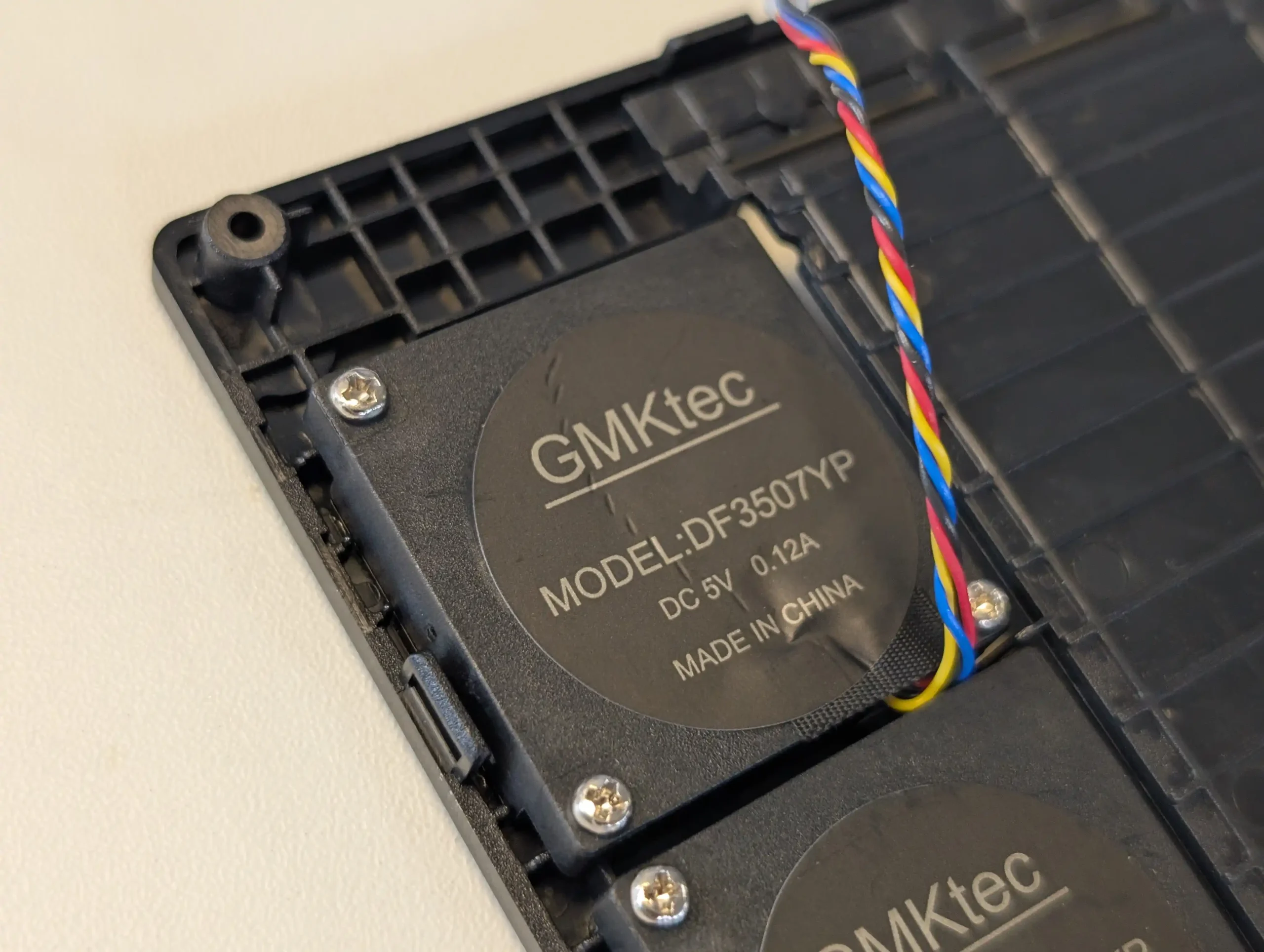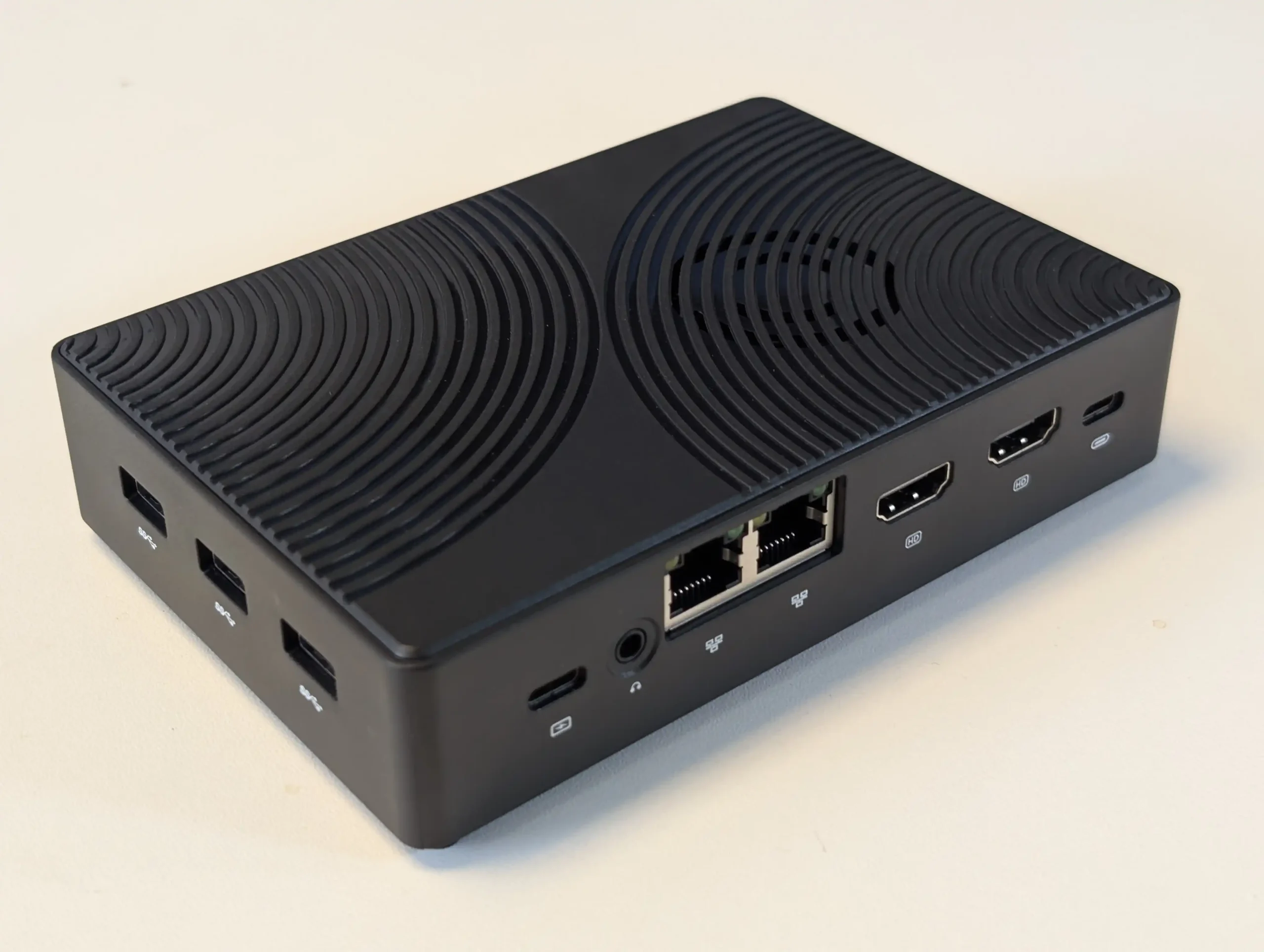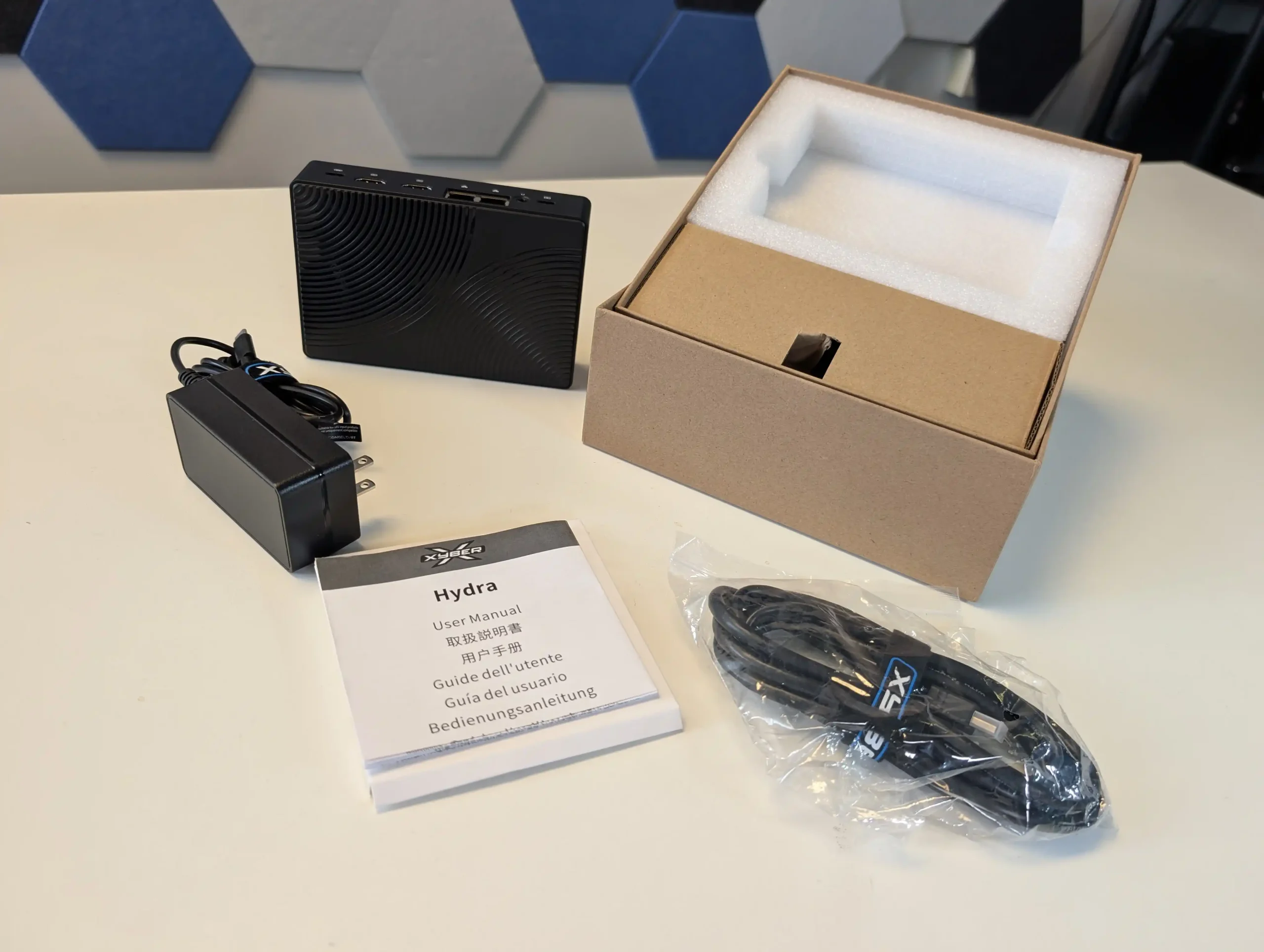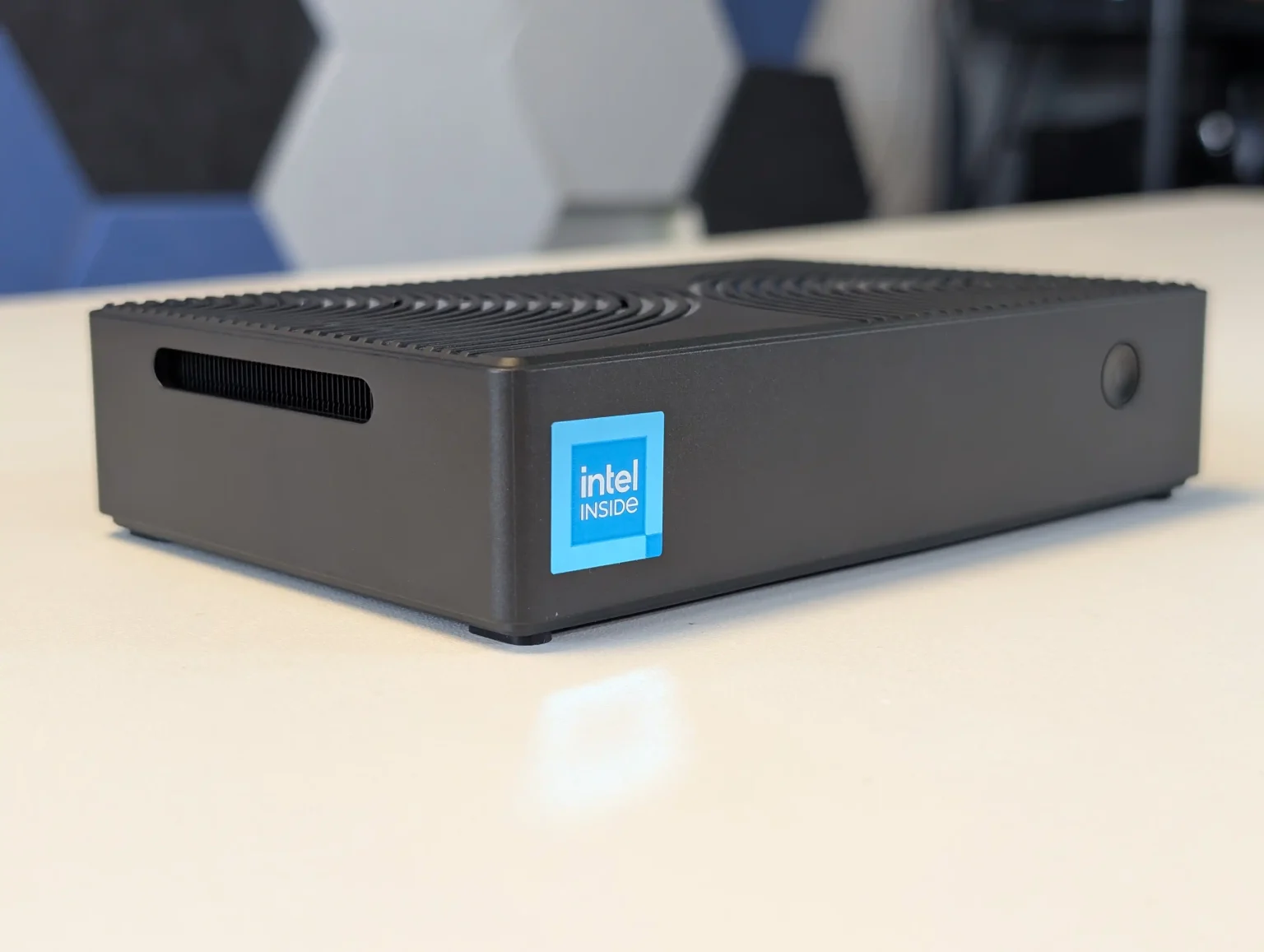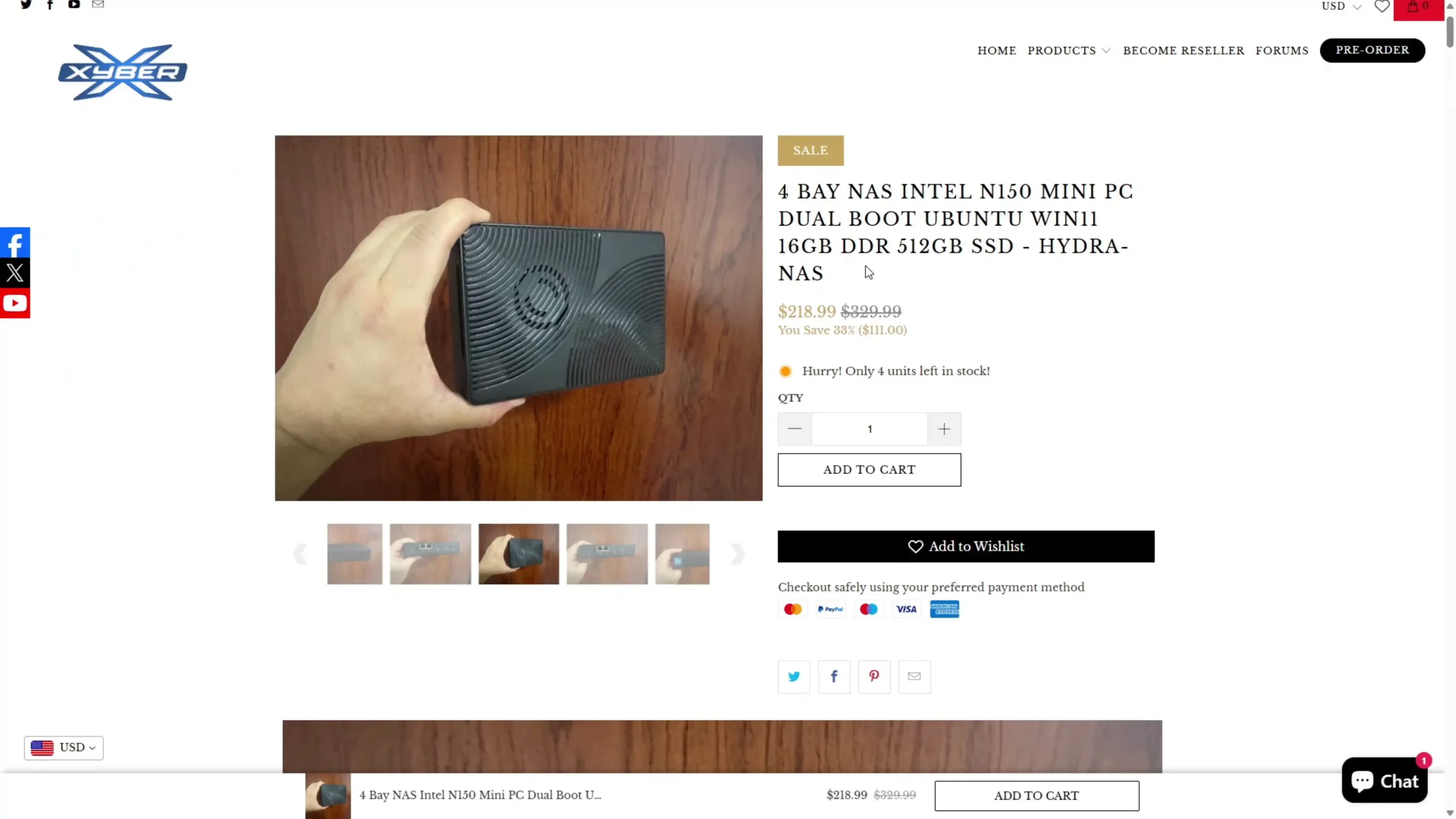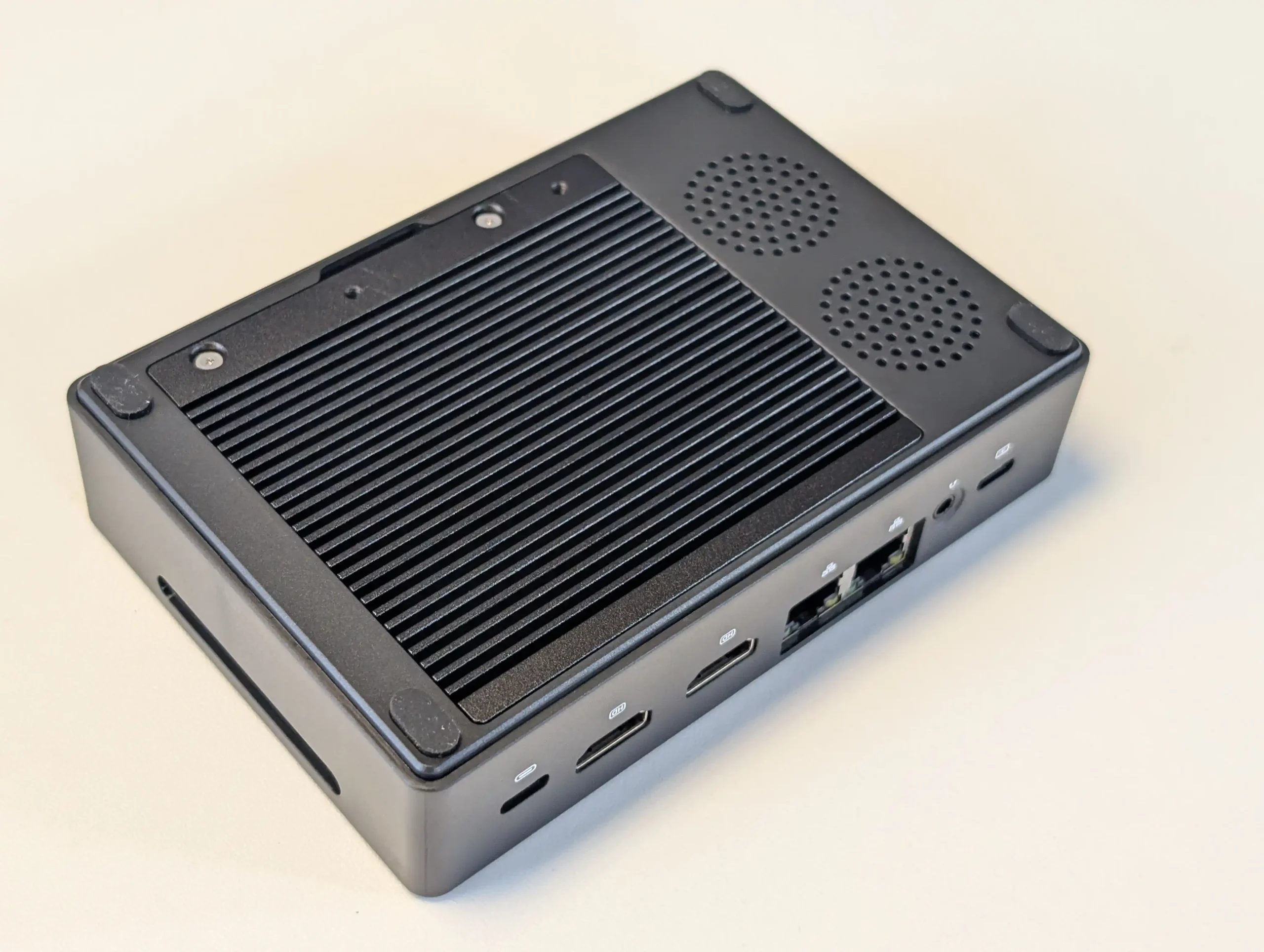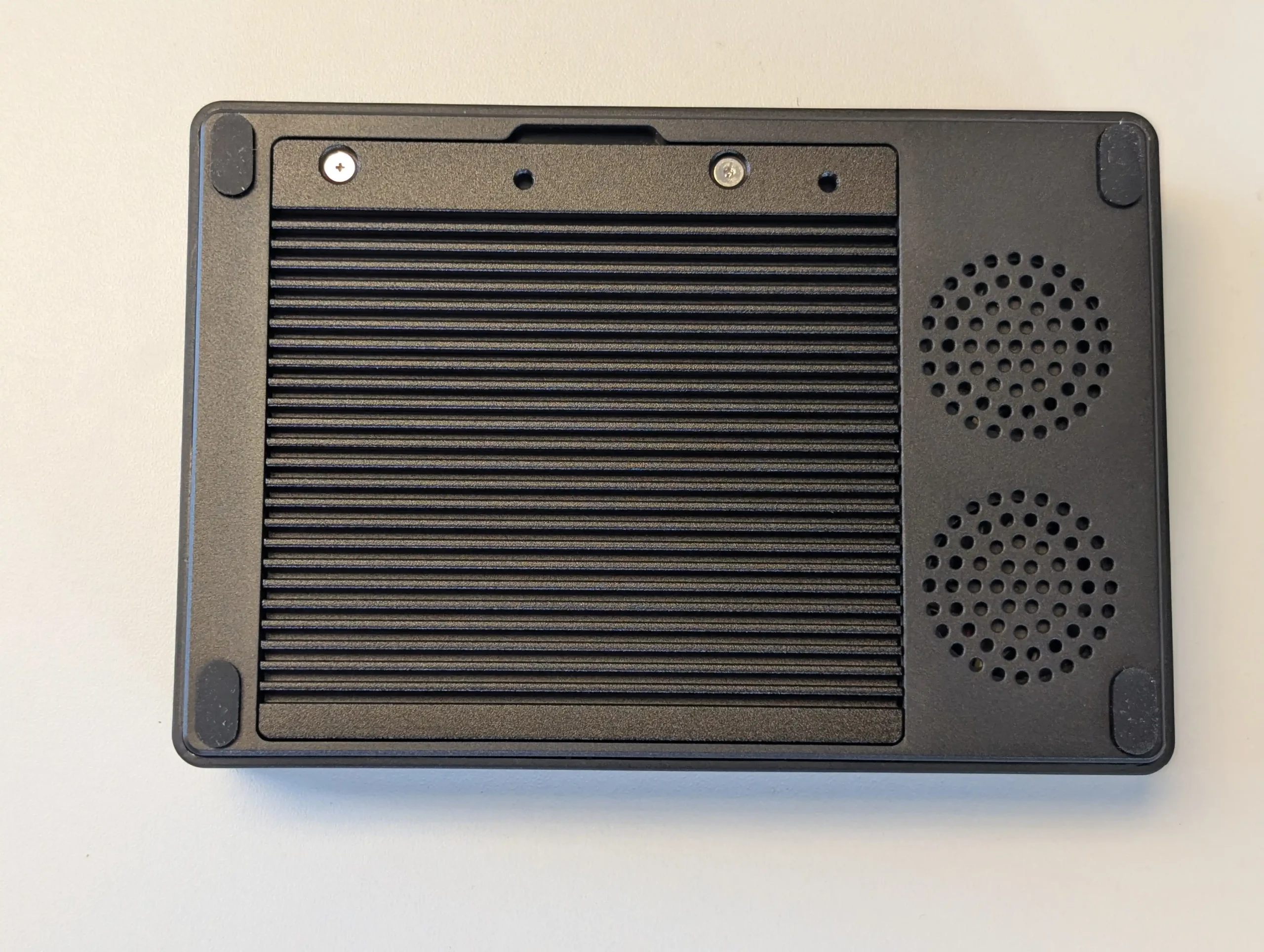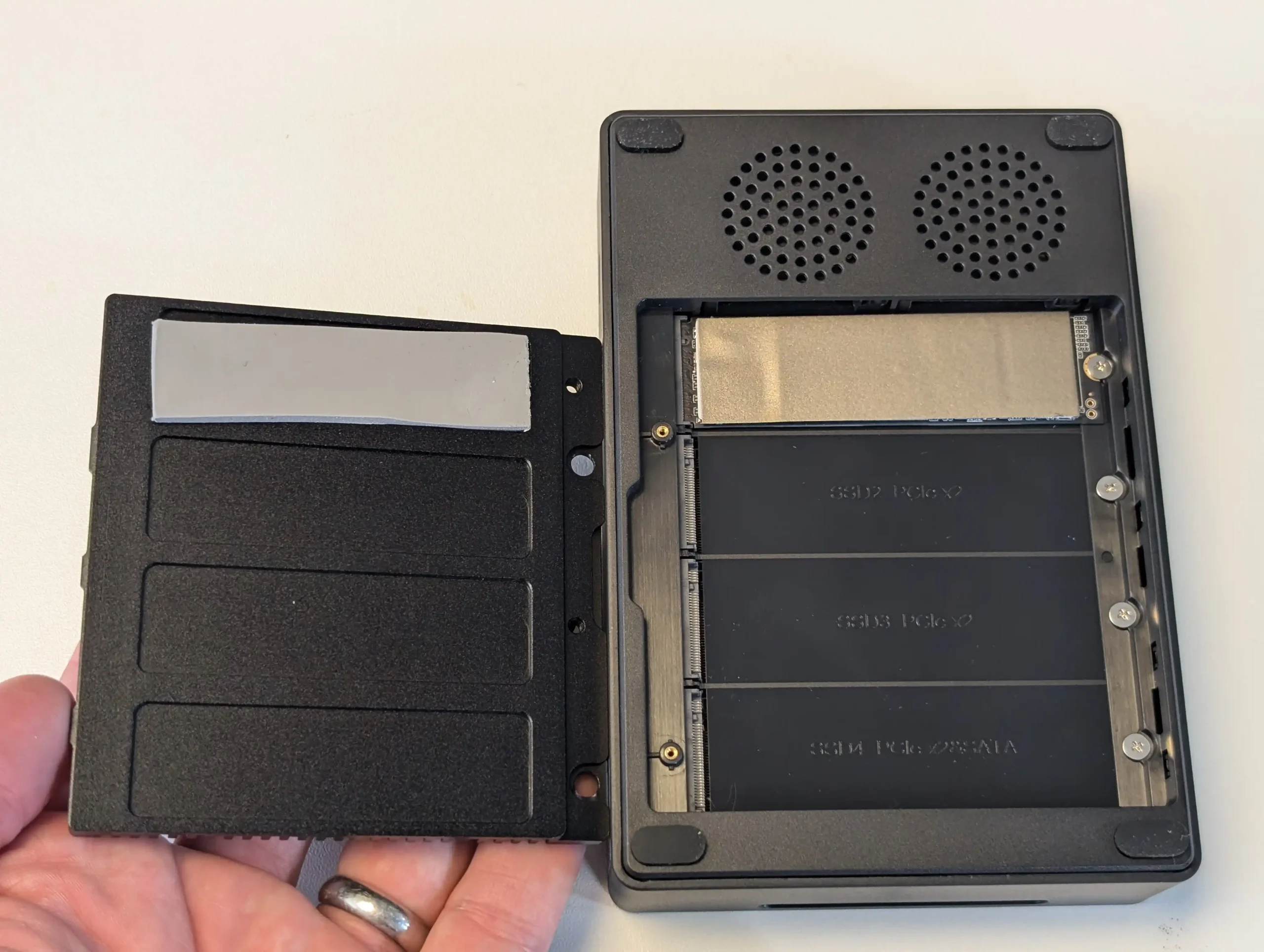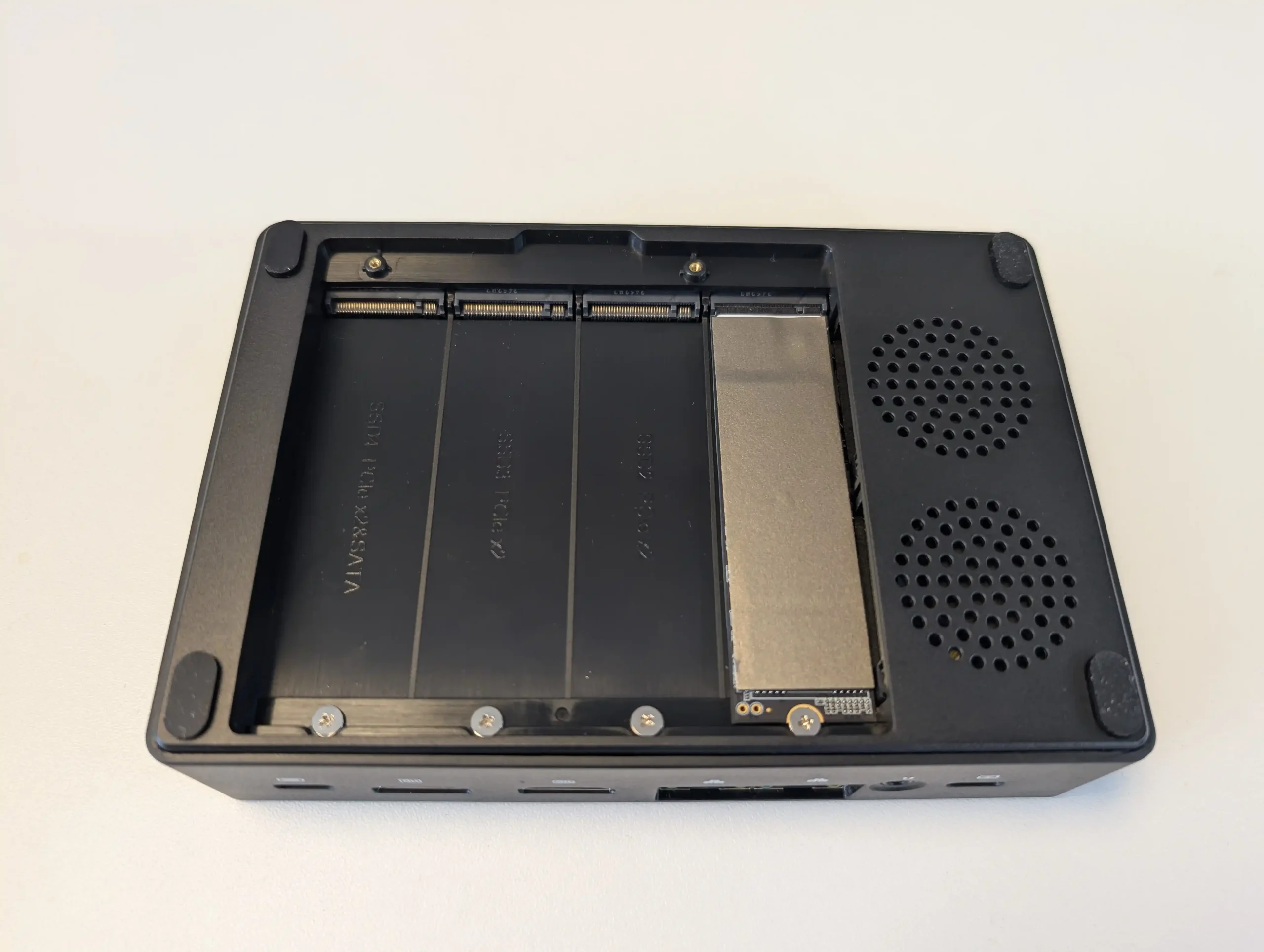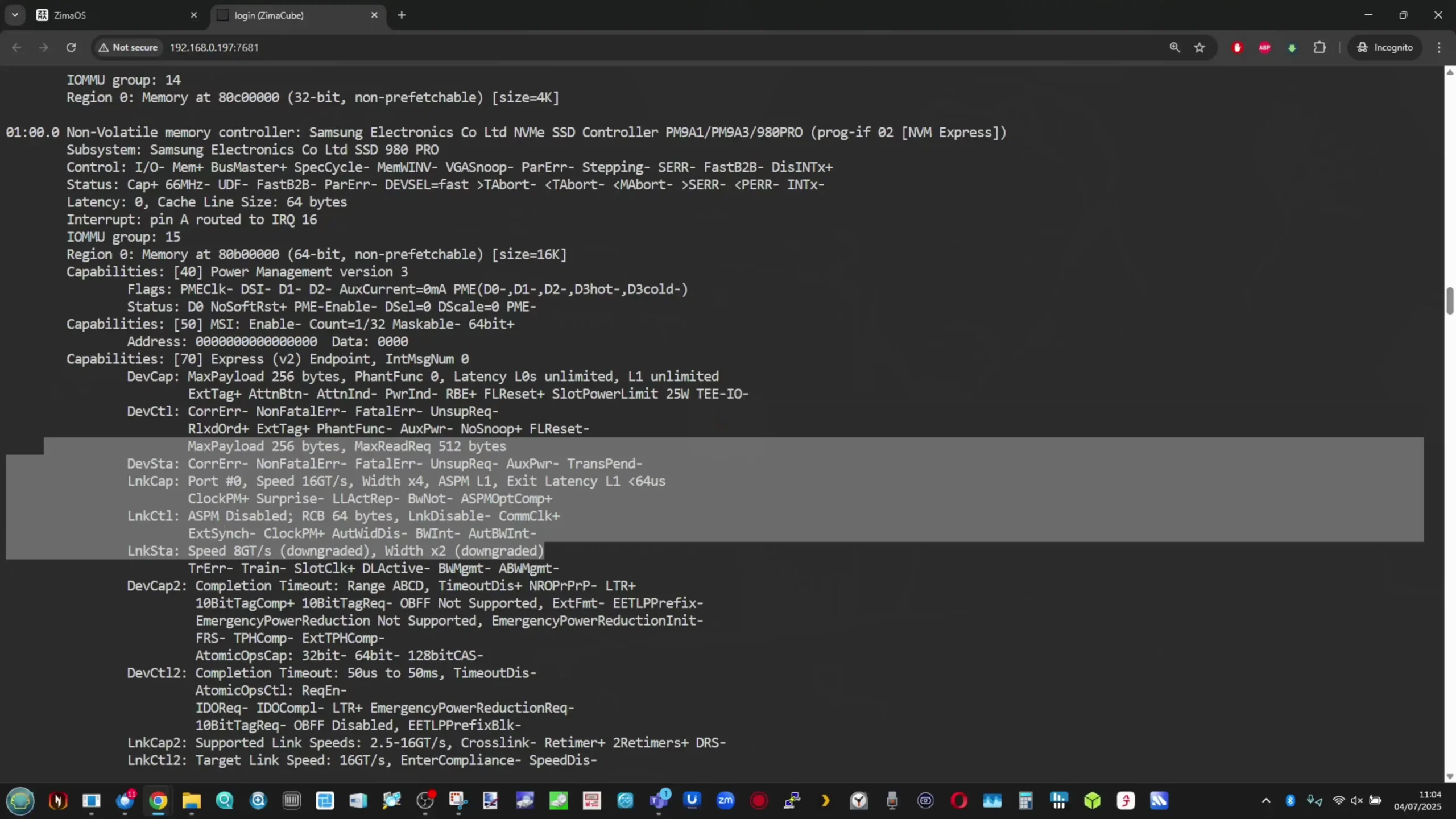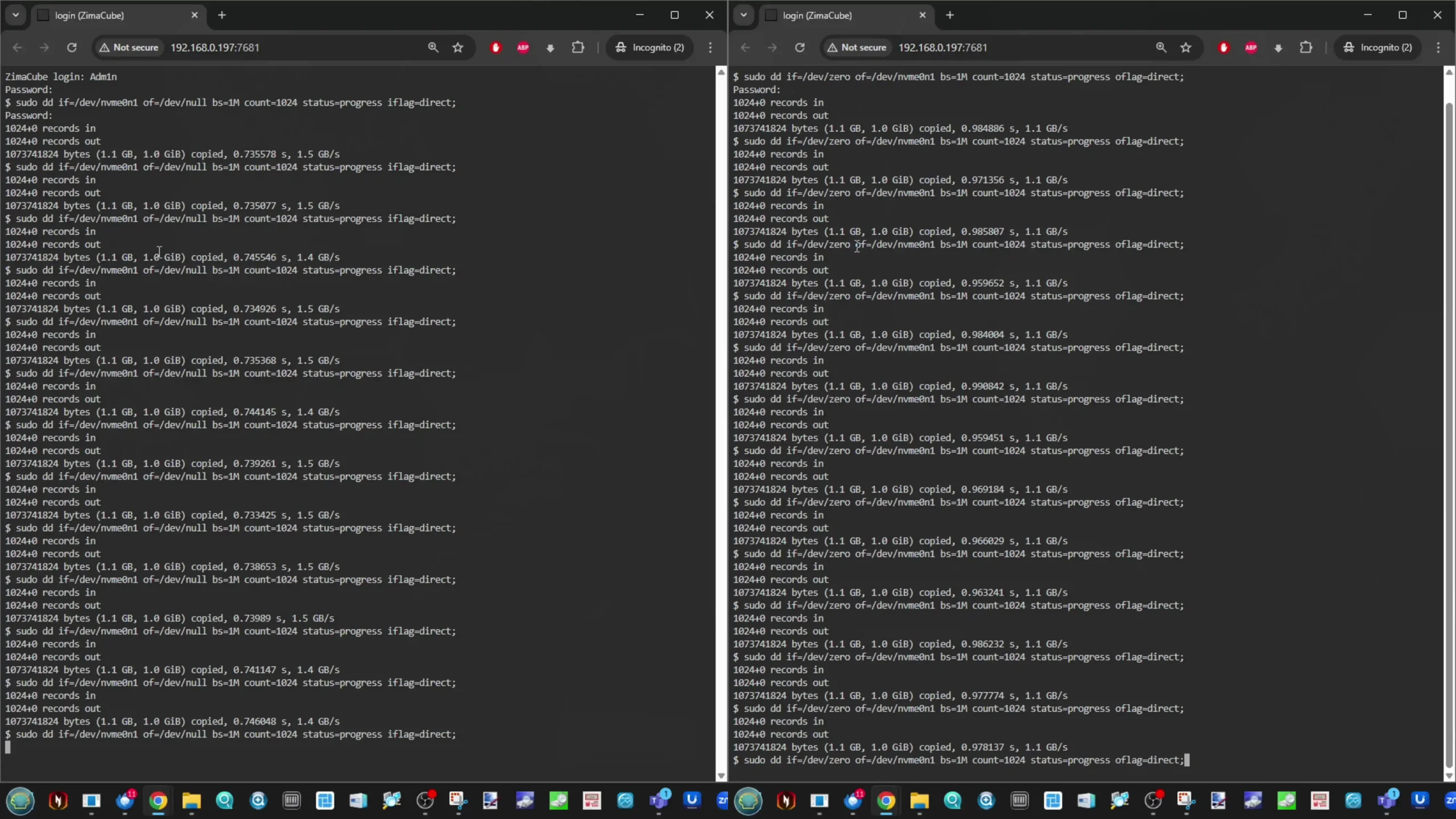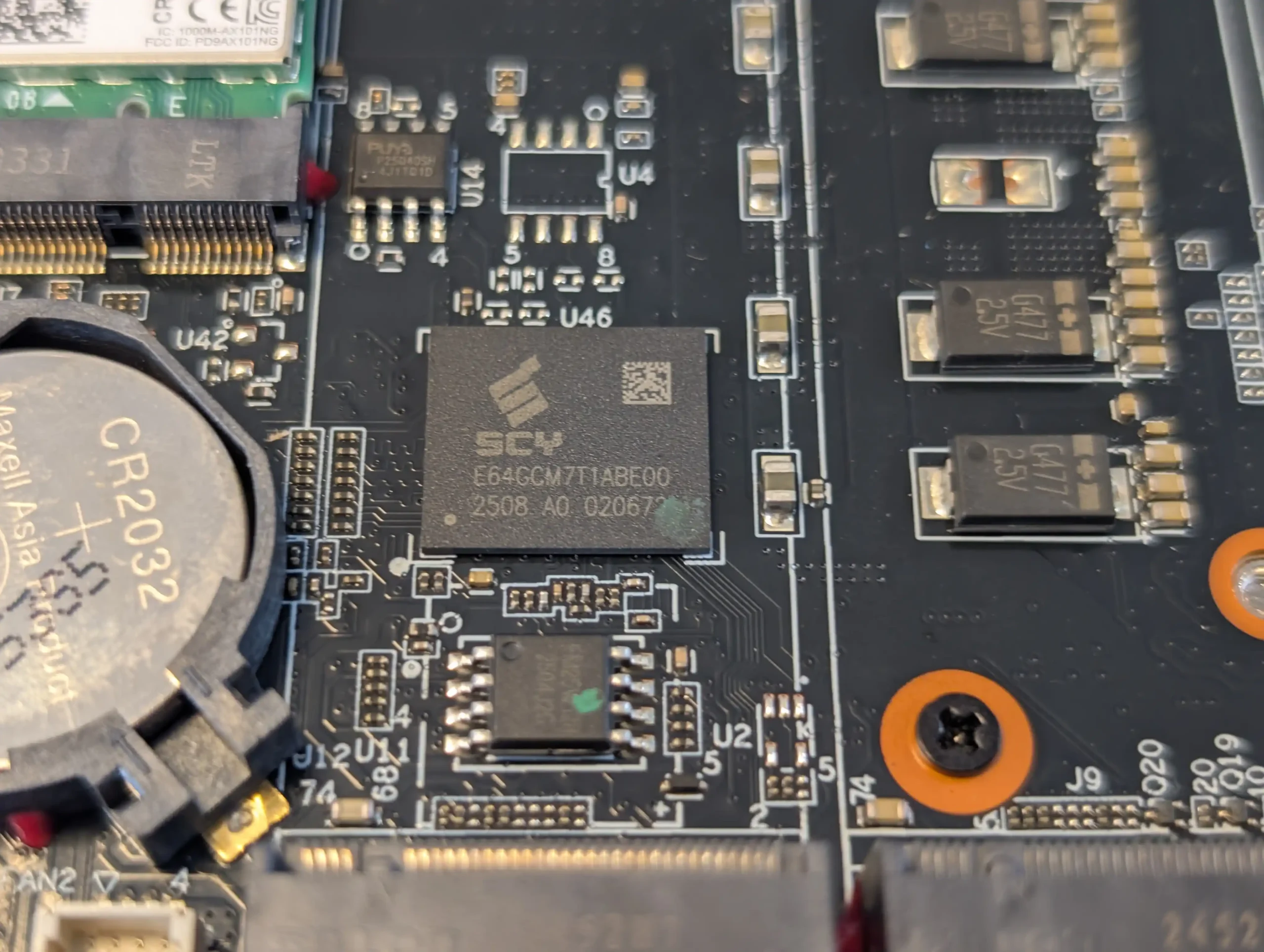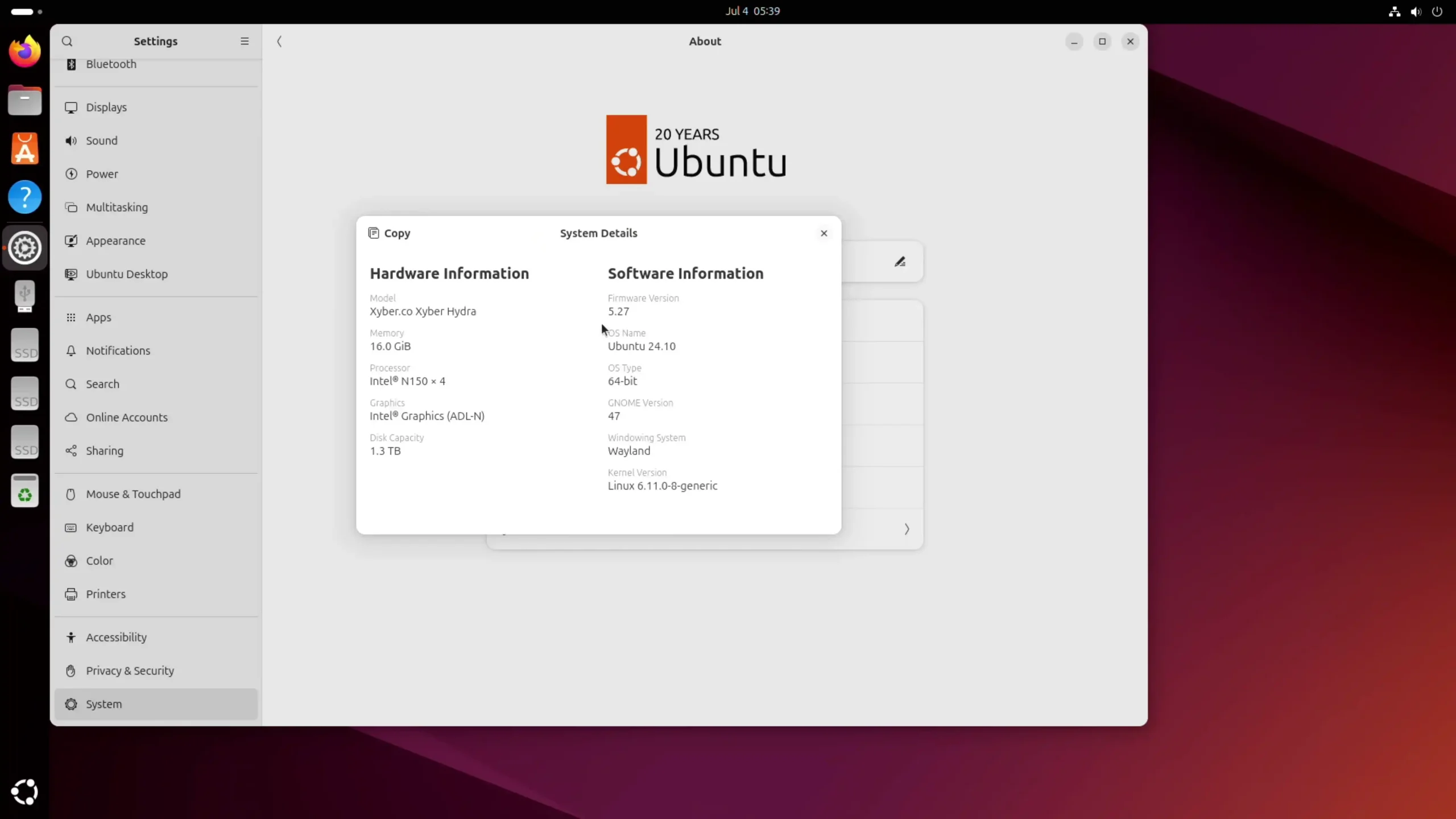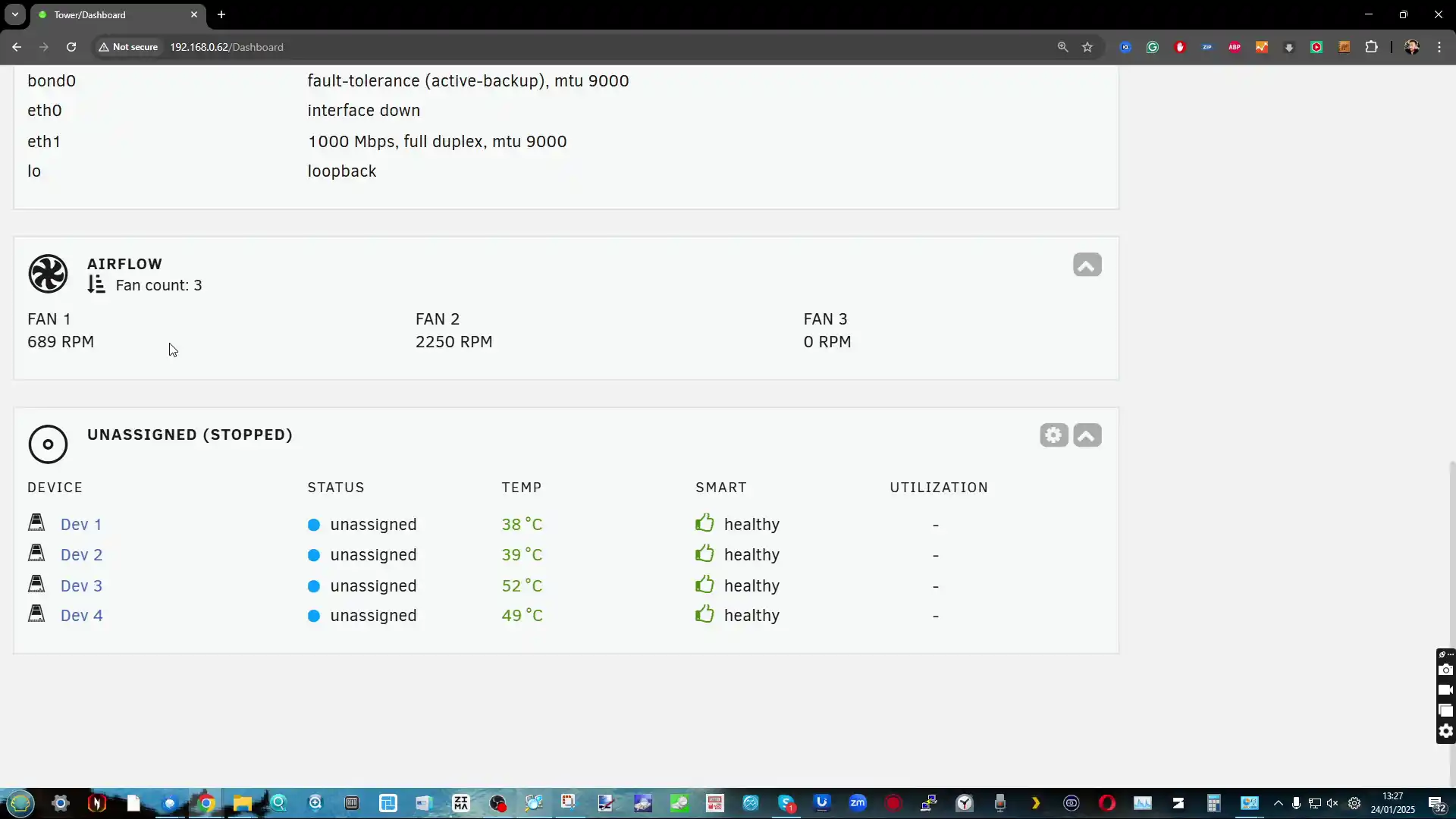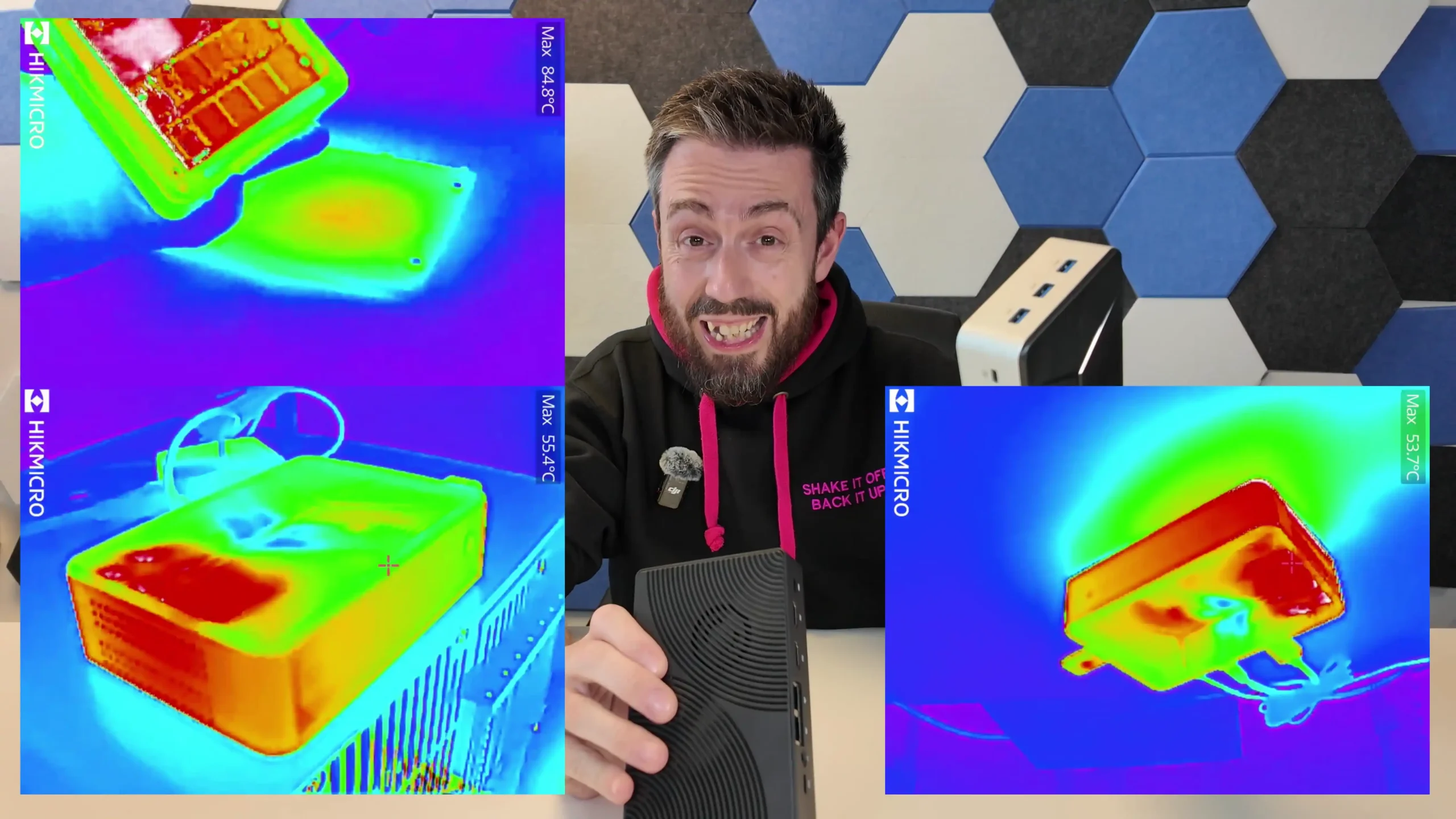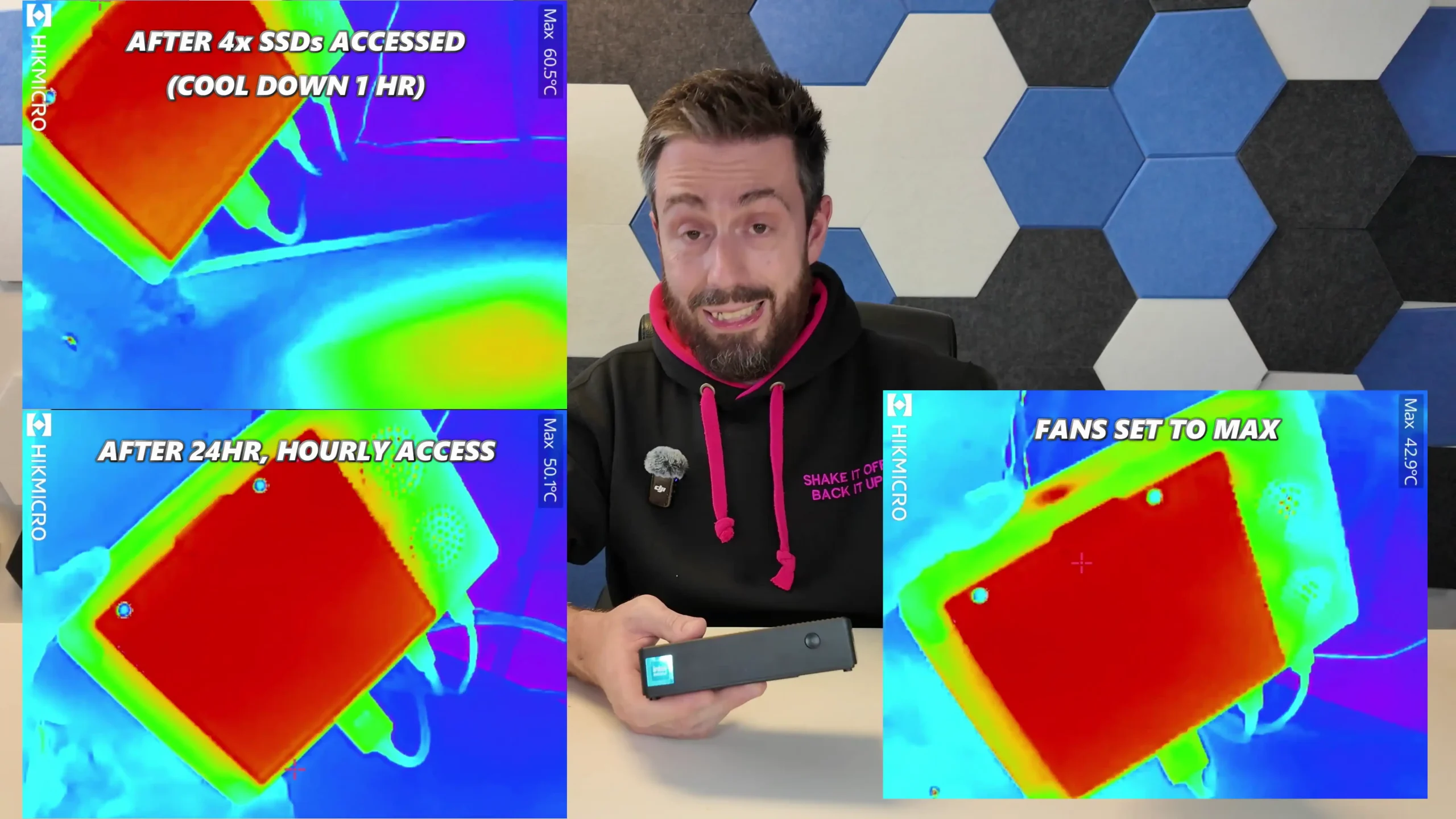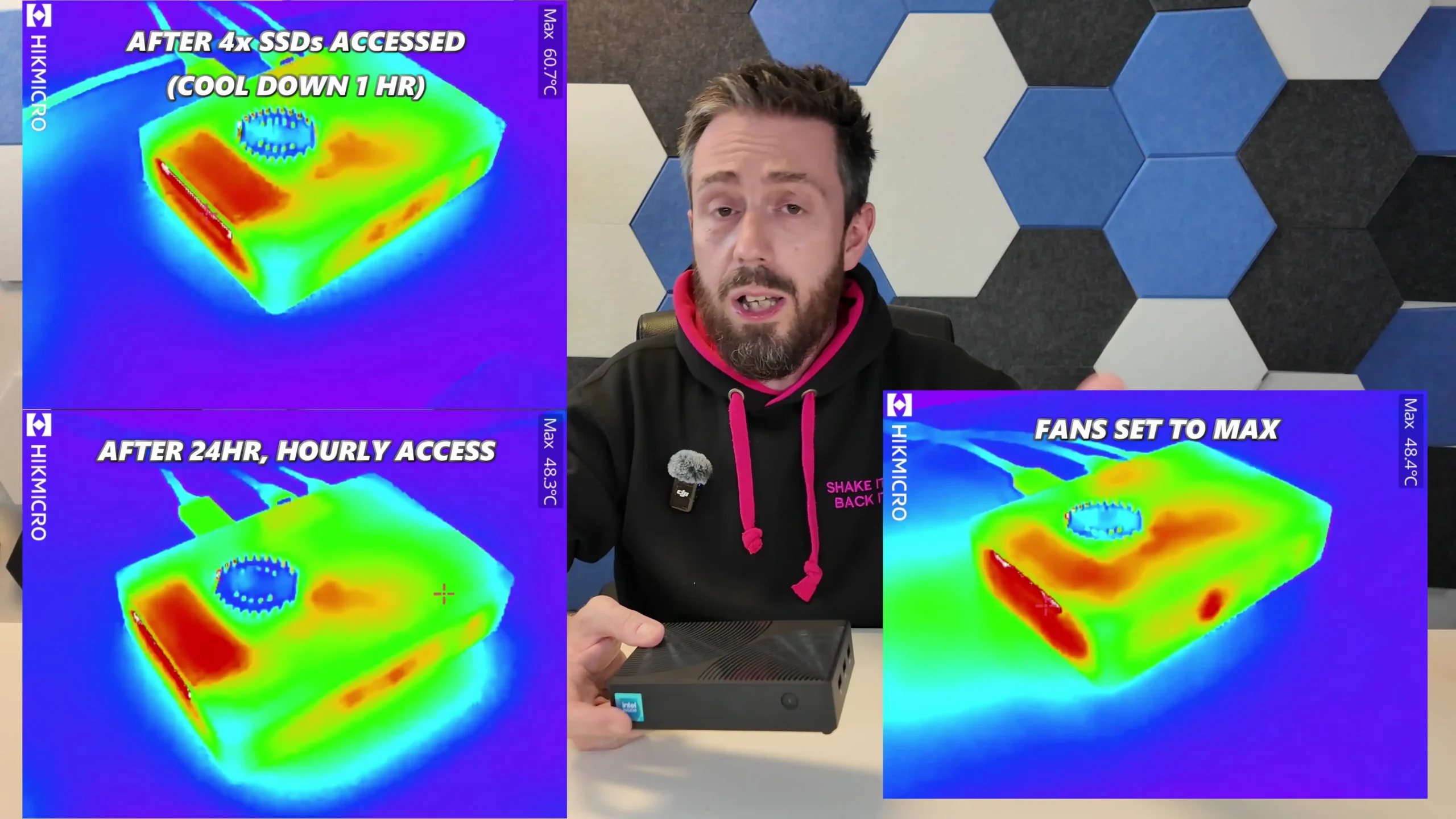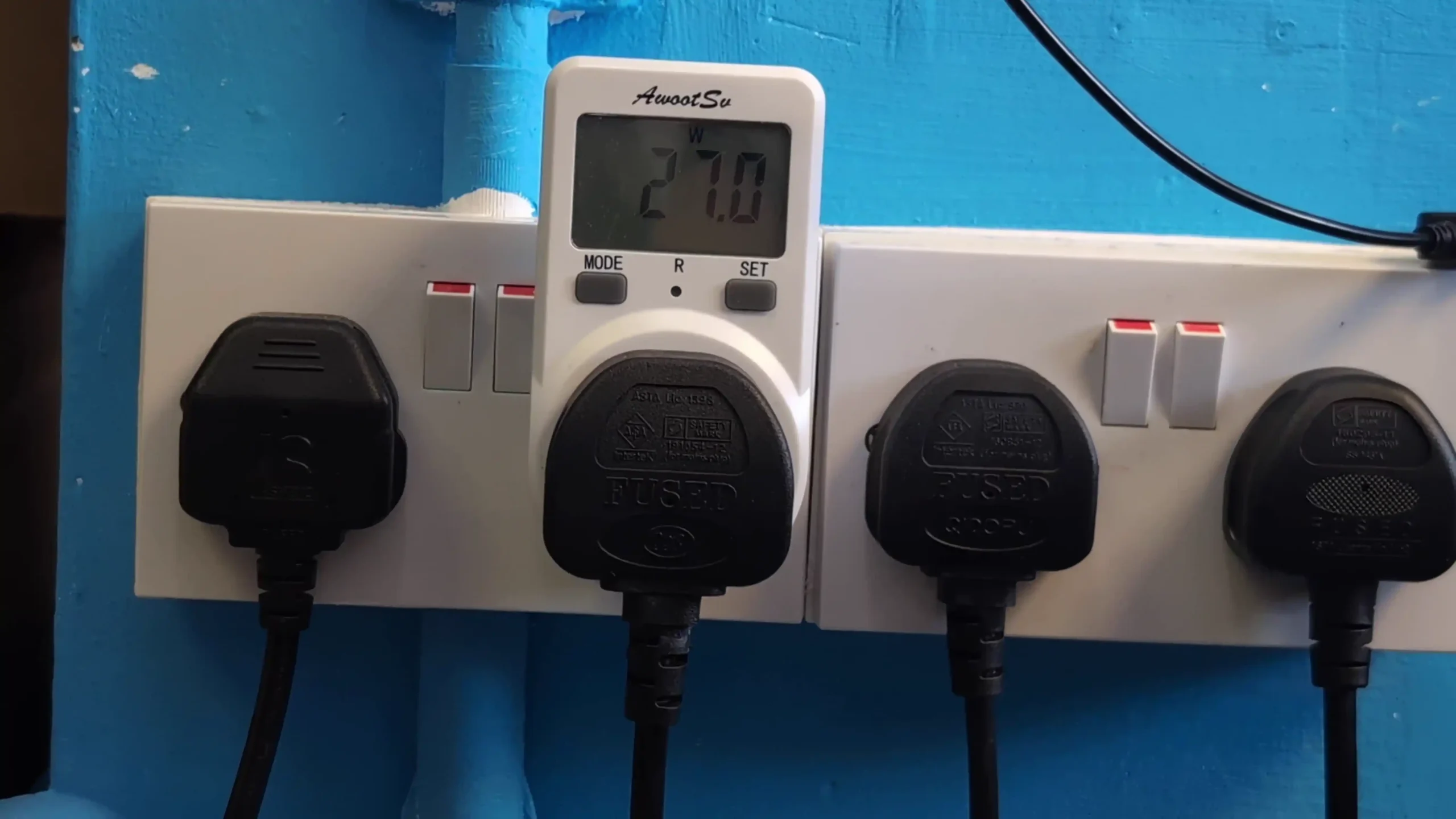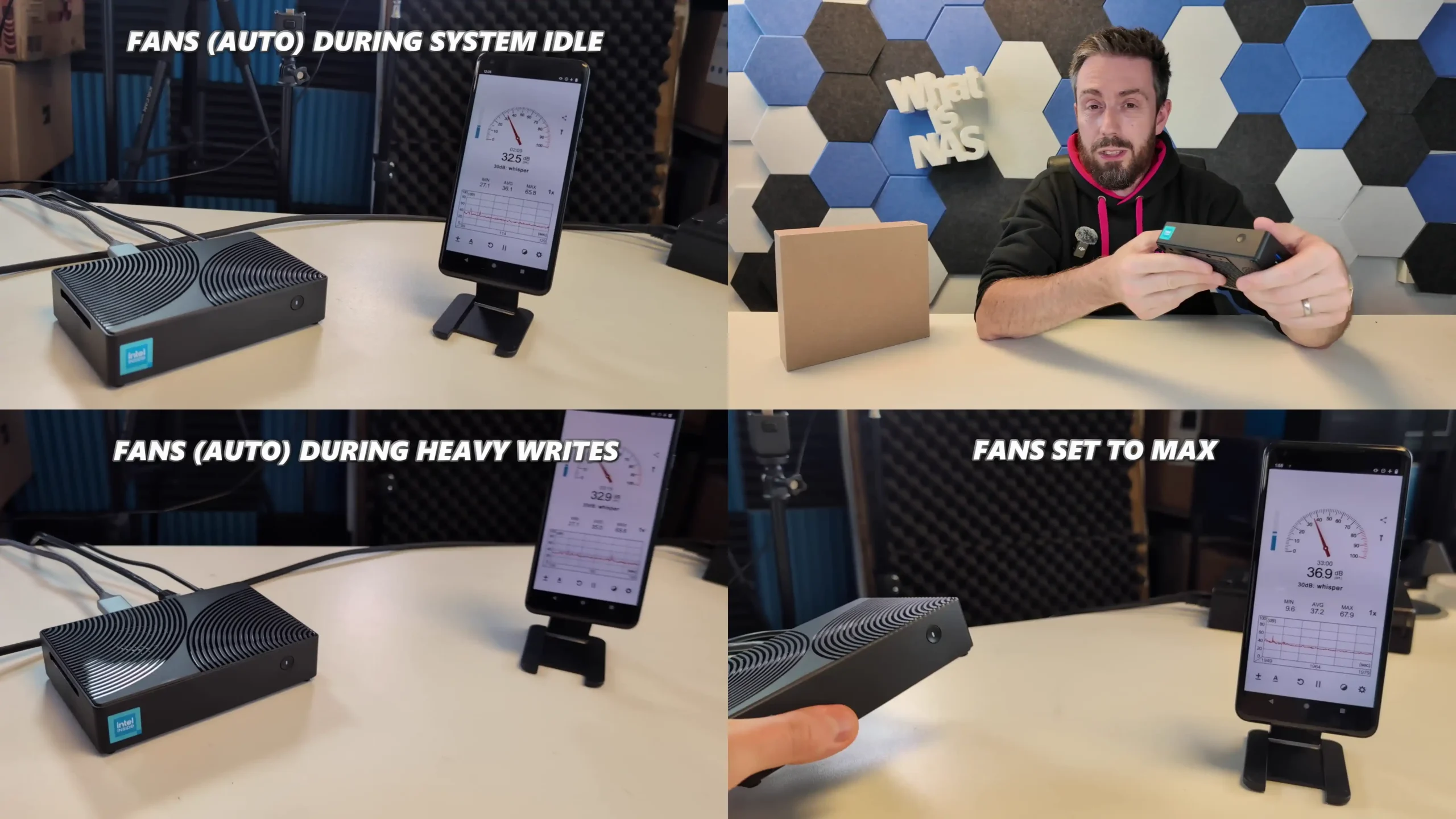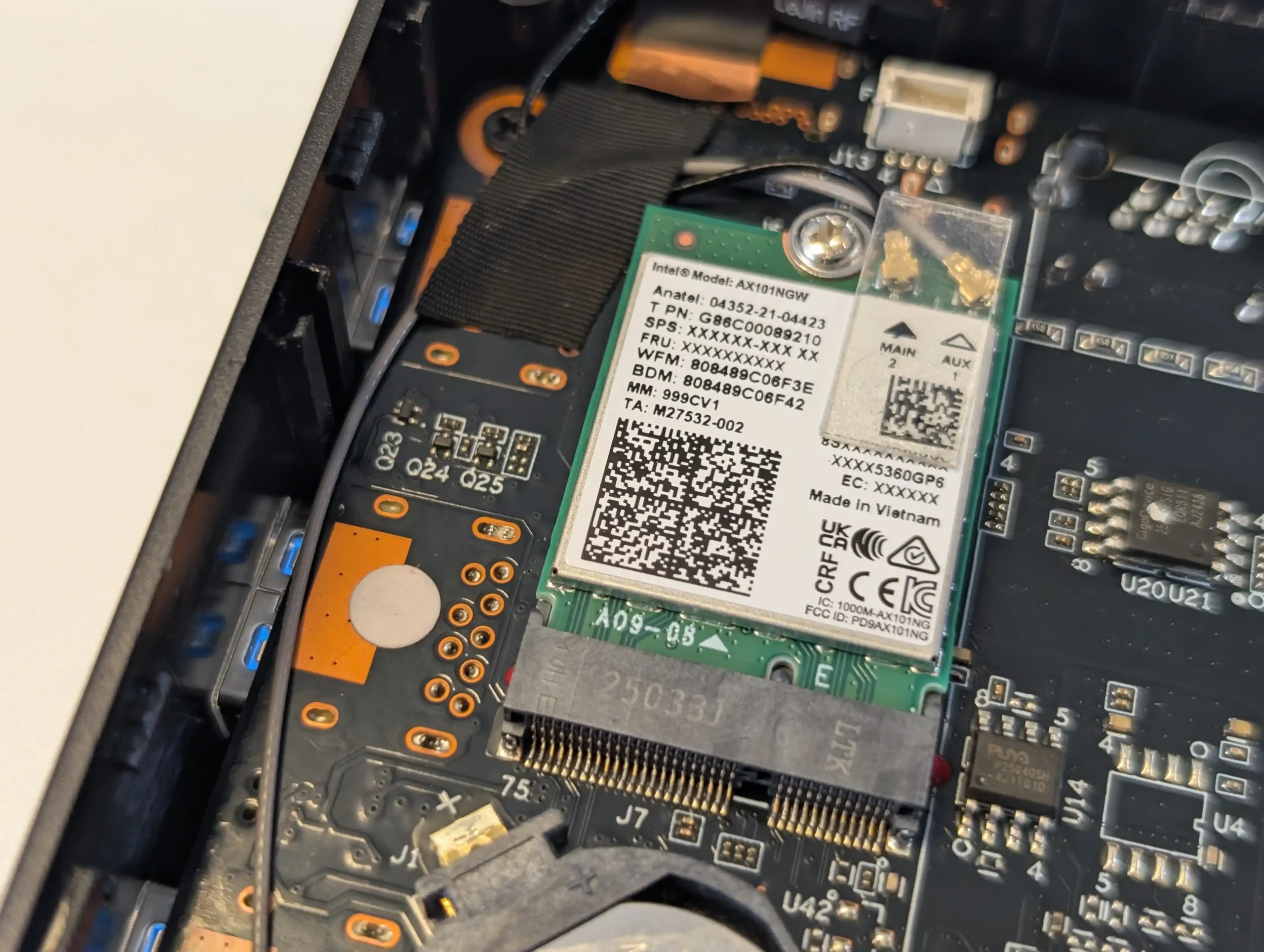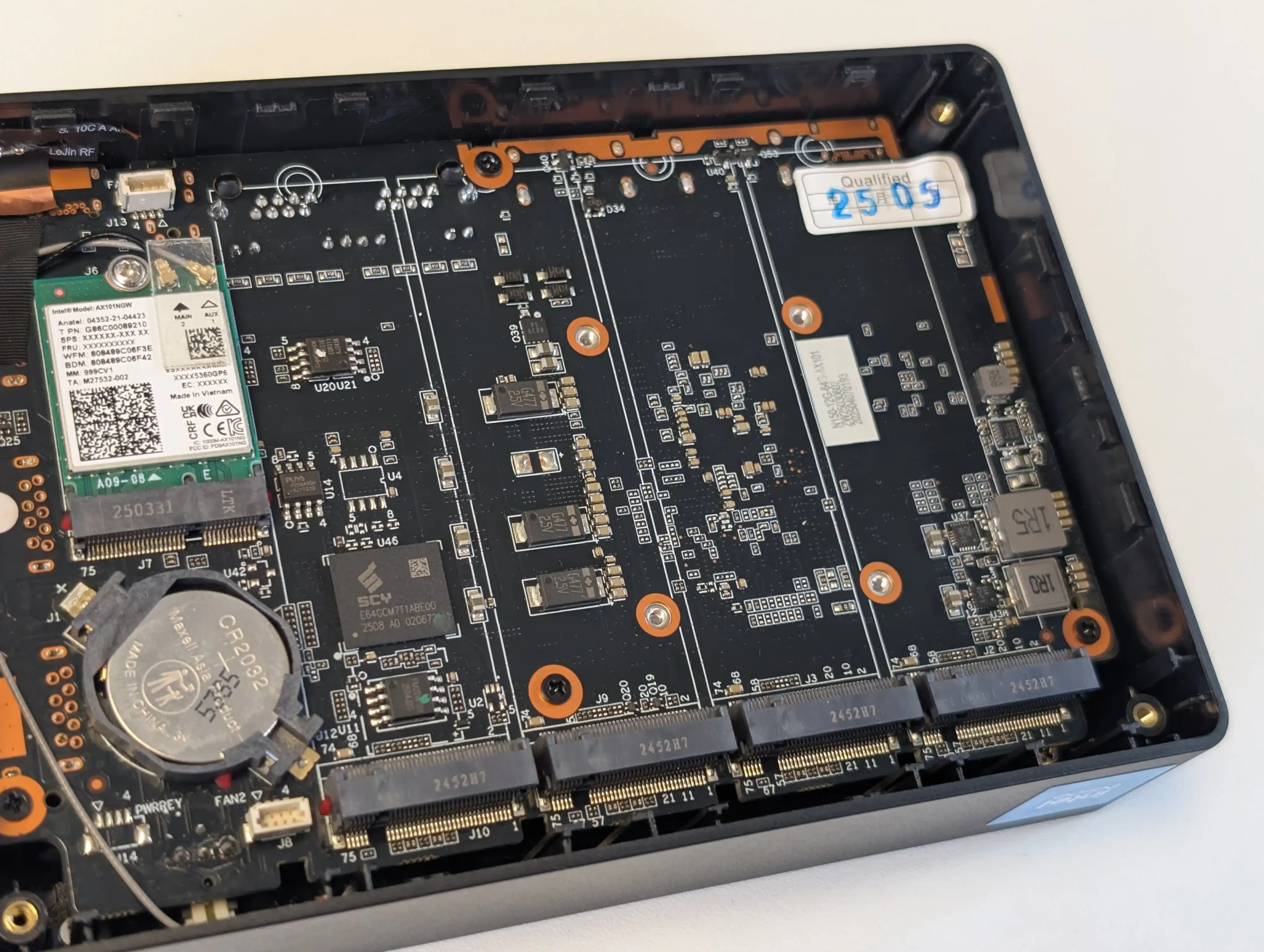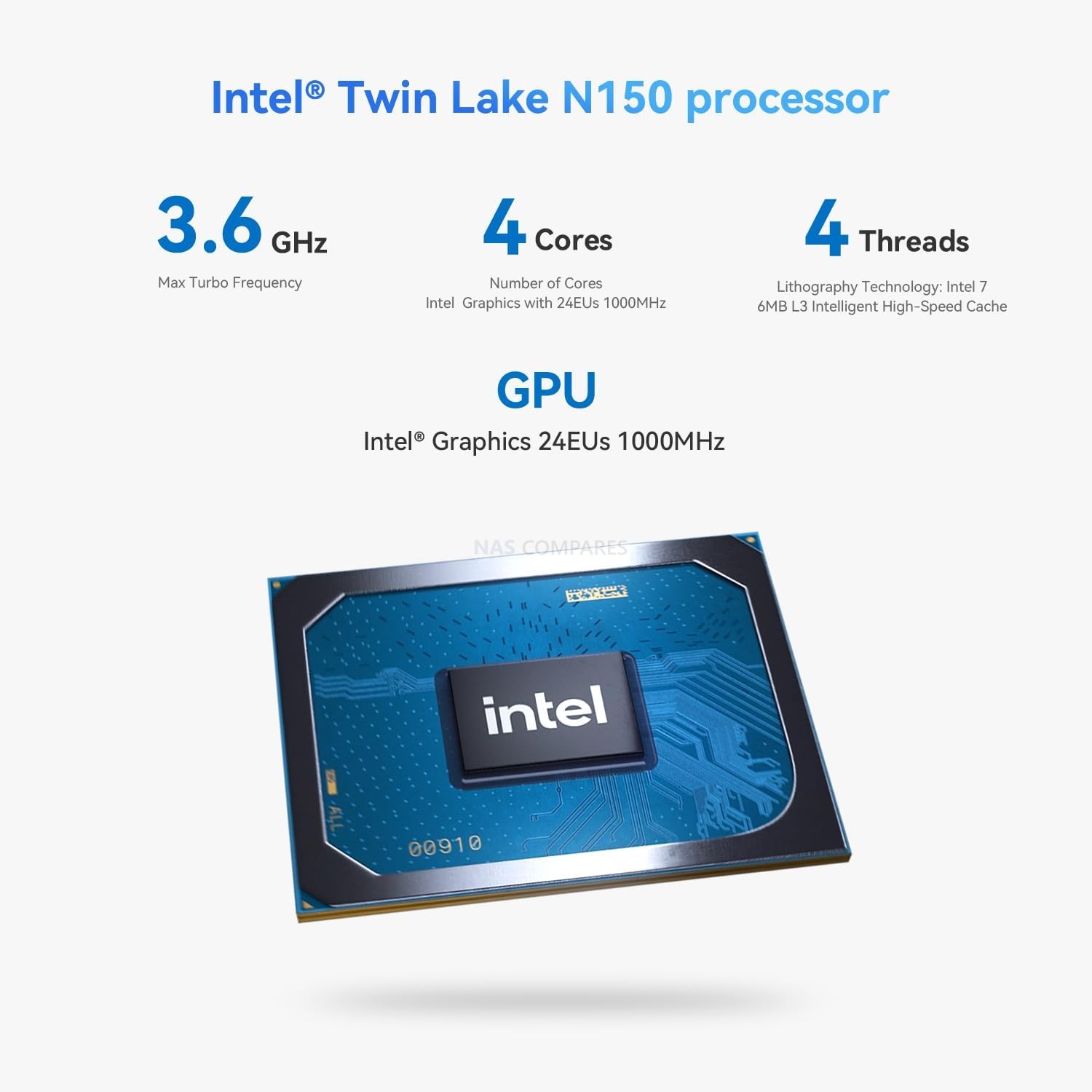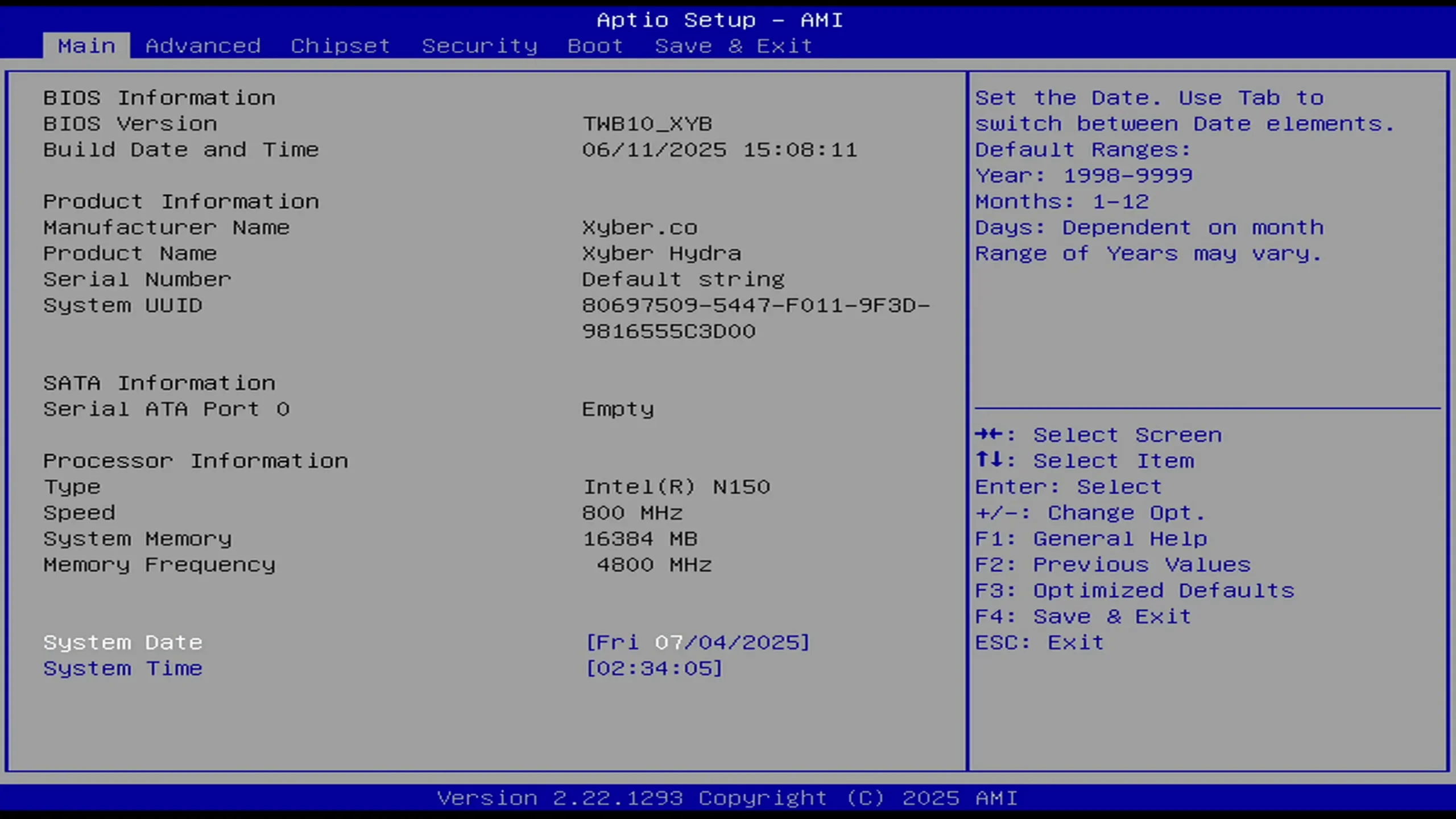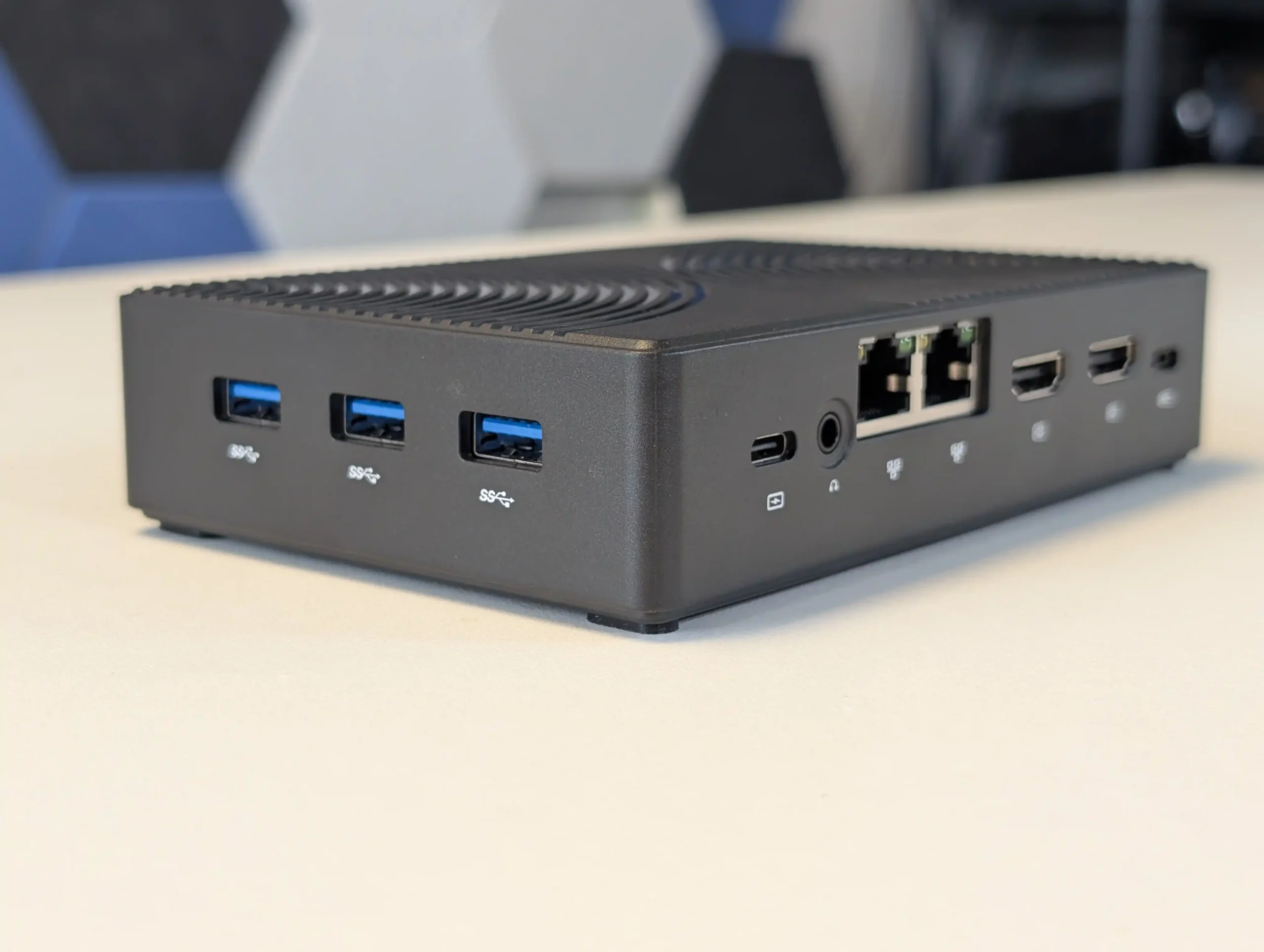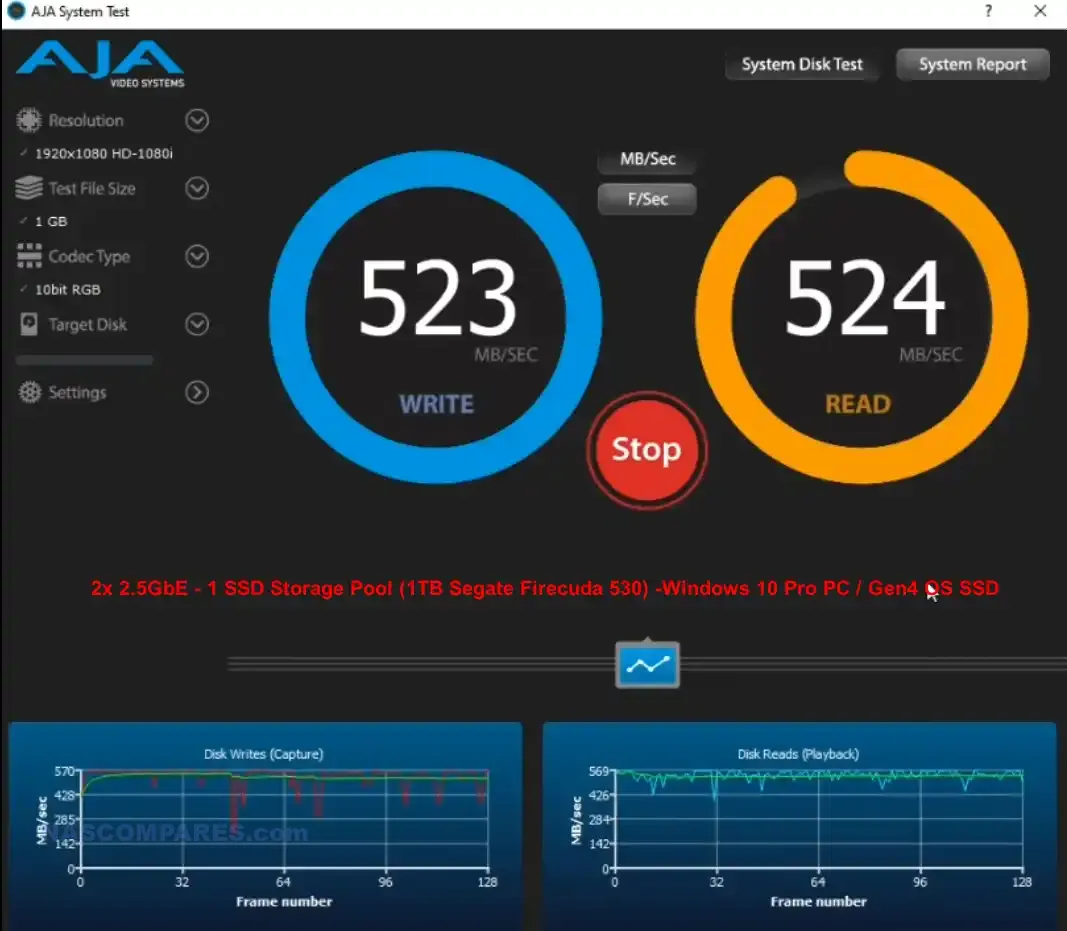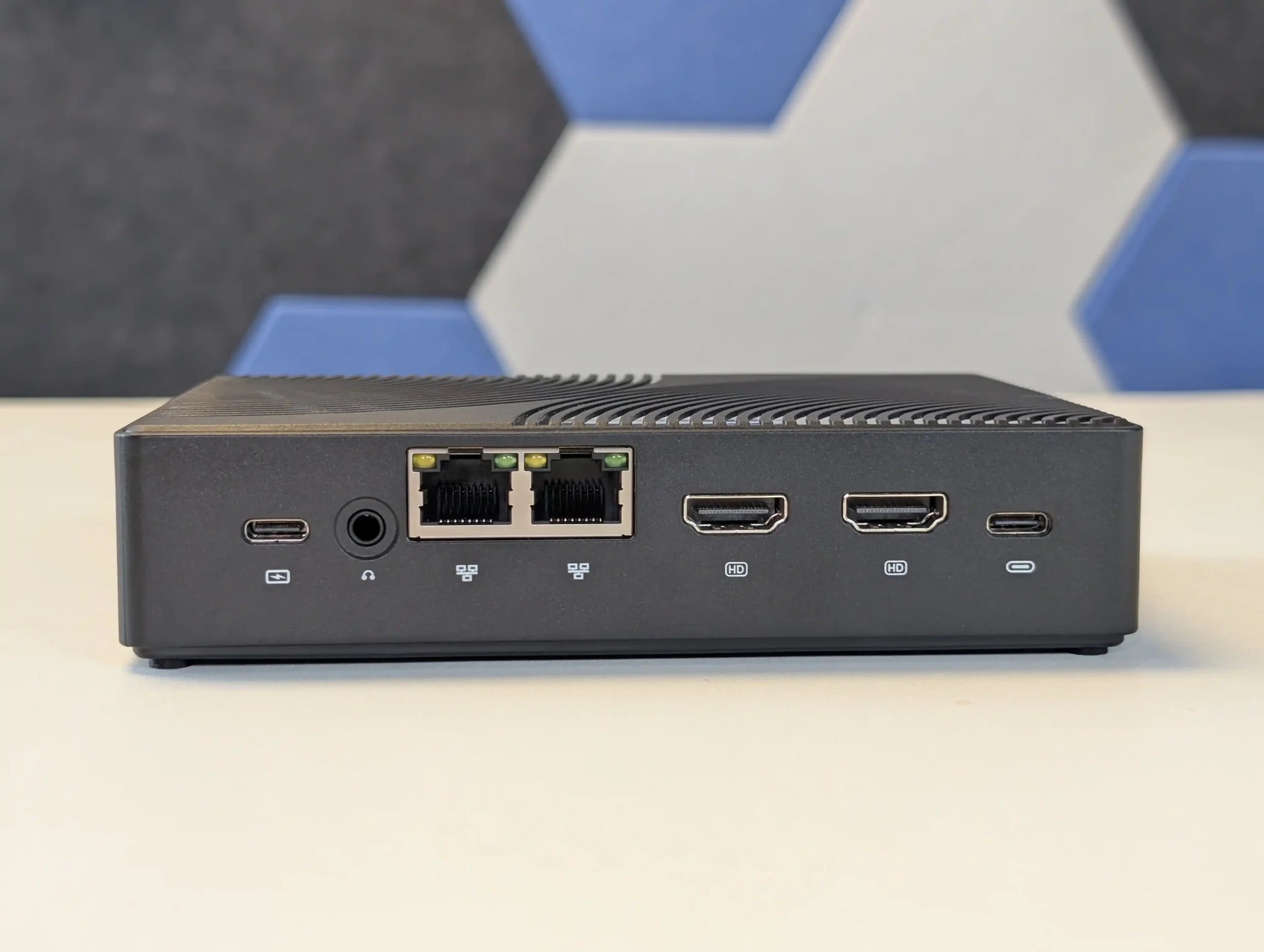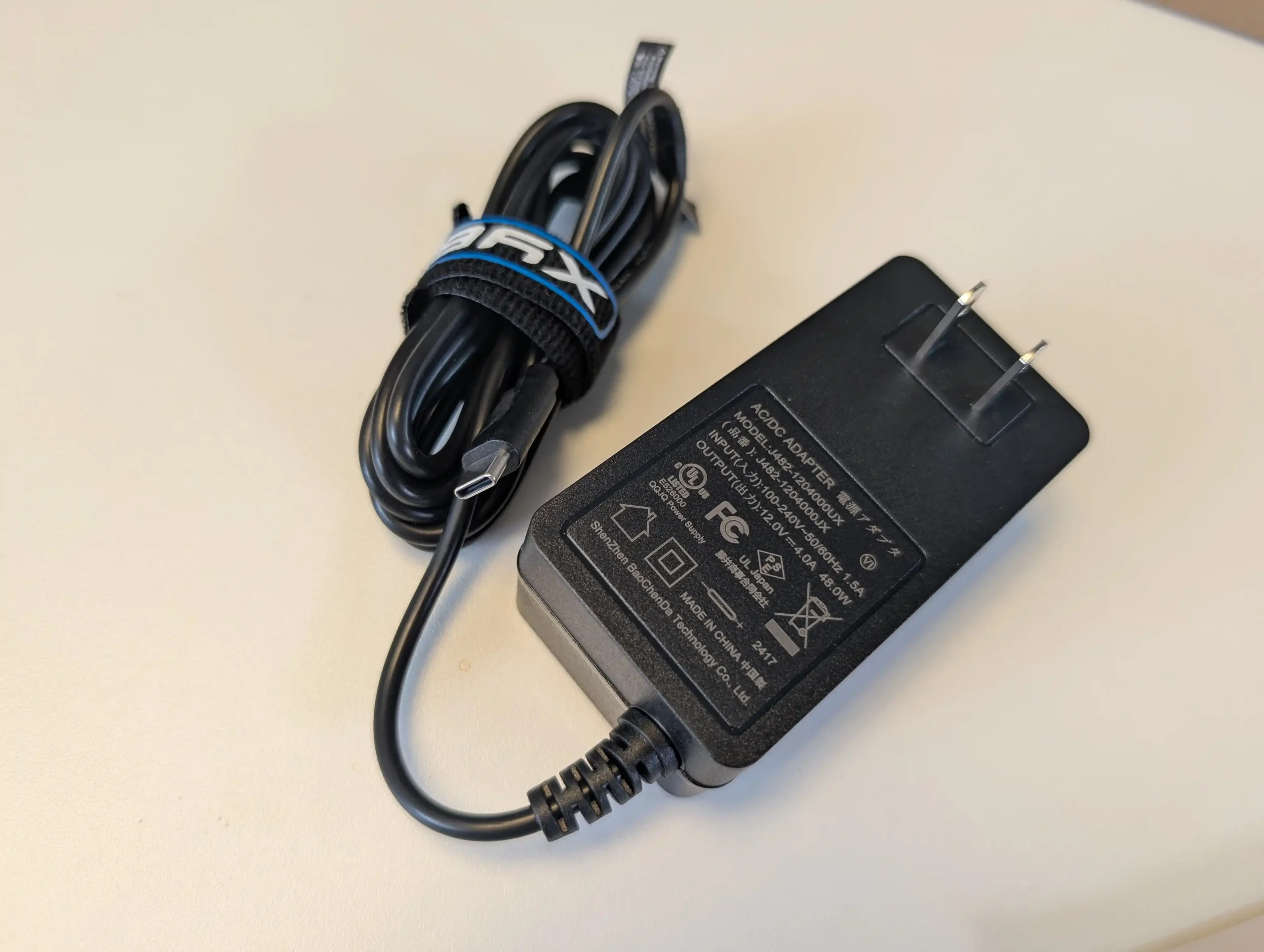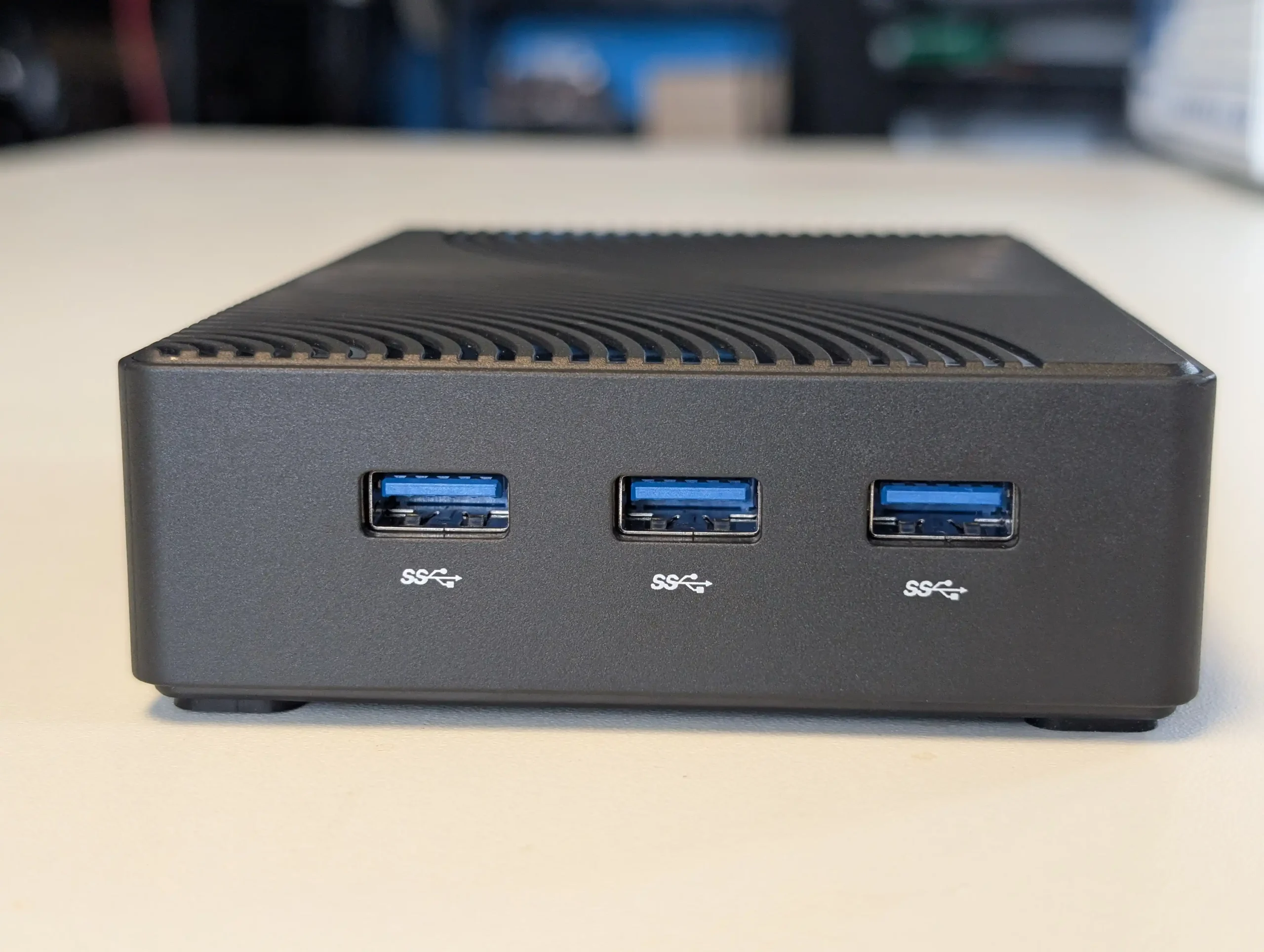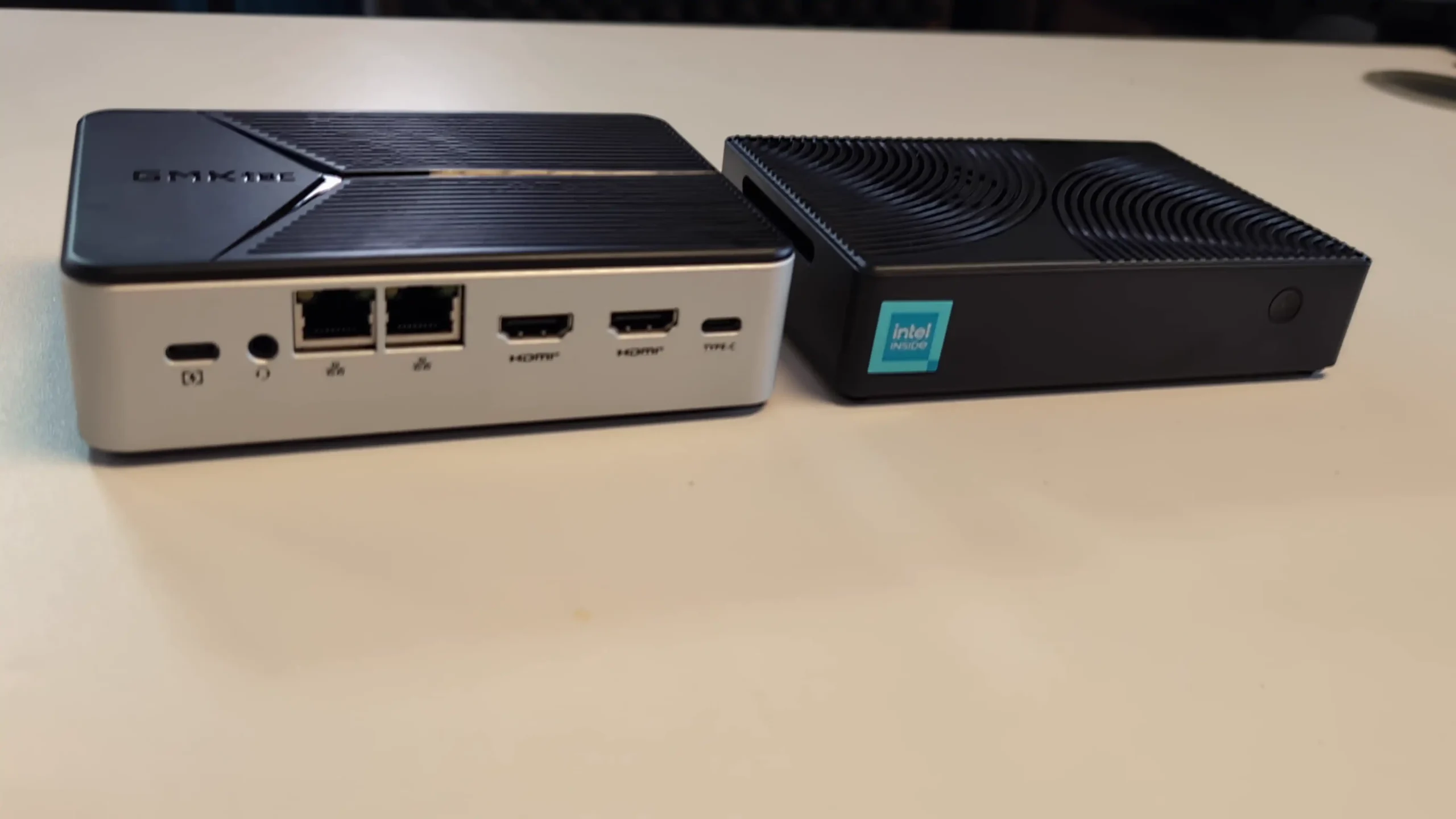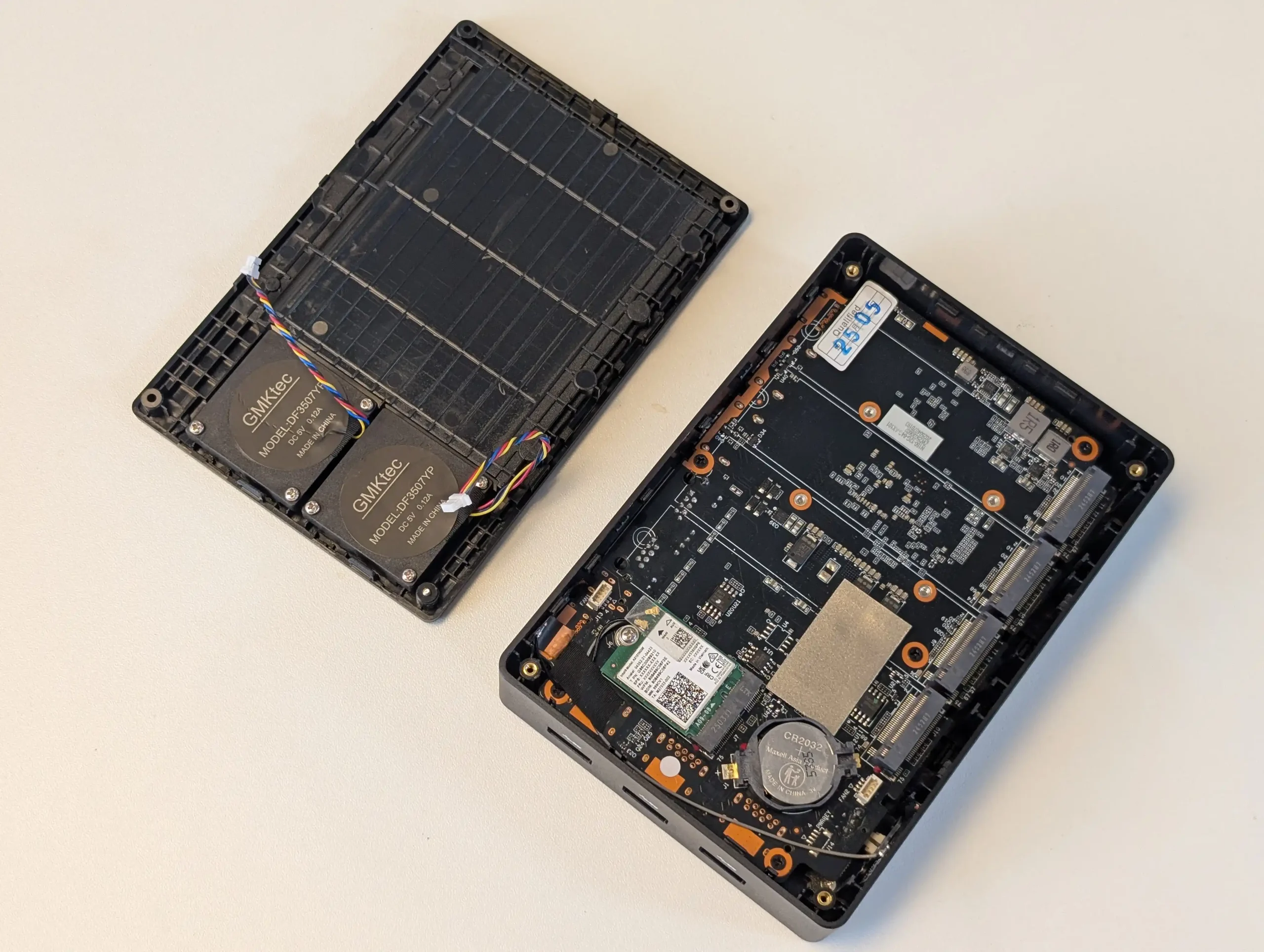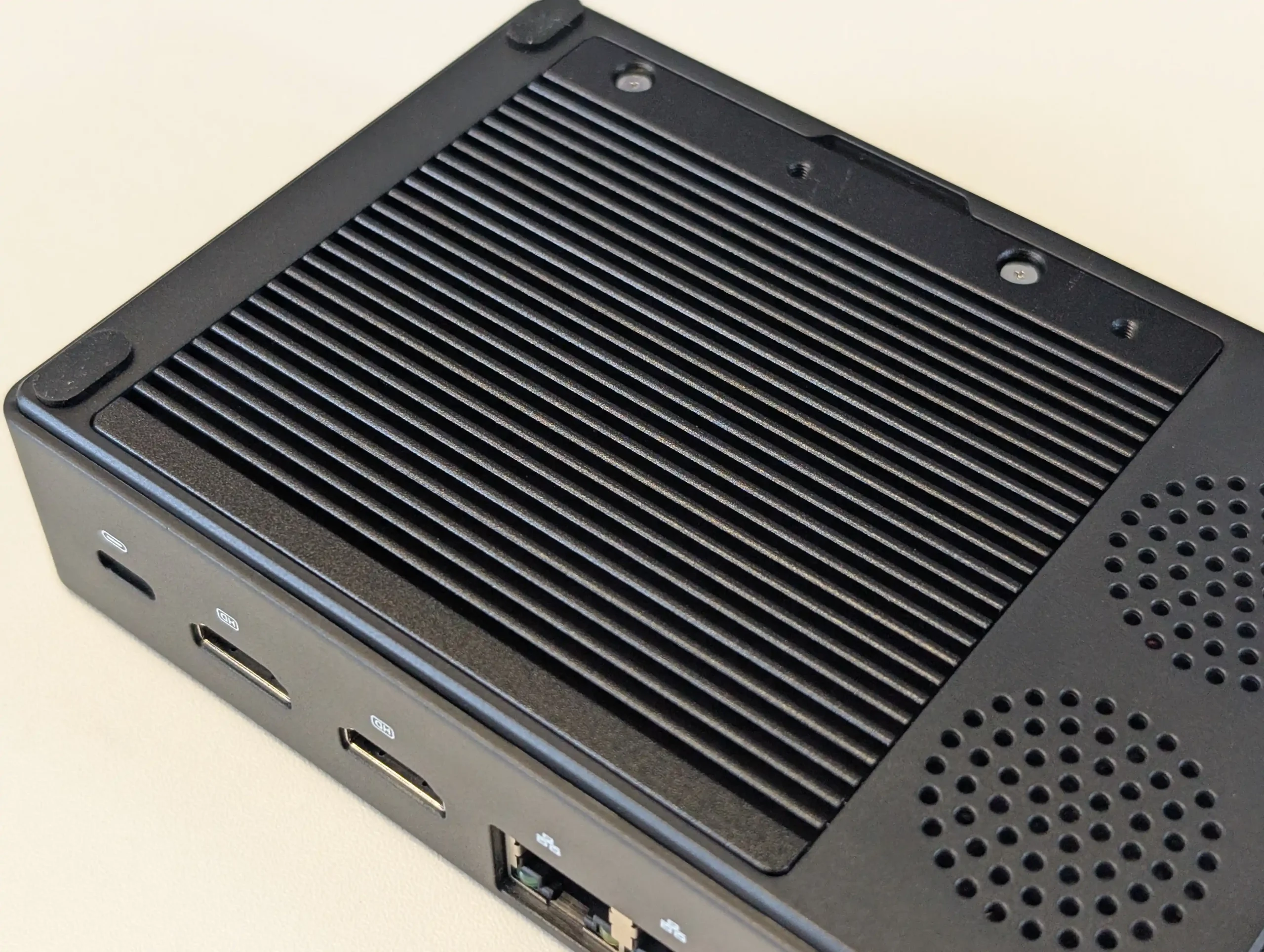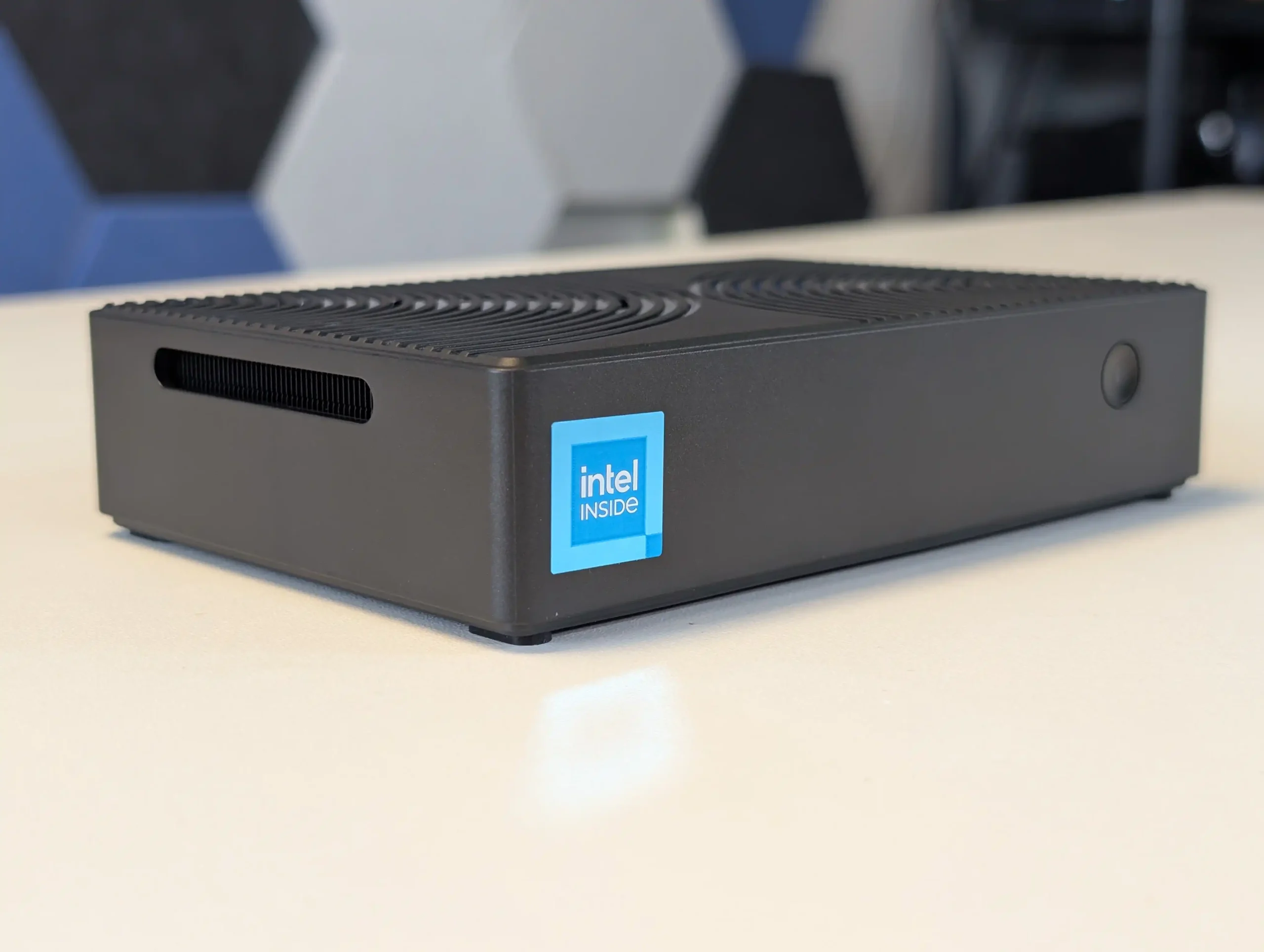GMKTec G9 Ver.2 NAS Review – Cooler Now?
GMKTec G9 NAS (New Improved Cooling Version) Review
Important – My original review of the GMKTec G9 NAS in it’s original design can be found HERE on YouTube and HERE on the NASCompares blog.
The GMKTec G9 NucBox NAS has re-emerged in mid-2025 with a revised cooling design, following a wave of thermal criticism directed at the original release earlier in the year. Still marketed as an SSD-only NAS aimed at home and small office environments, the G9 maintains its core identity—a compact enclosure powered by Intel’s N150 quad-core processor, soldered LPDDR5 memory, and four M.2 NVMe SSD bays. The G9’s primary appeal continues to be its affordability, silent operation, and dual-use flexibility as both a NAS and lightweight desktop system, thanks to the inclusion of Windows 11 Pro and Ubuntu out of the box. However, early buyers and reviewers, including this channel, highlighted persistent thermal issues affecting SSD performance and overall system reliability under load, leading to thermal throttling even during idle states in warmer environments.
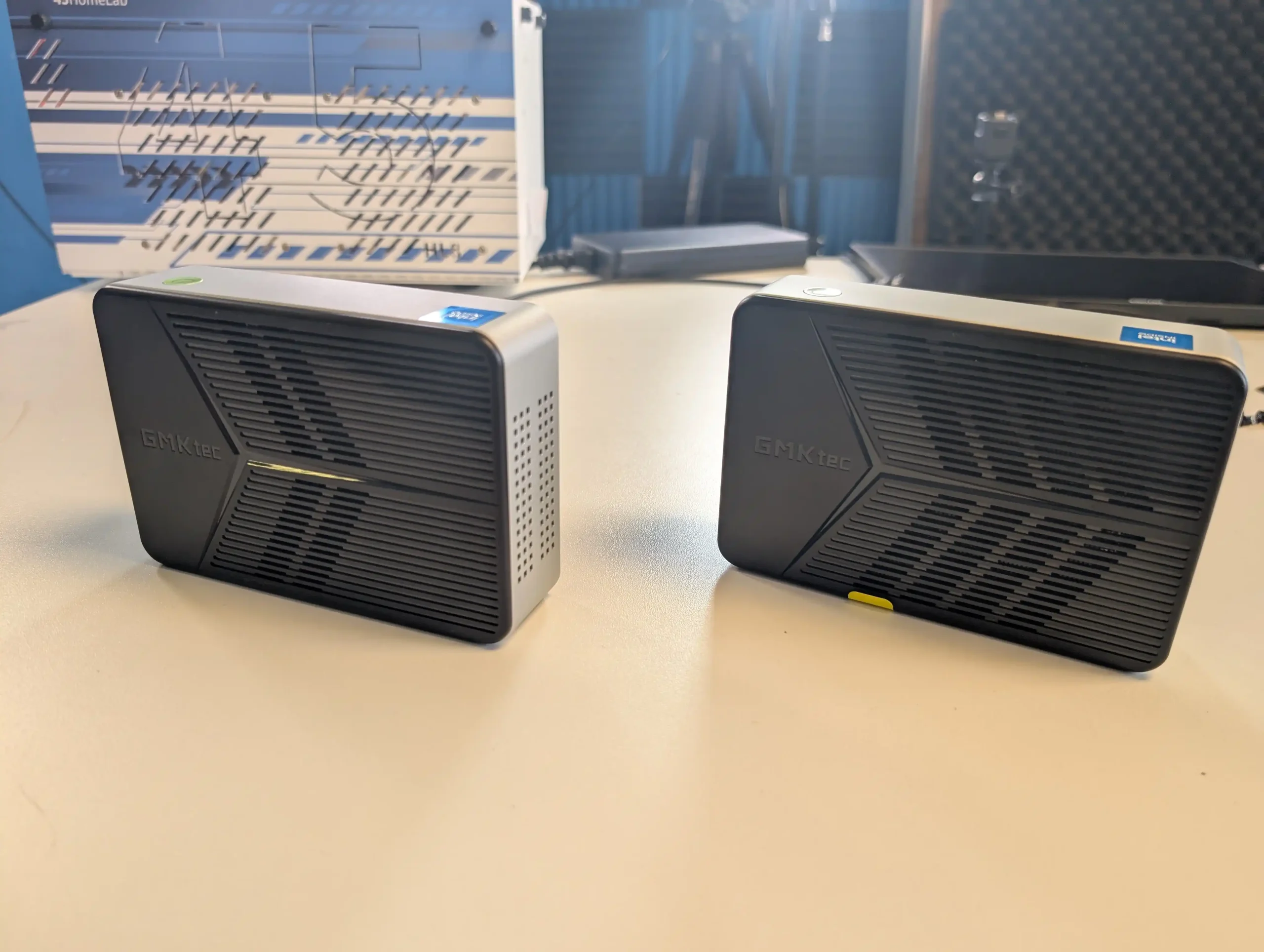
In response, GMKTec has issued an updated version of the G9 that retains the same form factor, internal hardware, and I/O but incorporates enhanced passive ventilation on the side and top panels. Though subtle at first glance, these structural changes are designed to improve airflow over the CPU and SSD compartments without increasing noise levels or power draw. In this updated review, we will revisit all aspects of the G9’s design, connectivity, and system behaviour under continuous load, while highlighting what exactly has changed and what remains untouched. The new G9 model introduces targeted thermal improvements, but beyond ventilation, it leaves the original architecture and feature set entirely intact.

GMKTec G9 Ver.2 NAS Review – Quick Conclusion
The improved GMKTec G9 NAS represents a targeted refinement rather than a full redesign, addressing the primary weakness of the original model: inadequate thermal performance. The updated version introduces enlarged ventilation cutouts on the top panel above the CPU fan and replaces the pinhole rear exhaust with a wider mesh, leading to measurable but modest reductions in system temperatures. In 48-hour test scenarios using UnRAID with hourly backup tasks, SSDs without heatsinks in the original unit reached idle temperatures of 66–67°C, while the revised model brought this down to 56–57°C. CPU vent temperatures similarly dropped from 54–56°C to 50–52°C, and rear I/O areas cooled by 5–7°C. These improvements enhance stability during sustained I/O activity but do not eliminate the need for additional SSD cooling—particularly in environments where ambient heat or multi-user access is expected. Internally, the hardware remains unchanged: Intel N150 CPU, 12GB of non-upgradable LPDDR5 memory, four PCIe Gen 3 x2 M.2 NVMe bays, and dual 2.5GbE ports, with storage and network throughput consistent with entry-level expectations. Power consumption remains efficient (19–30W), and noise levels stay low at under 40dB, making it suitable for always-on deployment. However, the continued use of a plastic chassis and base panel still limits effective heat dissipation, and the absence of thermal sensors or fan curve controls further limits its thermal adaptability. Compared to the Xyber Hydra—featuring a metal base, better SSD thermal contact, and 16GB RAM—the G9 now performs better than before but still falls short of what its hardware could achieve with more thoughtful engineering. For users willing to invest in SSD heatsinks and mindful of its limitations, the G9 is now a reasonably balanced entry NAS, though not the strongest performer in its tier.
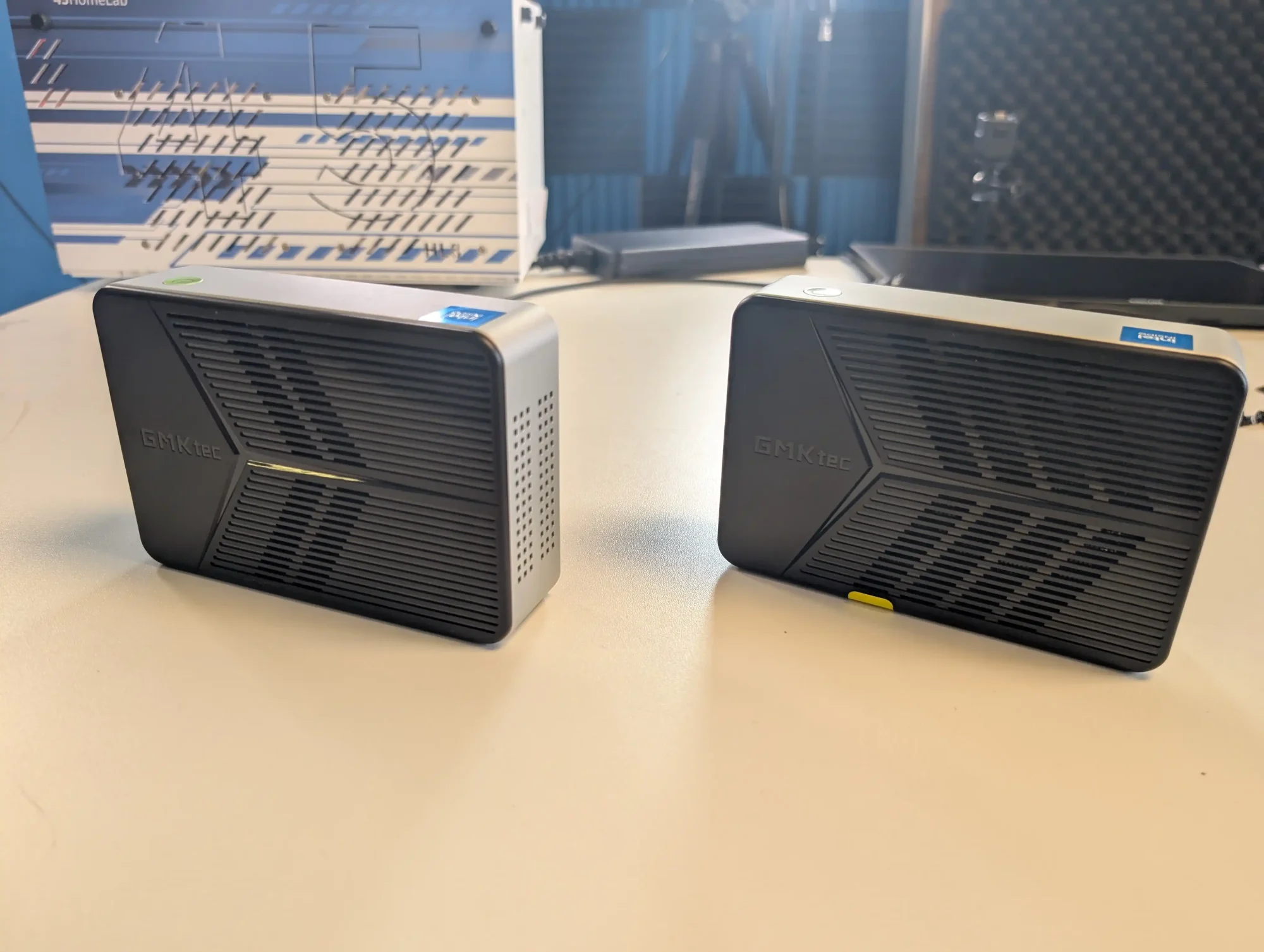

7.6
 Affordable price point for a 4-bay NVMe NAS with dual 2.5GbE (typically under $200).
Affordable price point for a 4-bay NVMe NAS with dual 2.5GbE (typically under $200). Support for up to 32TB of SSD storage across four M.2 NVMe slots.
Support for up to 32TB of SSD storage across four M.2 NVMe slots. Low power consumption (19W idle, ~30W under load) suitable for 24/7 operation.
Low power consumption (19W idle, ~30W under load) suitable for 24/7 operation. Improved passive airflow design compared to the original model (lower overall temps).
Improved passive airflow design compared to the original model (lower overall temps). Dual USB-C power input options for flexible cable management.
Dual USB-C power input options for flexible cable management. Silent operation, even during sustained activity (under 40dB).
Silent operation, even during sustained activity (under 40dB). Pre-installed OS (Windows 11 Pro and Ubuntu) allows for flexible initial use.
Pre-installed OS (Windows 11 Pro and Ubuntu) allows for flexible initial use. Compact, space-saving enclosure ideal for desktop setups or constrained environments.
Compact, space-saving enclosure ideal for desktop setups or constrained environments.
 Cooling Improvements are relatively small and No bundled SSD heatsinks, making thermal throttling likely without aftermarket cooling.
Cooling Improvements are relatively small and No bundled SSD heatsinks, making thermal throttling likely without aftermarket cooling. Non-upgradable 12GB LPDDR5 RAM limits scalability for heavier workloads.
Non-upgradable 12GB LPDDR5 RAM limits scalability for heavier workloads. Plastic chassis and base panel still hinder full thermal dissipation from SSDs.
Plastic chassis and base panel still hinder full thermal dissipation from SSDs. The Introduction of other NAS such as the Beelink ME Mini and Xyber Hydra has provided appealing alternatives to this device right now
The Introduction of other NAS such as the Beelink ME Mini and Xyber Hydra has provided appealing alternatives to this device right now
Where to Buy?
|
GMKTec G9 Ver.2 NAS Review – Design and Storage
The GMKTec G9 continues to use a compact, matte-black plastic chassis that is closer in design to a mini PC enclosure than a traditional NAS. The vertical design conserves desk space, and the front-facing panel remains clean and understated, with no visible drive trays or status indicators beyond the power button and basic branding. As with the original model, the chassis sacrifices the durability and thermal advantages of metal in favour of a lightweight, cost-efficient build. This makes the device appealing for users with space constraints, but it also signals the system’s budget positioning. The plastic enclosure, while solid enough for day-to-day use, is not especially resistant to heat buildup during sustained I/O operations, which remains one of its most persistent limitations.
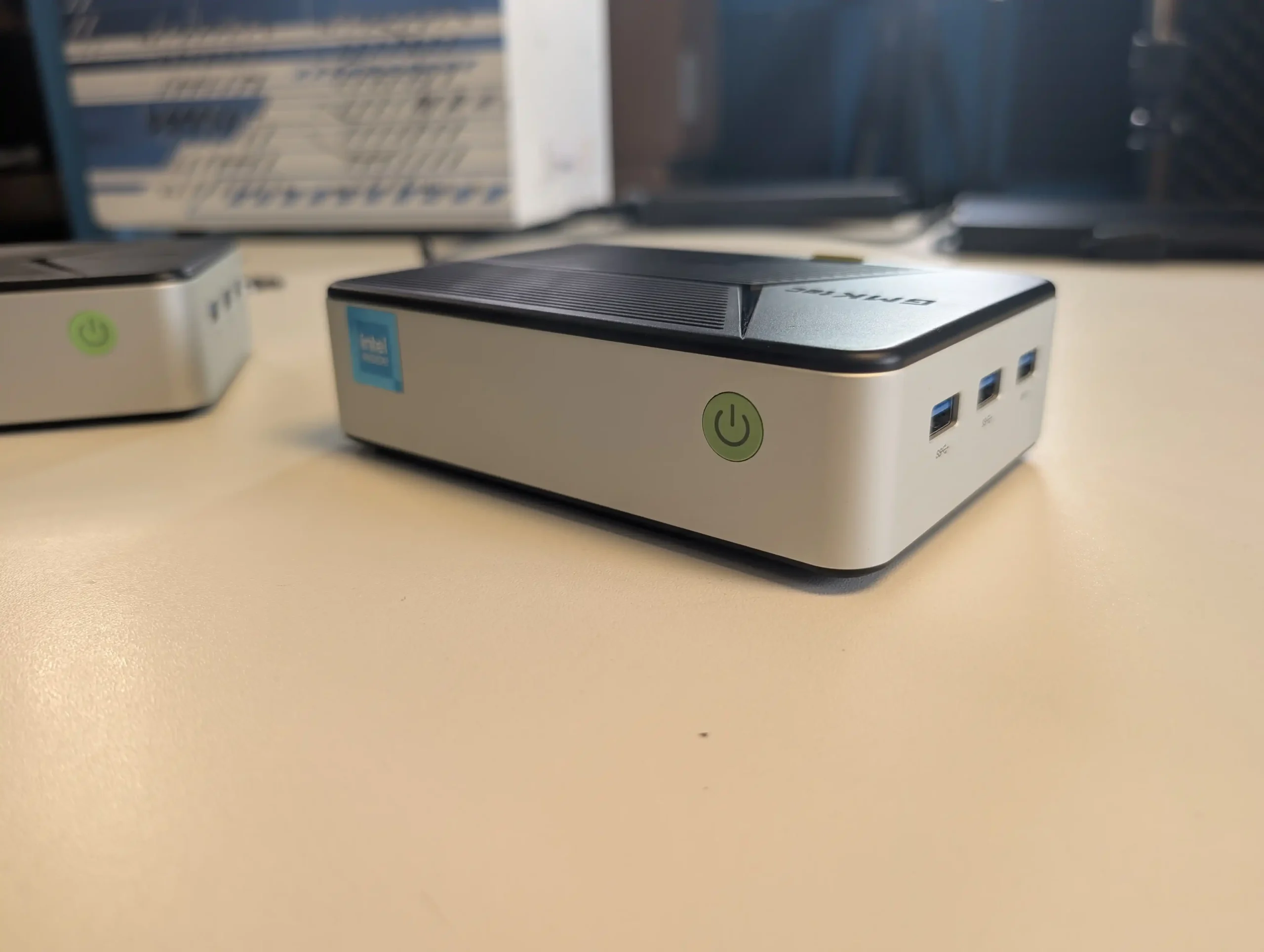
Internally, the system supports four M.2 NVMe SSDs, each connected via PCIe Gen 3 x2 lanes. This setup allows up to 32TB of total SSD storage, assuming the use of high-capacity 8TB NVMe drives. The use of SSDs rather than traditional 2.5″ or 3.5″ hard drives enables near-silent operation, faster access times, and lower power consumption. However, SSD-only NAS designs like this one typically require better airflow and heatsinking to mitigate thermal throttling—especially during RAID operations or when used as a media server with multiple concurrent reads and writes. The G9 supports basic RAID via third-party NAS OSs, but due to PCIe lane limitations and lack of onboard RAID management, advanced configurations will rely entirely on software.
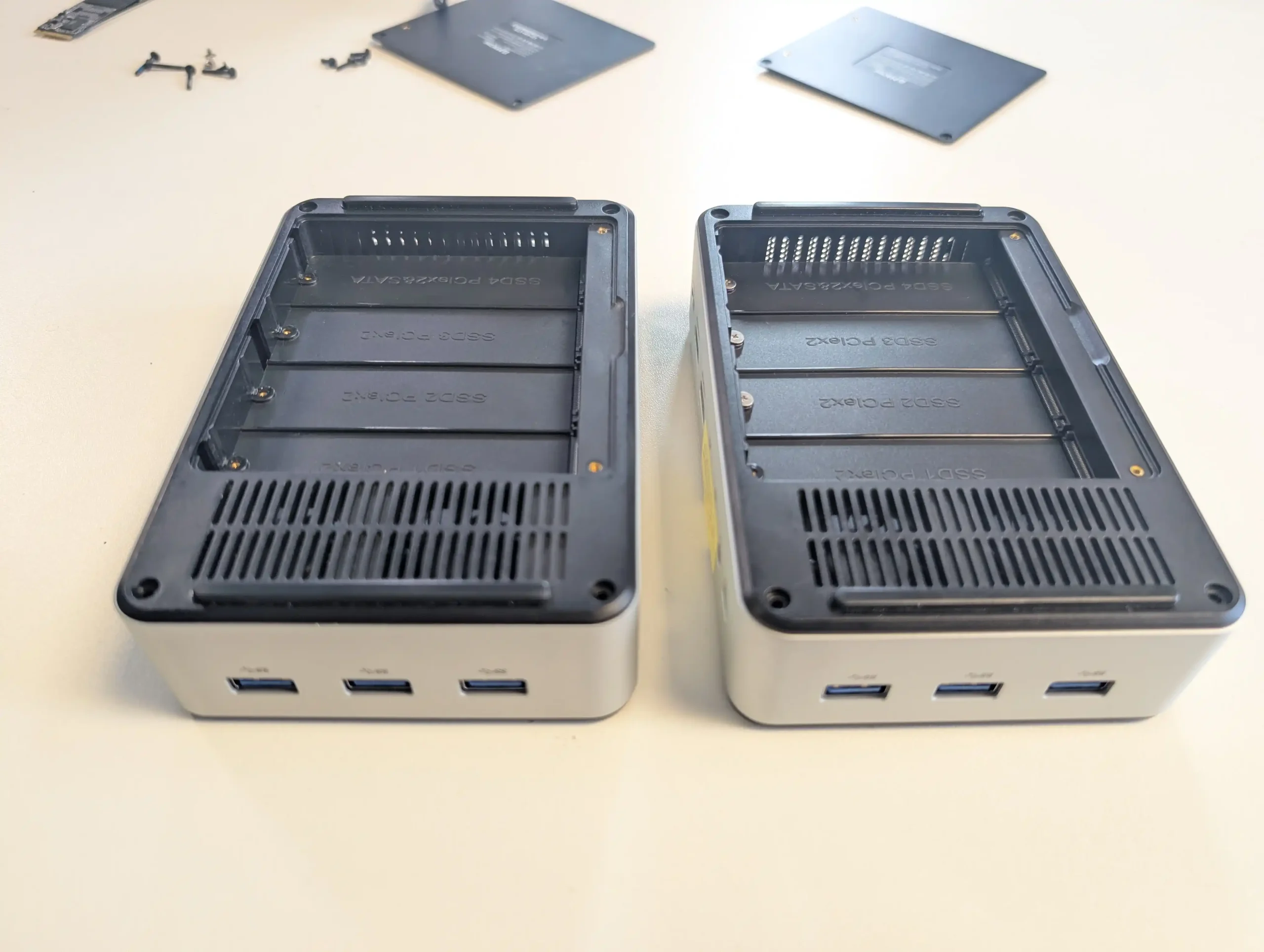
One of the primary complaints in the original model was the absence of SSD heatsinks and the system’s poor natural heat dissipation. While pre-built units from GMKTec occasionally shipped with low-profile aluminum heatsinks, user-added drives often ran hot, especially under sustained write loads. The M.2 slots sit stacked vertically inside a cramped compartment behind the lower rear panel, and when combined with a sealed plastic baseplate, heat quickly accumulates. This design still persists in the new version, and although airflow has been improved through the external vents, the interior thermal behaviour remains heavily dependent on user-supplied heatsinks and ambient cooling conditions. Users deploying high-endurance SSDs or running frequent write-intensive tasks will need to factor this into their thermal strategy.
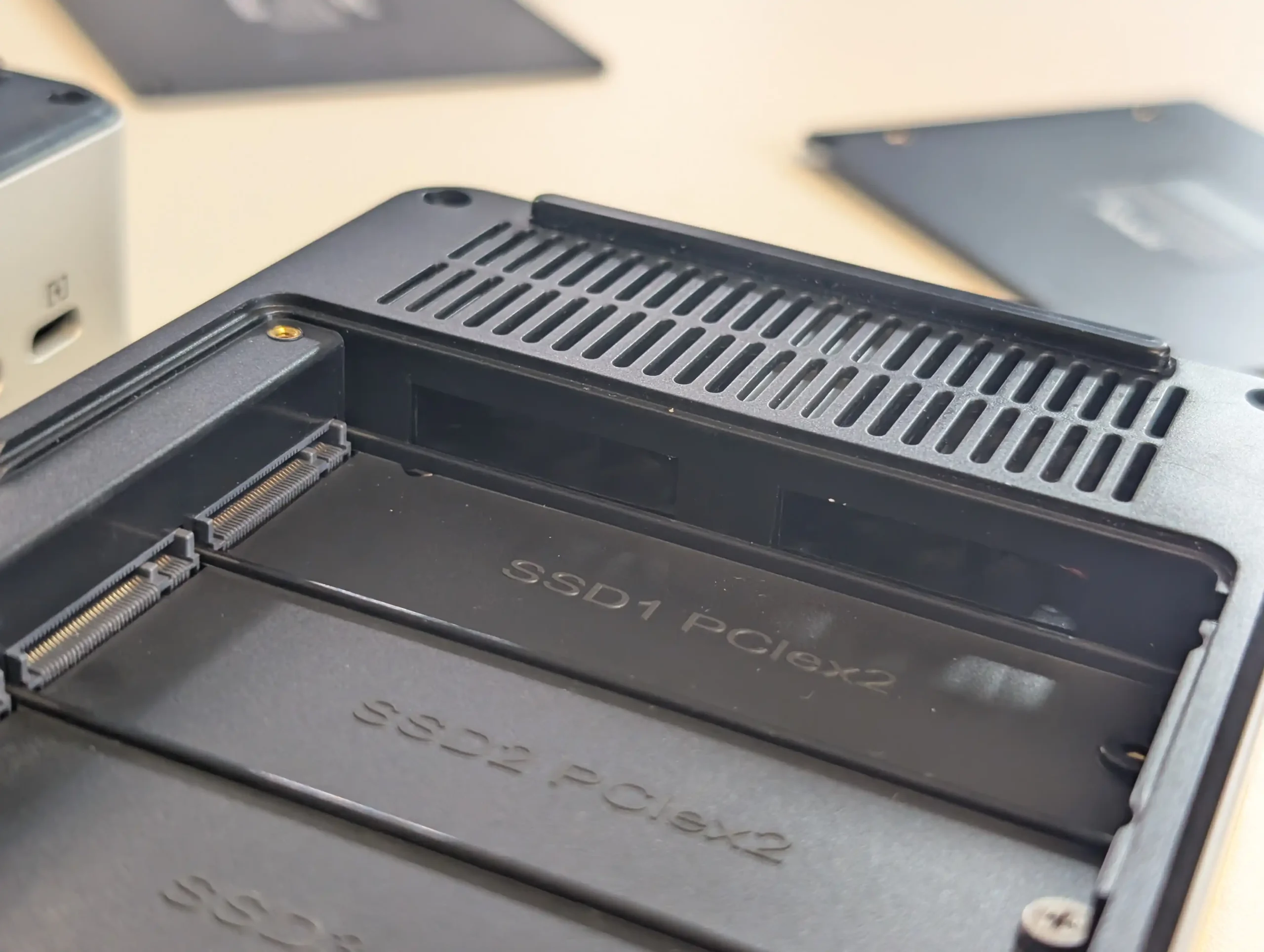
The internal layout is efficient but fixed. There are no modular trays or hot-swap capabilities for the SSDs, and all upgrades must be performed by opening the device. Memory is soldered and therefore non-upgradable, and while there’s internal eMMC storage used for the pre-installed OS, most users will opt to install TrueNAS, UnRAID, or OpenMediaVault onto one of the NVMe drives for full NAS functionality. The passive cooling approach is unchanged in its core design: two internal fans (one for CPU, one system) move air through the case, but without direct thermal contact to the SSDs or a conductive enclosure material, this airflow has limited reach. Placement of the unit in a well-ventilated space remains essential.
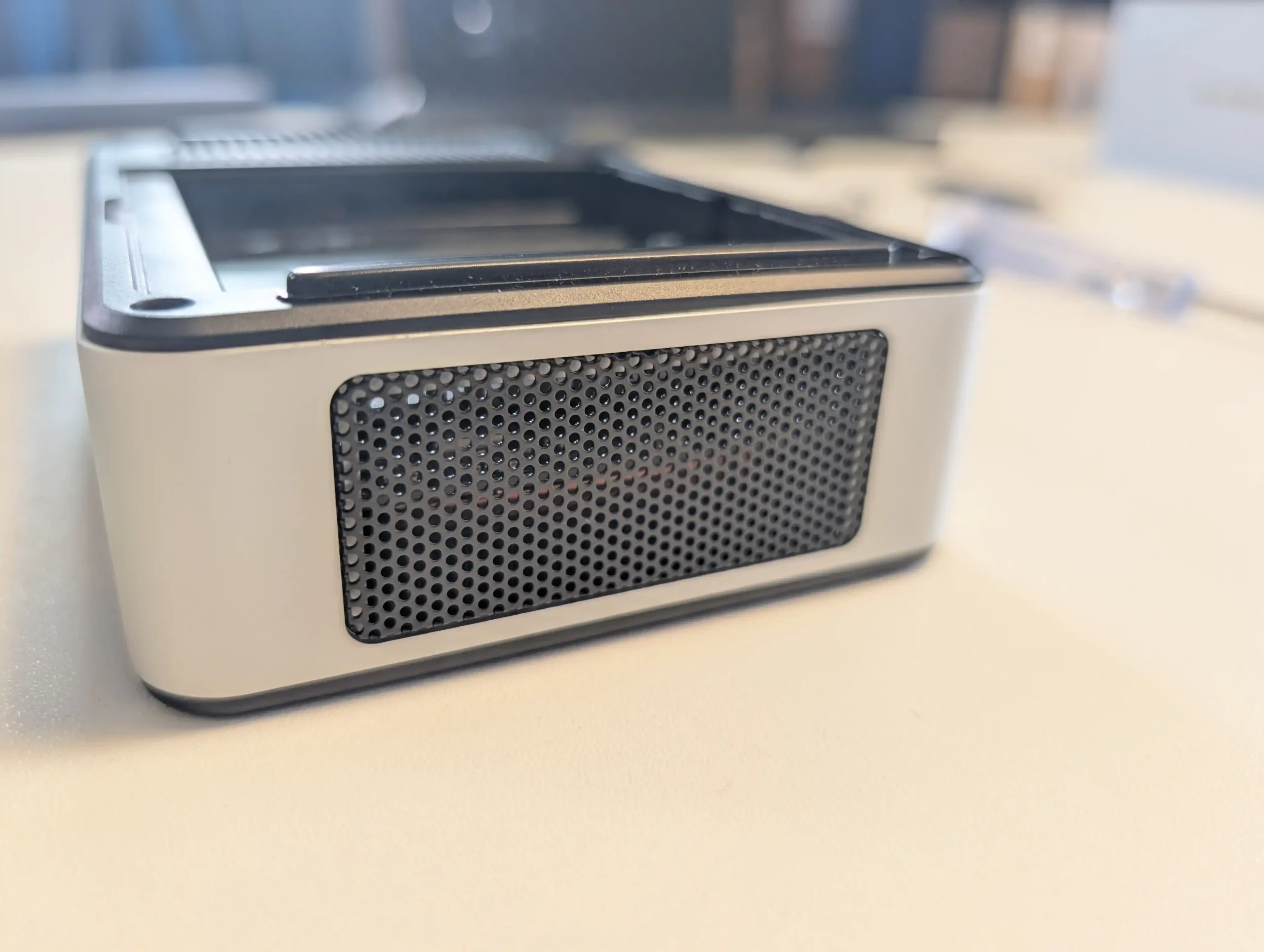
The only real physical design changes in the new version are to the external ventilation panels. GMKTec has replaced the original pinhole-style vent on the rear side with a wider mesh grille, which now spans a greater portion of the side panel. Additionally, the top panel has been revised to include a broader cutout directly above the CPU fan, allowing a clearer exhaust path for rising hot air. However, the plastic base and internal heat chamber structure remain unchanged, meaning SSD temperatures are still a potential concern—especially without aftermarket cooling. The updated G9 retains the same core storage architecture as the original, but introduces modest improvements to airflow via enhanced external ventilation.
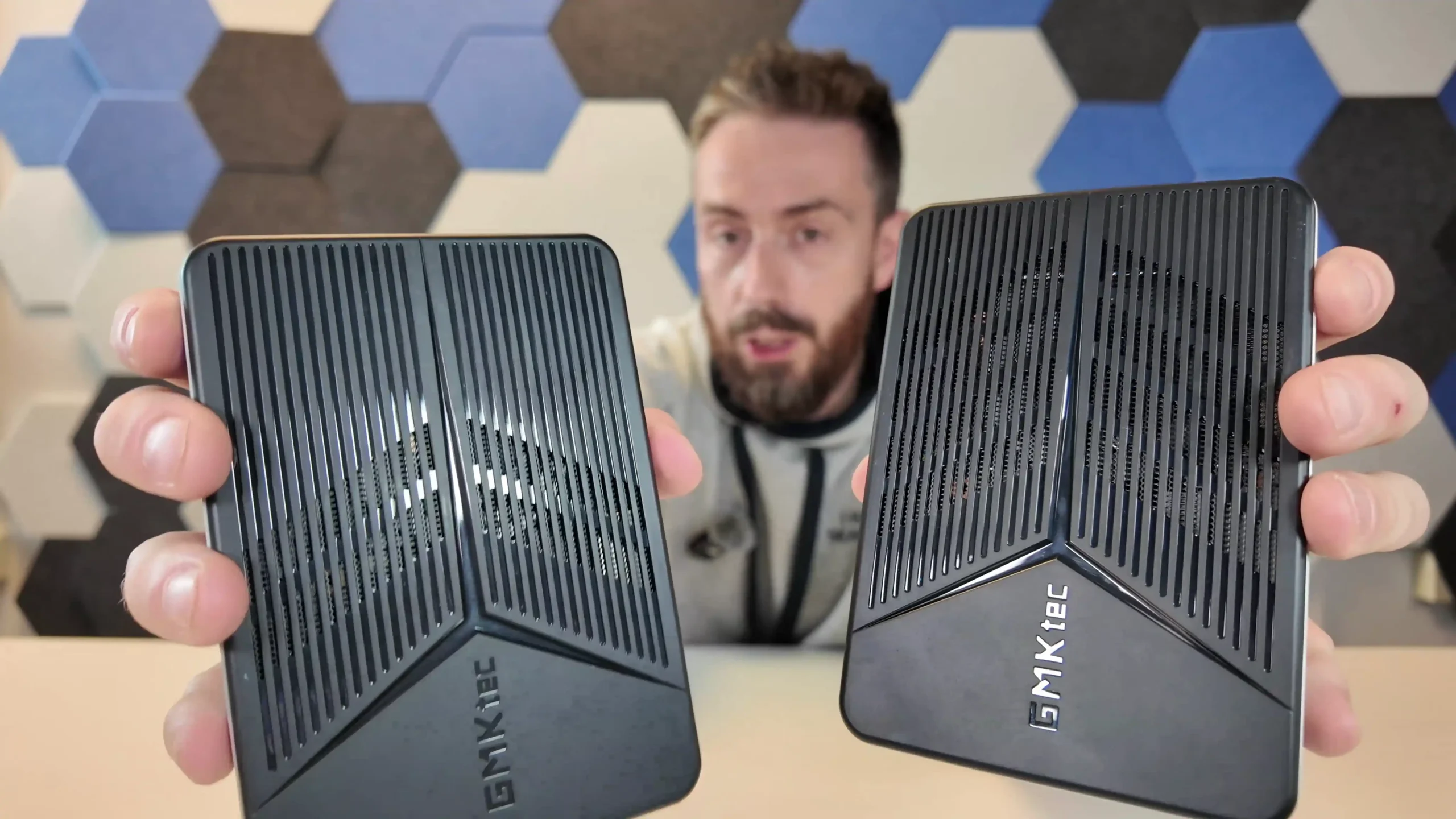
GMKTec G9 Ver.2 NAS Review – Internal Hardware
At the center of the GMKTec G9 is the Intel N150 processor, a quad-core, four-thread CPU built on the 10nm Twice Lake architecture. Designed for ultra-efficient computing, it operates at a modest 6W TDP, making it ideal for passive or semi-passive cooling environments like compact NAS systems. The N150 runs at a 1.0GHz base frequency and boosts up to 3.6GHz under load, delivering just enough headroom for tasks like SMB/NFS sharing, low-volume web hosting, and basic media playback. Its integrated Intel UHD Graphics support up to 4K at 60Hz output via HDMI or USB-C DisplayPort alt mode, though without hardware acceleration for modern codecs like AV1, its suitability for on-the-fly transcoding is limited. The CPU also lacks advanced server-grade features like ECC memory support, SR-IOV, or high-bandwidth PCIe 4.0 lanes, which reflects its role in cost-conscious, entry-level applications.
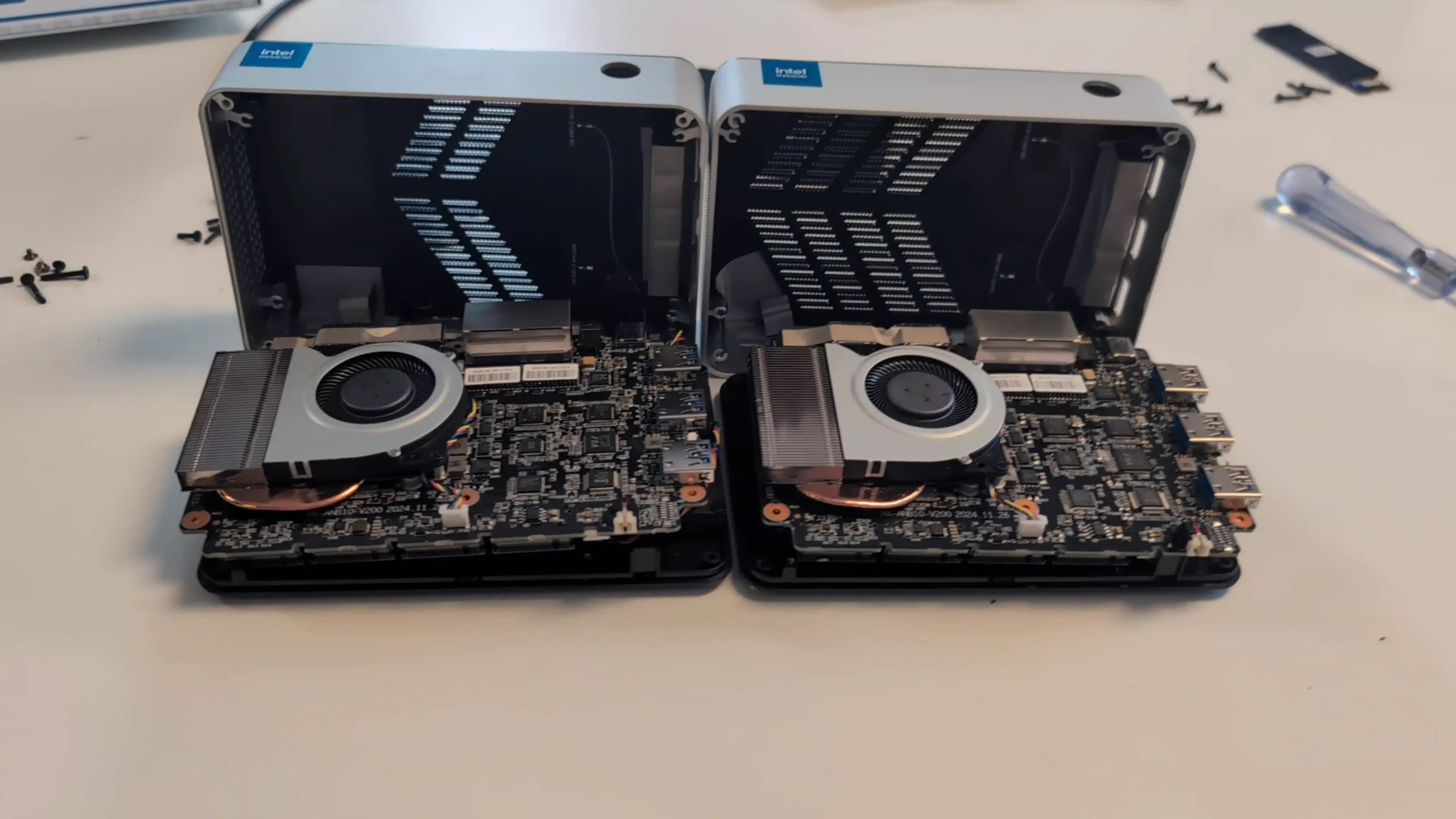
The onboard 12GB of LPDDR5-4800 memory is soldered and cannot be replaced or upgraded, a design choice that simplifies manufacturing and keeps costs down but limits versatility in heavier multitasking scenarios. In practice, the memory is sufficient for running one or two lightweight NAS services alongside file sharing, or even a basic Docker container or two, but its soldered configuration leaves no room for future expansion. Notably, the memory is dual-channel, which does help offset some performance constraints—especially in scenarios where the integrated graphics or CPU requires memory bandwidth access. While most users won’t hit the ceiling of 12GB under standard NAS tasks, advanced setups involving active sync with cloud platforms, large-scale Plex libraries, or multiple concurrent rsync/FTP sessions could find the limitation restrictive. Also, unlike some similarly priced competitors, there’s no accessible BIOS option to reserve RAM for cache acceleration, which could have improved responsiveness under heavier I/O loads.
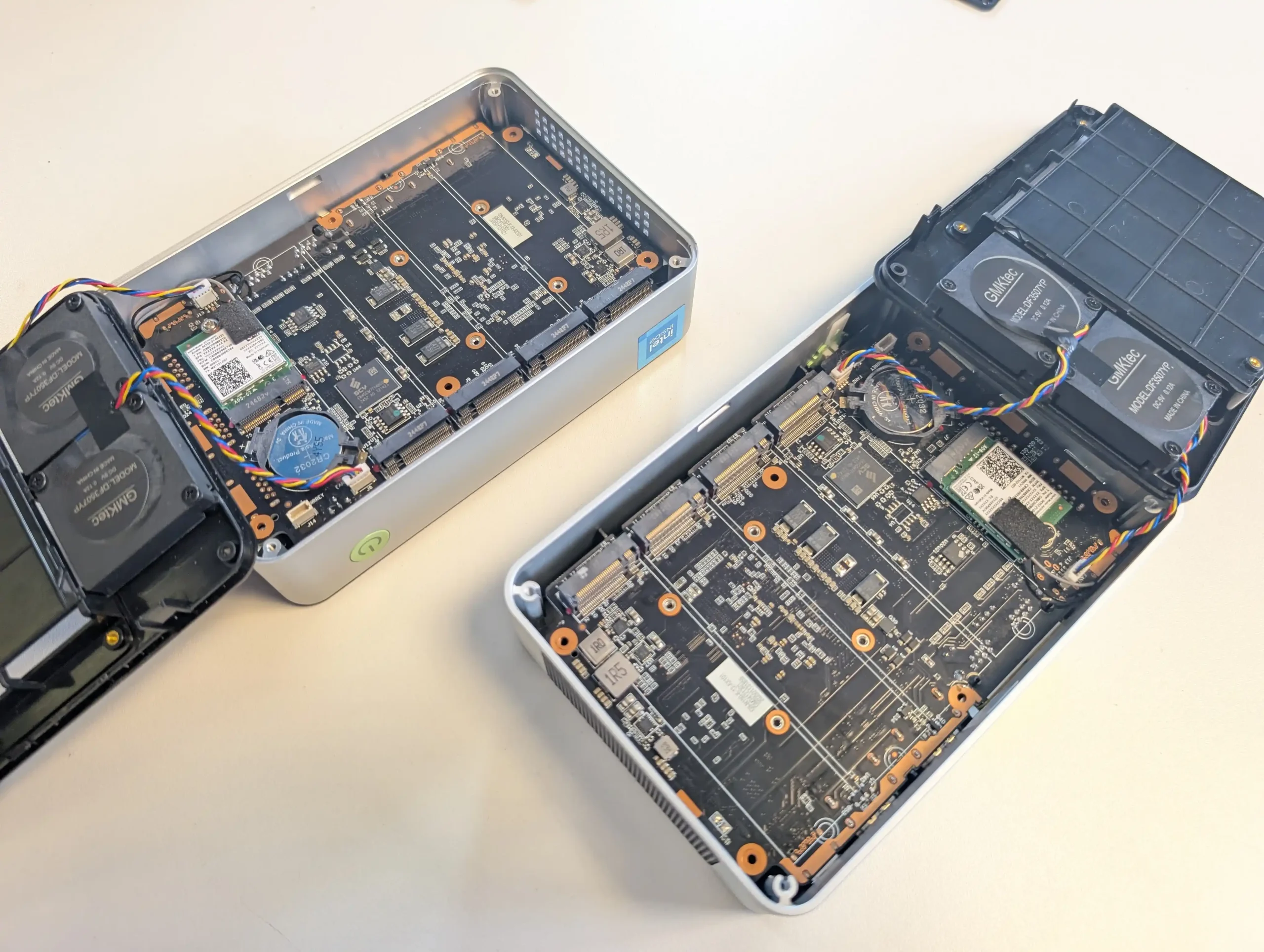
In terms of storage hardware, the G9 offers four M.2 NVMe slots with PCIe Gen 3 x2 interfaces, a configuration that supports up to 32TB of total storage using current consumer-grade drives. Each slot is keyed for M-Key NVMe SSDs and arranged vertically inside the enclosure, though installation requires unscrewing the rear panel and working within the confined internal cavity. The system’s internal PCIe lane distribution is handled through multiple ASMedia ASM1182e switch chips, which divide the CPU’s limited PCIe bandwidth across all four NVMe slots and the dual 2.5GbE interfaces. While the Gen 3 x2 interface is technically capable of 2GB/s per slot, real-world speeds are often lower during concurrent access due to the shared architecture.
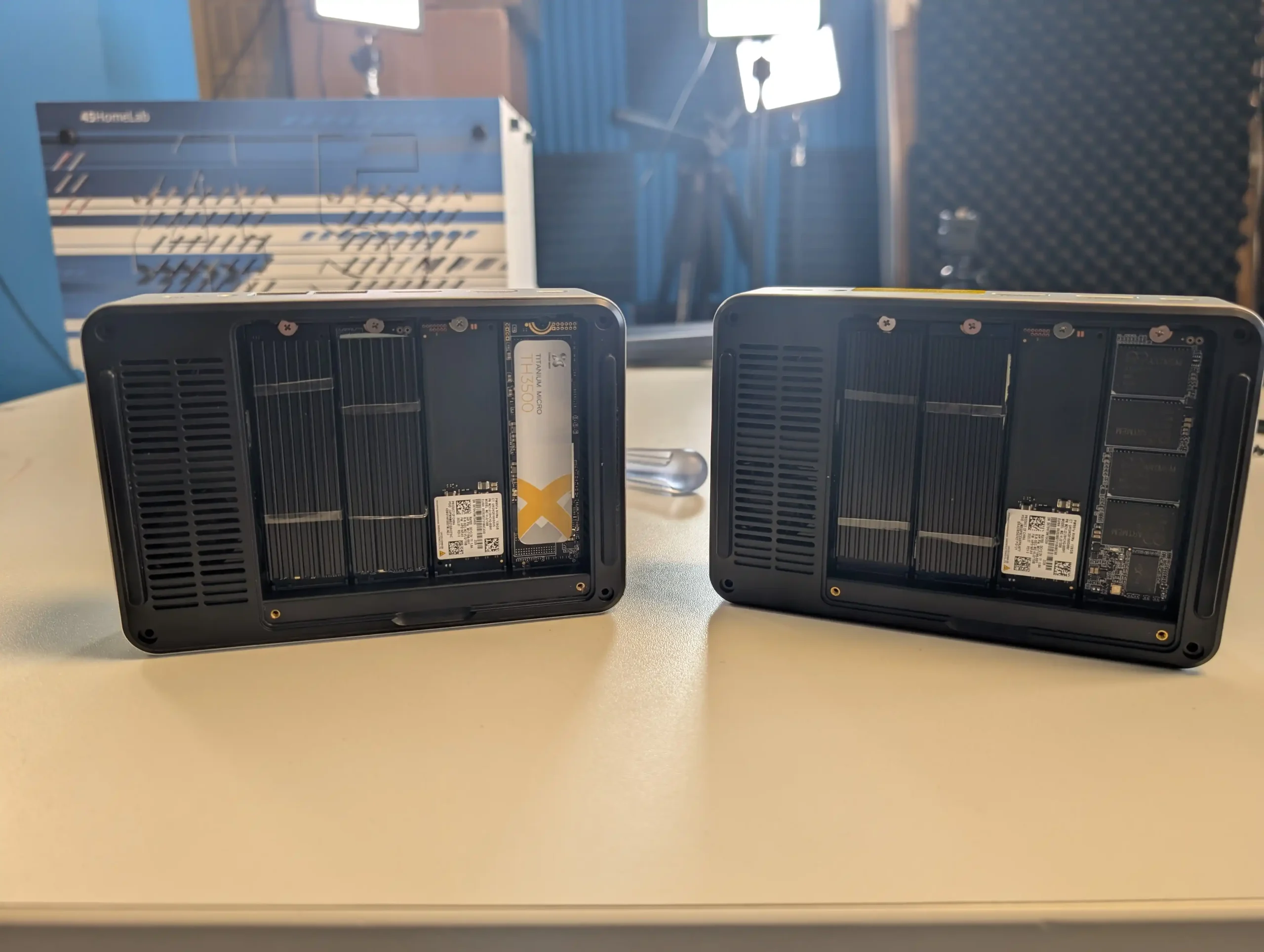
This design also limits SSD passthrough capabilities in virtualized environments, and users aiming for high-speed SSD RAID configurations (RAID 5 or 10, for example) may encounter inconsistent write speeds. Additionally, there is no hardware-level thermal throttling safeguard tied to fan curves or SSD temperature sensors, so thermal build-up under load could directly affect sustained throughput unless active cooling measures are installed. The internal hardware of the improved GMKTec G9 remains completely unchanged from the original release—no CPU, RAM, SSD slot layout, or controller chip has been altered in the updated version.
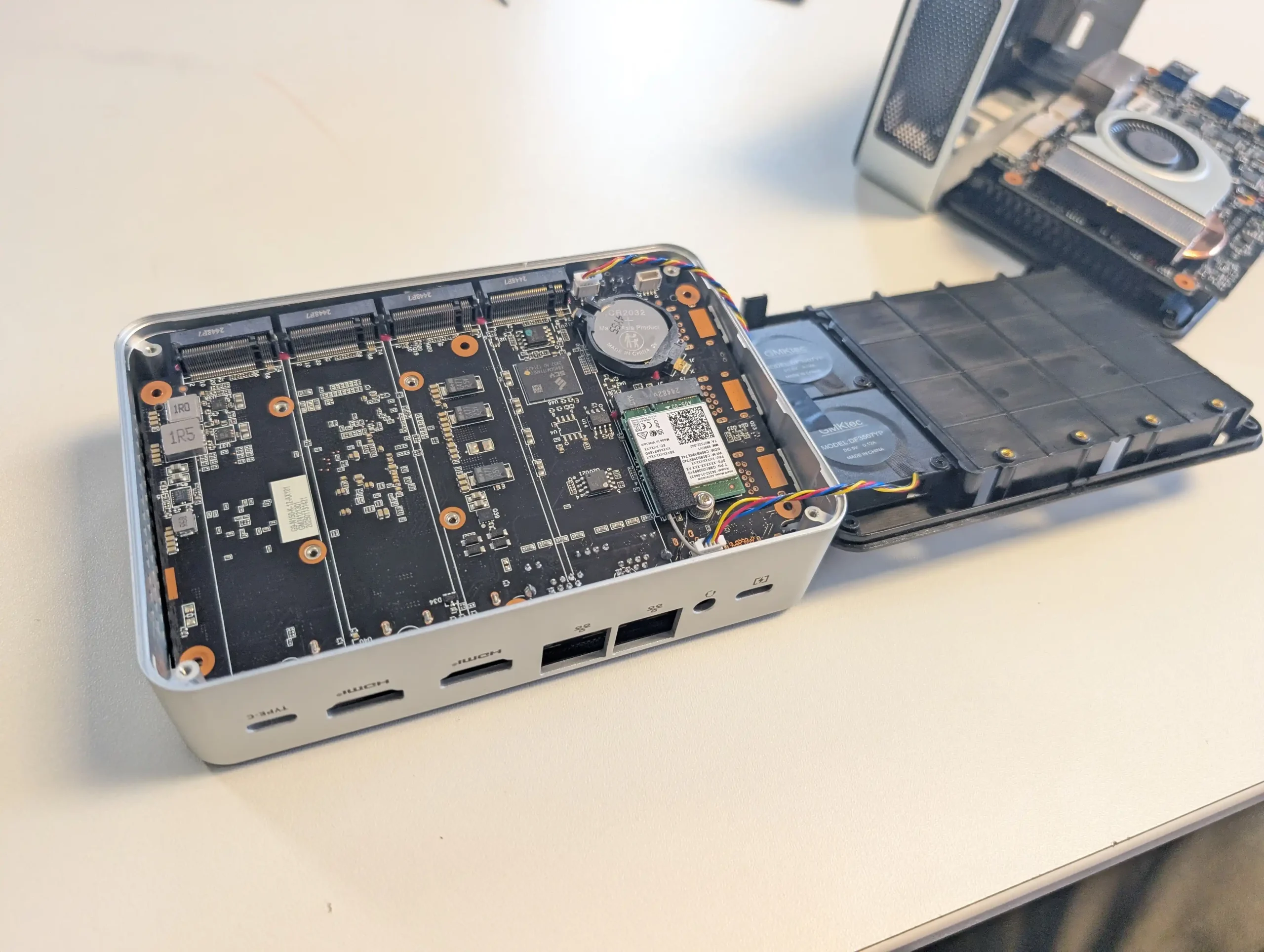
| Component | Details |
|---|---|
| CPU | Intel N150 (4 Cores / 4 Threads, 1.0–3.6GHz) |
| Architecture | Intel Twice Lake (10nm) |
| TDP | 6W |
| Memory | 12GB LPDDR5-4800 (Dual-channel, Non-upgradable) |
| Integrated Storage | 64GB eMMC (for pre-installed Windows/Ubuntu) |
| NVMe Support | 4 x M.2 NVMe SSDs (PCIe Gen 3 x2 interface) |
| Max Storage | Up to 32TB (with 4 x 8TB drives) |
| Graphics | Intel UHD (4K @ 60Hz via HDMI & USB-C DP) |
| PCIe Management | ASMedia ASM1182e Switches (x2) |
| Other Features | AES-NI, VT-x, VT-d, Speed Shift, ACPI 6.2 |
GMKTec G9 Ver.2 NAS Review – Ports and Connections
The GMKTec G9 offers a well-rounded I/O configuration that reflects its hybrid role as both a compact NAS and lightweight desktop appliance. It features two 2.5GbE LAN ports, both of which are directly linked to the CPU via PCIe lanes and can be configured for link aggregation, failover, or isolated network segments. In real-world testing, these ports easily saturate their 312MB/s bandwidth under SMB and iSCSI workloads, making the G9 more capable than traditional Gigabit NAS units. The absence of 10GbE is notable, especially for users planning to deploy NVMe RAID arrays or work in content-heavy environments, but at this price point and power envelope, dual 2.5GbE is still a competitive offering. Notably, both NICs support Wake-on-LAN (WoL), making the system convenient for remote access or low-power automation setups.
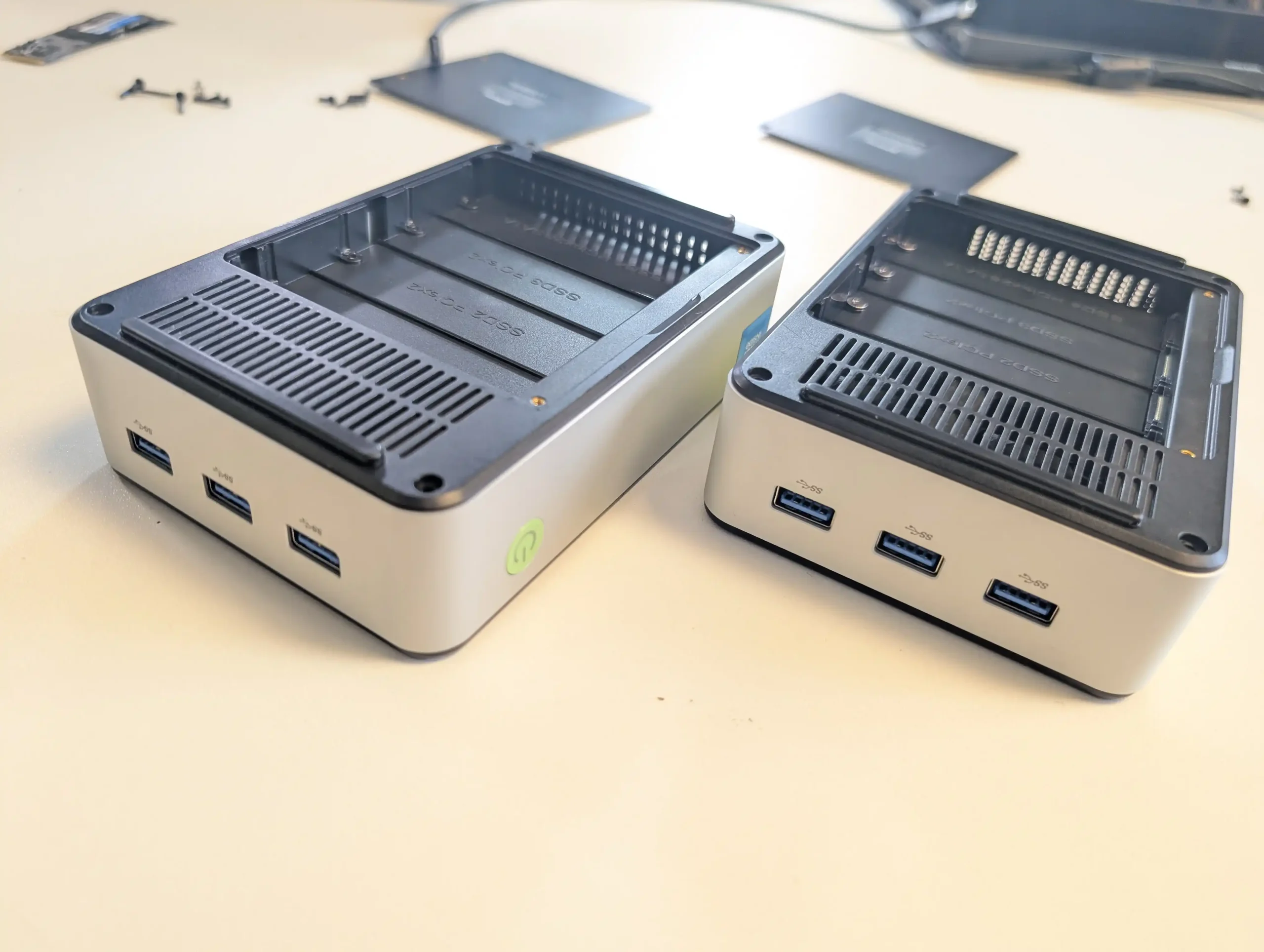
For peripheral and expansion support, the G9 includes three USB-A 3.2 Gen 2 ports and a single USB-C 3.2 Gen 2 port, each capable of 10Gbps data transfer. The USB-C port also supports DisplayPort Alt Mode, allowing it to function as an additional video output alongside the two HDMI 2.0 ports on the rear panel. These HDMI ports support 4K resolution at 60Hz and are positioned for users who may wish to operate the G9 as a silent desktop system or a local media playback device via Kodi, Jellyfin, or Plex. However, the G9 does not include USB 4.0, Thunderbolt, or PCIe expandability, limiting options for future upgrades such as external GPUs, additional NICs, or DAS enclosures. In testing, connected peripherals such as USB drives and webcams were recognized instantly under Ubuntu and Windows, confirming basic plug-and-play compatibility.
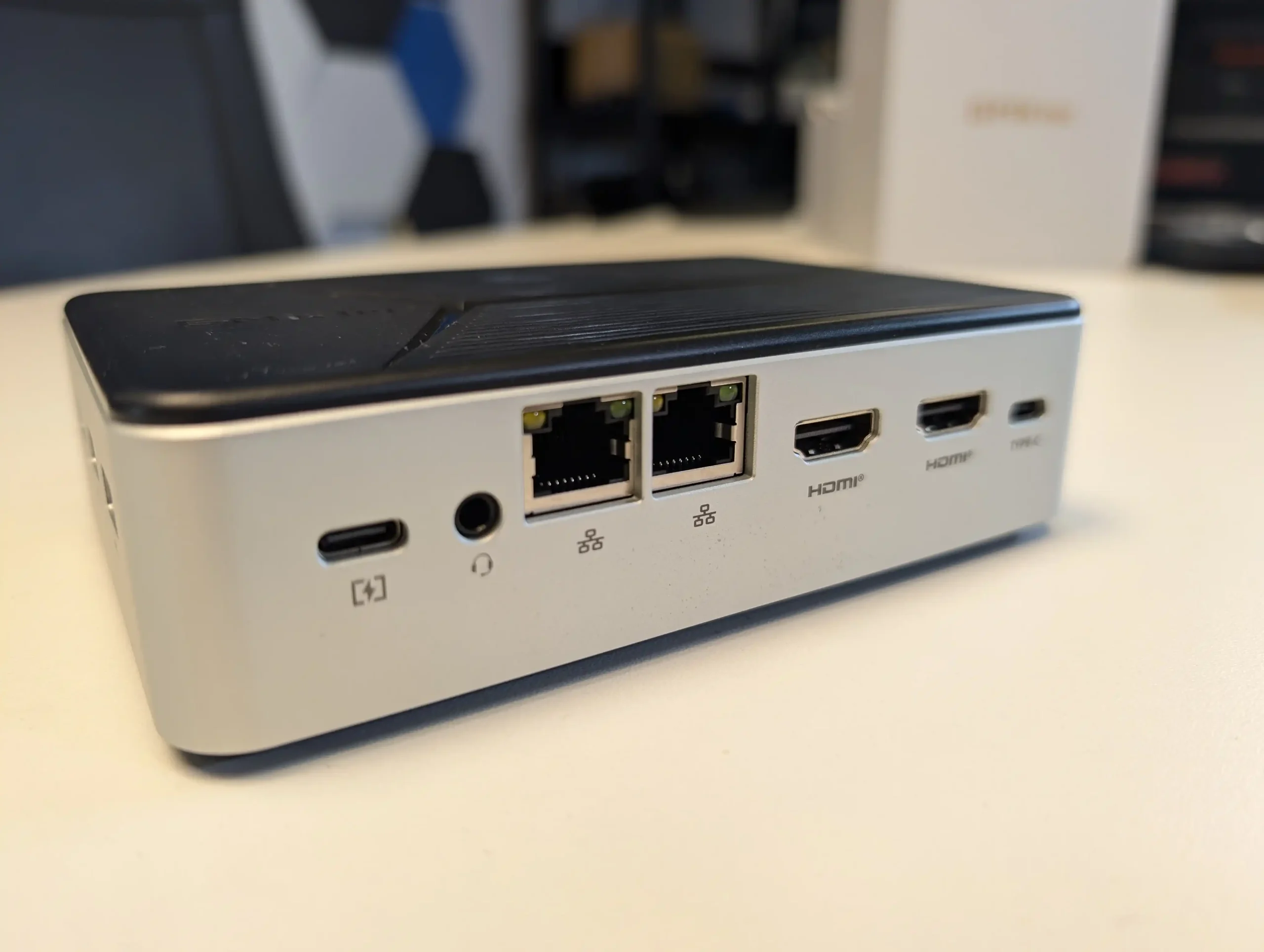
Power delivery is handled via USB-C PD input, using a 65W external power brick that ships with the unit. Uniquely, the updated G9 introduces a small but notable change: dual USB-C power input points, allowing users to select which side of the device receives the power cable. This change doesn’t increase power capacity or enable redundancy, but it can improve cable management depending on the G9’s orientation on a desk or shelf. However, using one of the USB-C ports for power inherently sacrifices a high-speed data port—an unfortunate trade-off given the unit’s lack of PCIe or expansion bays. No dedicated power switch is present; the unit powers on via the front button or Wake-on-LAN and remains always-on unless shut down via software or OS-level scripts. Compared with the original G9, the only change to I/O is the addition of the second USB-C power input for layout flexibility—otherwise, all ports, speeds, and layout remain the same.
| Port Type | Quantity | Specification |
|---|---|---|
| 2.5GbE LAN | 2 | Realtek RTL8125, Link Aggregation Supported |
| USB-A 3.2 Gen 2 | 3 | 10Gbps, Backward Compatible |
| USB-C 3.2 Gen 2 | 1 (+1 PD) | 10Gbps, DisplayPort Alt Mode |
| HDMI 2.0 | 2 | 4K @ 60Hz |
| Power Input (USB-C) | 2 | 65W USB-C PD (Only 1 used at a time) |
| Wake-on-LAN | Supported | Both NICs |
| Audio | None | No 3.5mm jack or digital out |
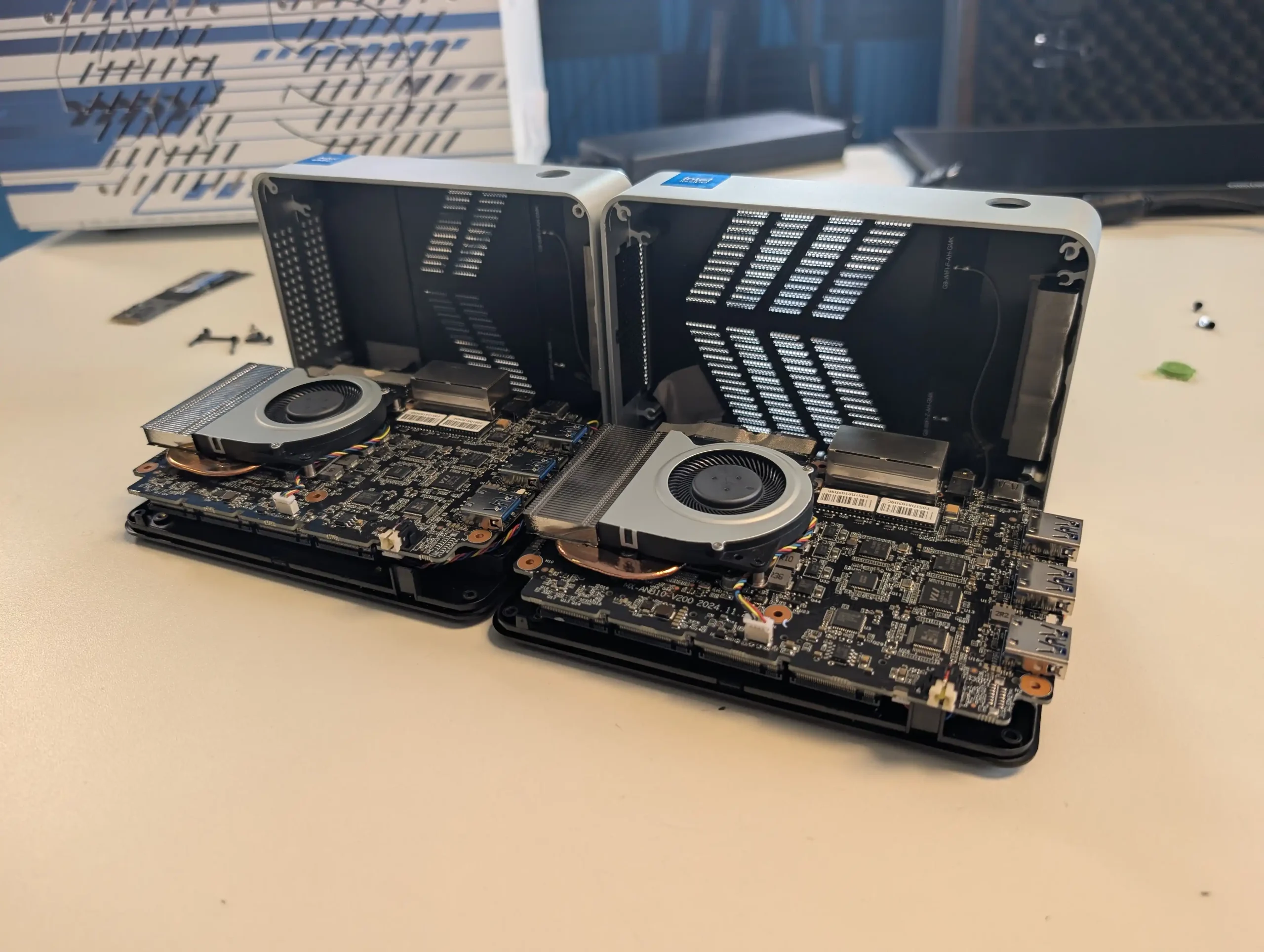
GMKTec G9 Ver.2 NAS Review – Tests and Performance
In synthetic and real-world benchmarks, the GMKTec G9 delivers the level of performance expected from an Intel N150 system with PCIe Gen 3 x2 storage. Read speeds per drive peaked around 1.4–1.5GB/s, aligning well with the theoretical limit of the x2 interface. Write speeds were notably more volatile, ranging between 400–600MB/s depending on SSD type, ambient temperature, and active processes. These numbers, while adequate for file serving, backups, and Docker apps, showed clear limitations when the system was pushed into simultaneous multi-disk writes or parity-based RAID configurations. The presence of ASMedia ASM1182e PCIe switches likely contributes to this variance, as downstream PCIe allocation under pressure introduces contention among the SSD lanes. In typical NAS tasks like SMB and NFS file transfers, however, performance remained consistent and stable, particularly when network activity was confined to single-user access or sequential transfers.
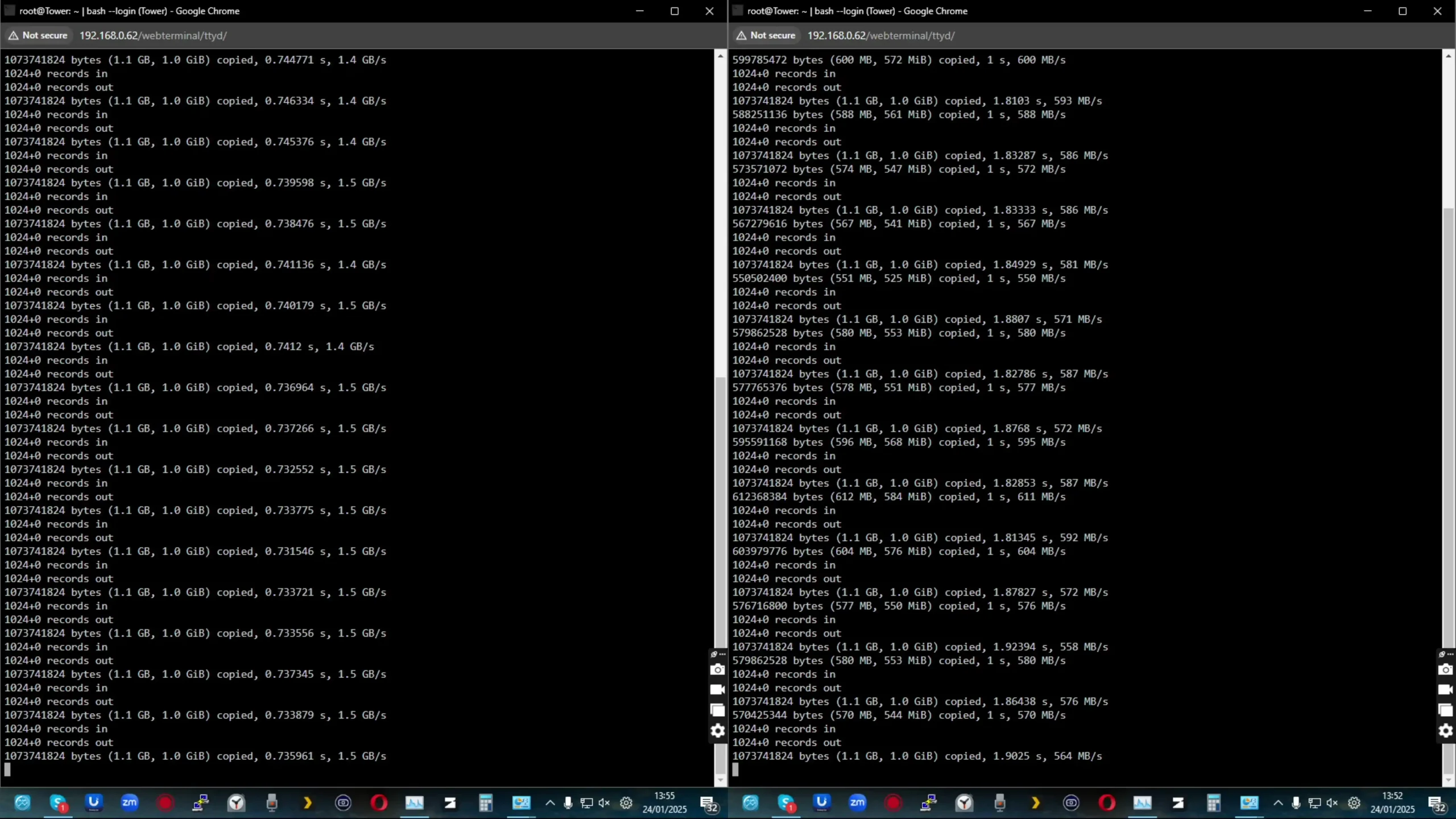
Thermal behaviour is where the most scrutiny falls, given the G9’s original design flaws. Under a controlled 48-hour test using UnRAID with scheduled hourly backups and mixed-use read/write activity, the older G9 unit routinely idled at 54–56°C, with peaks of 66–67°C on SSDs lacking heatsinks.
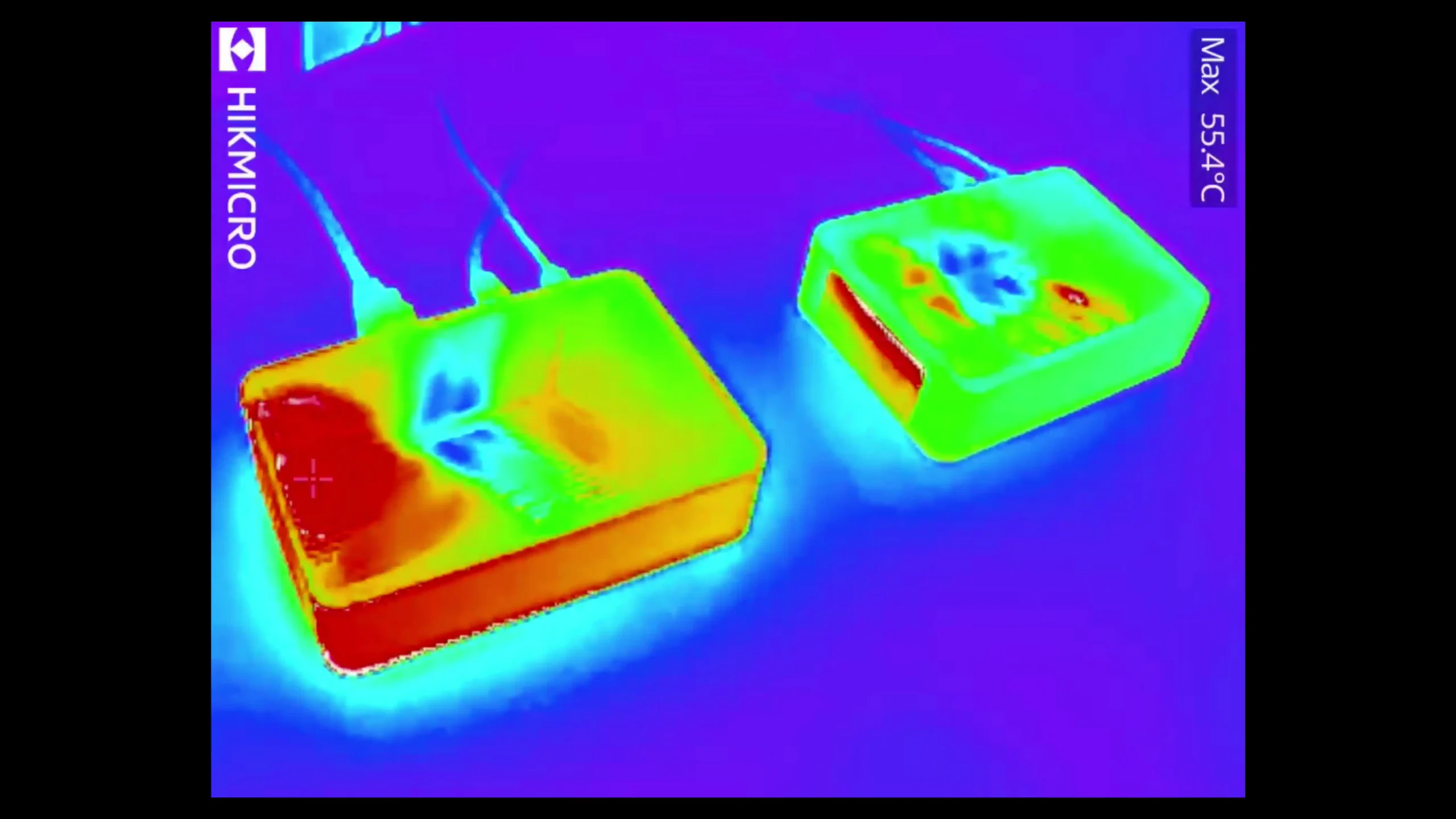
The improved model saw modest thermal gains, with idle temps reduced to 50–52°C at the CPU vent and around 56–57°C on the SSD layer. Some of this improvement came from the revised ventilation—namely the expanded top-panel fan cutout and rear-side mesh panel—yet the base remained the same thermally isolated plastic panel, and internal fan hardware remained unchanged.
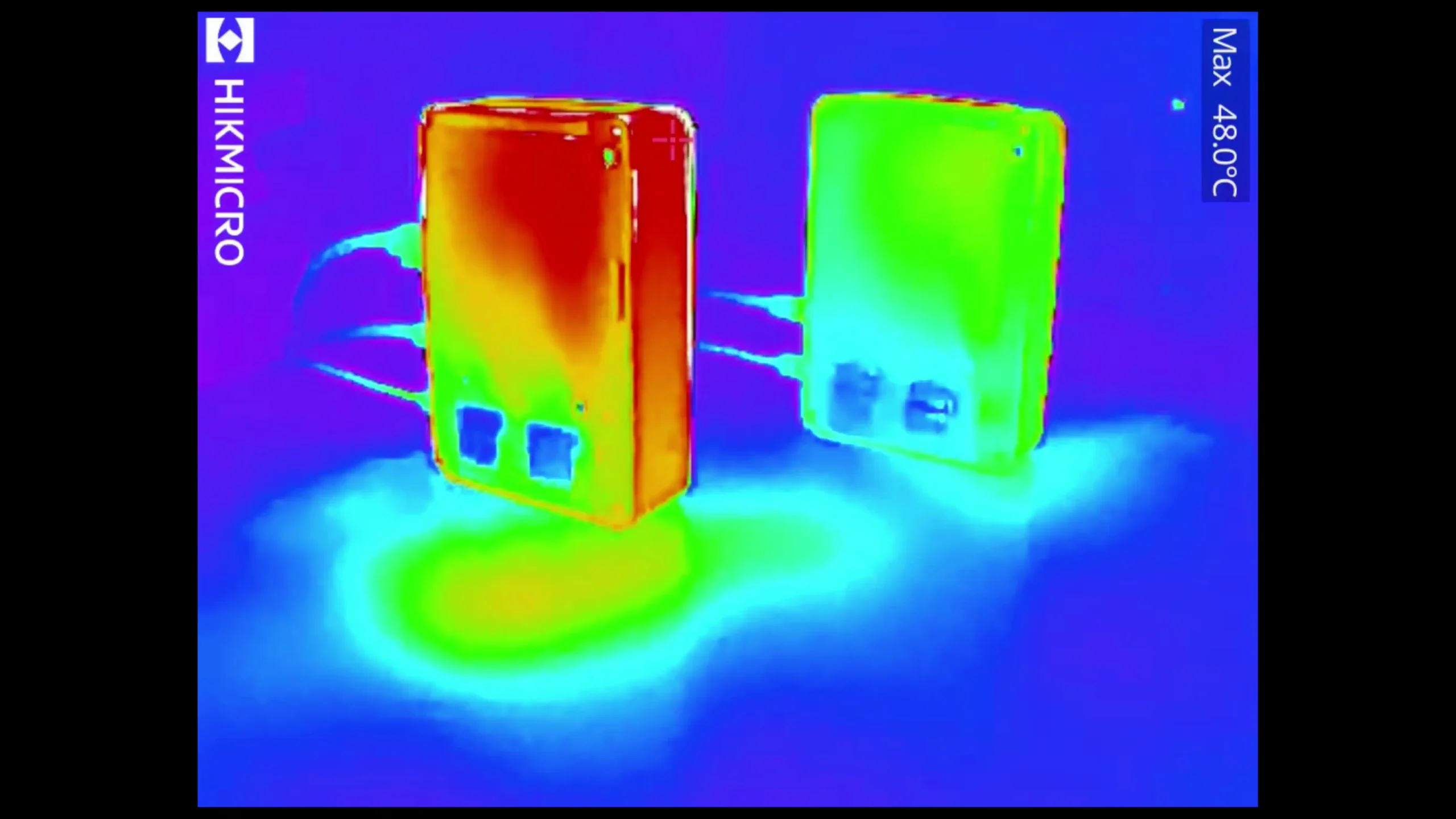
Notably, temperatures around the rear I/O ports dropped by 5–7°C between versions, suggesting that airflow efficiency around the motherboard has improved even if core thermal load remains a challenge.
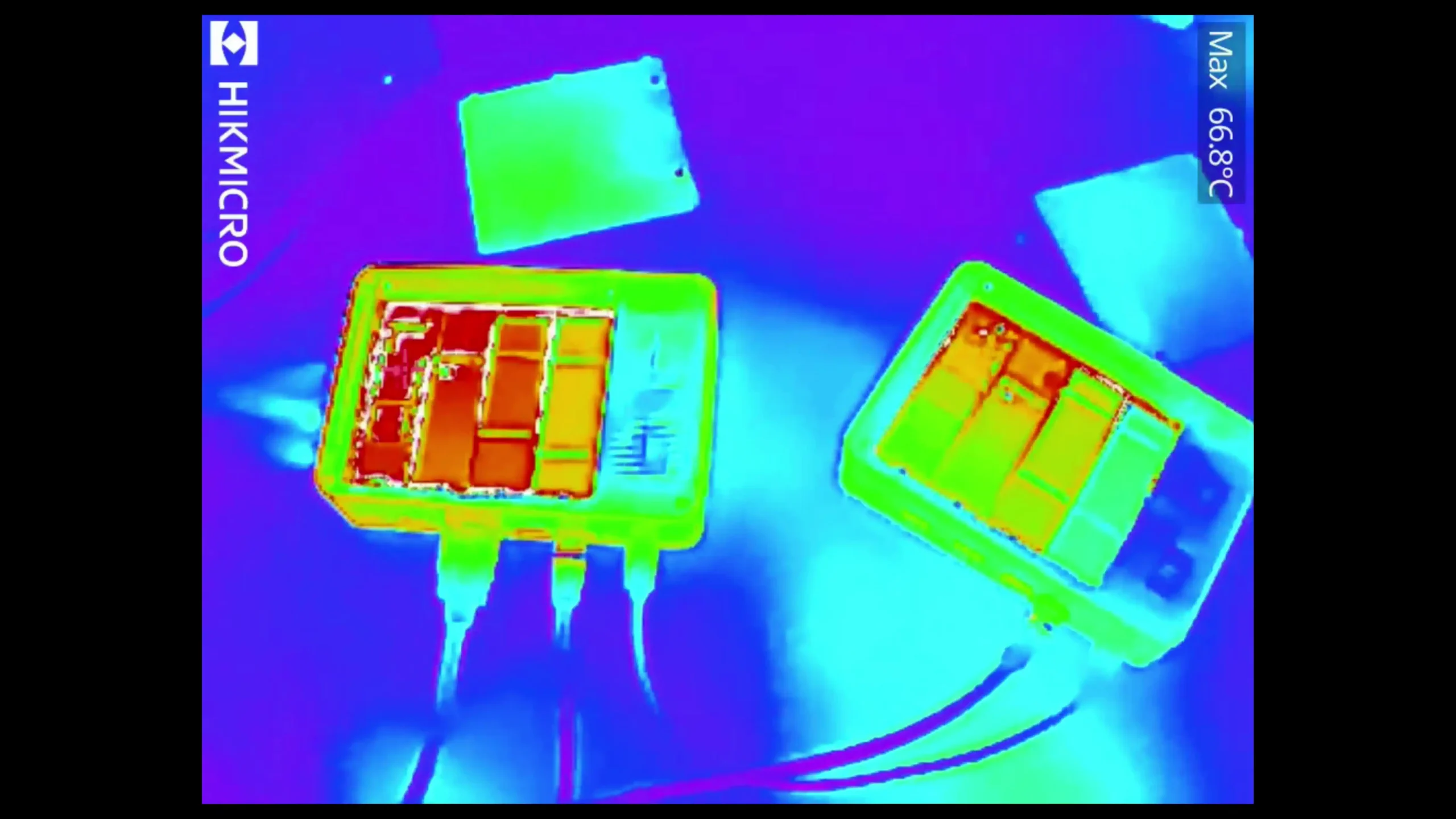
In terms of noise and power, the G9 performs admirably. Even under load, fan noise remained below 40dB, with idle operation being nearly silent. Power consumption remained within the expected range—19–21W idle and up to 30W under continuous activity—even during the 48-hour write test.
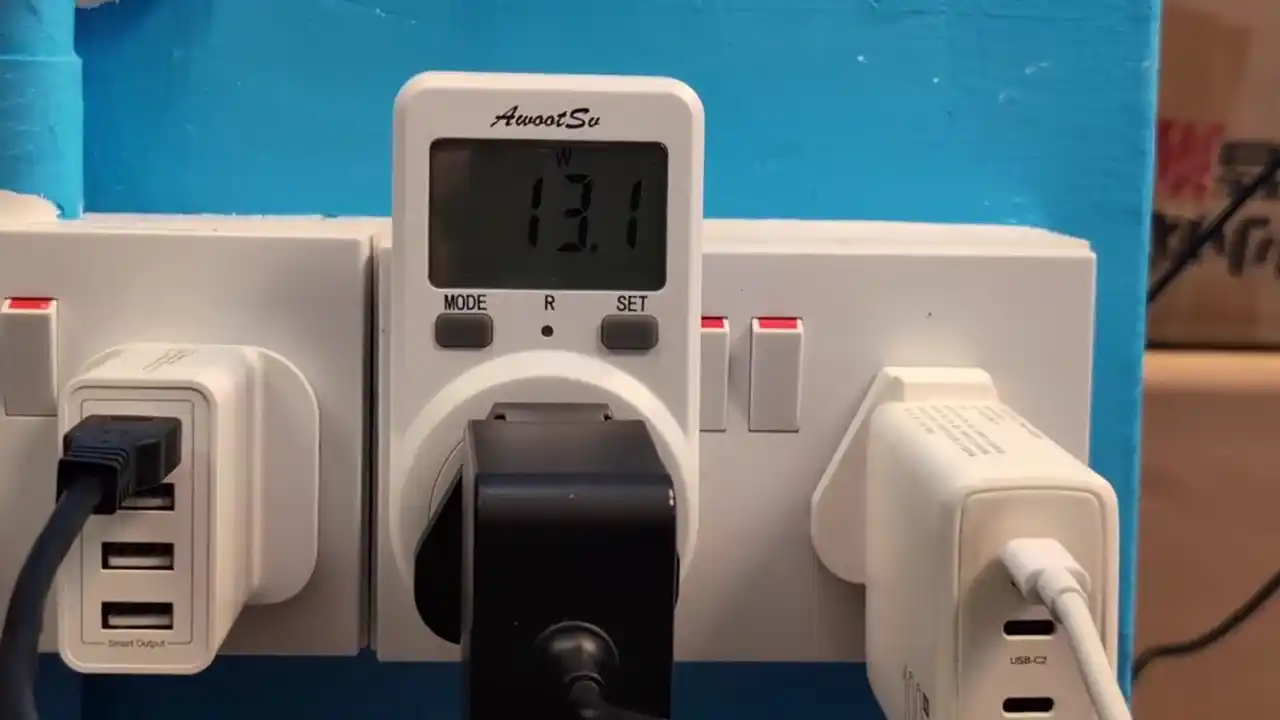 |
 |
BIOS-level tuning is possible and can slightly reduce power draw or adjust fan thresholds, but no advanced power scaling or fan curve customization is exposed via software in stock OS images. More demanding operating systems like TrueNAS Scale ran stably on the G9 but did little to mitigate thermal behaviour, reinforcing the importance of user-added SSD heatsinks regardless of OS.
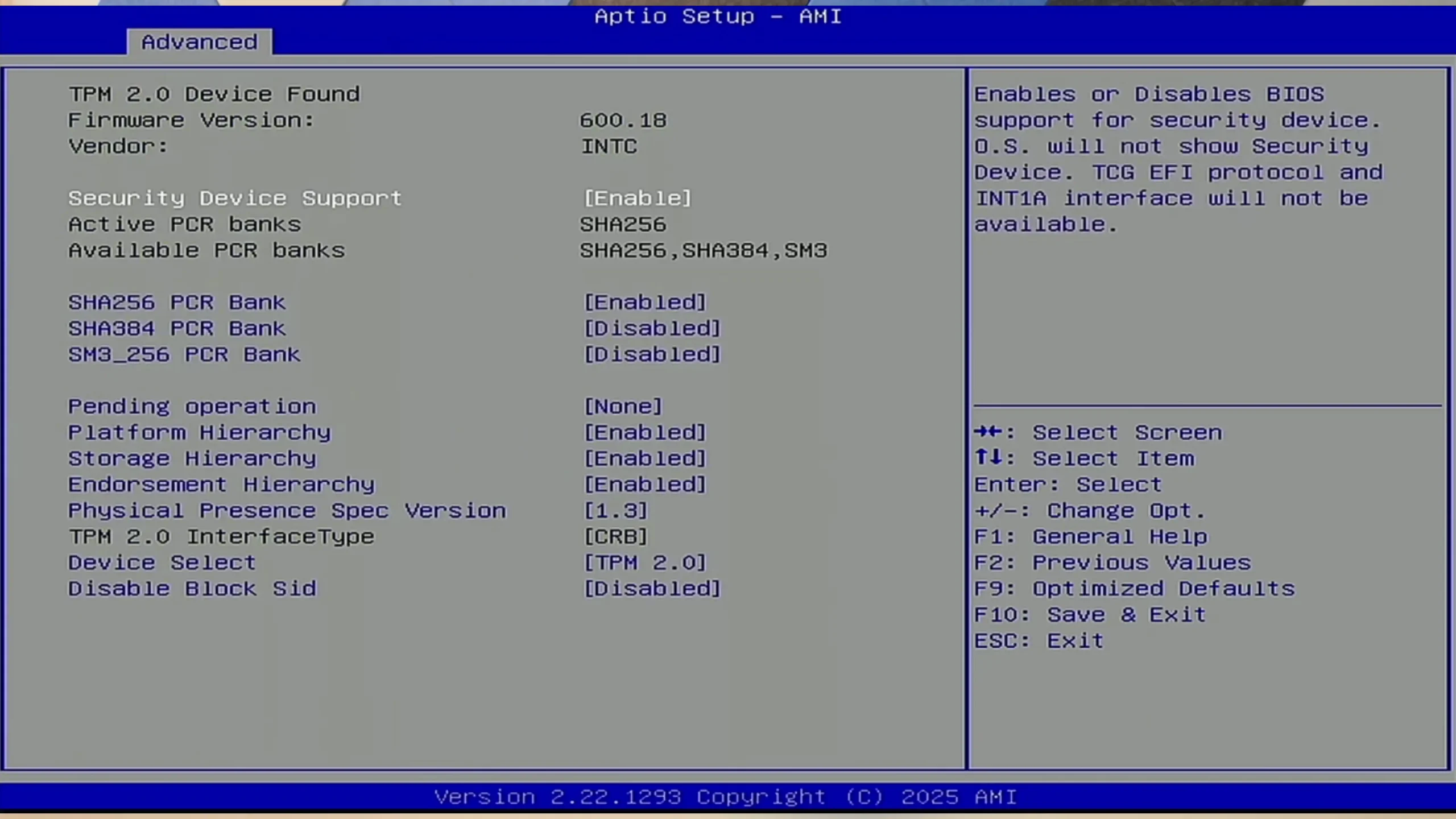
The lack of thermal sensors per SSD slot or fan feedback control means sustained operations should be closely monitored in hotter climates or enclosed environments.
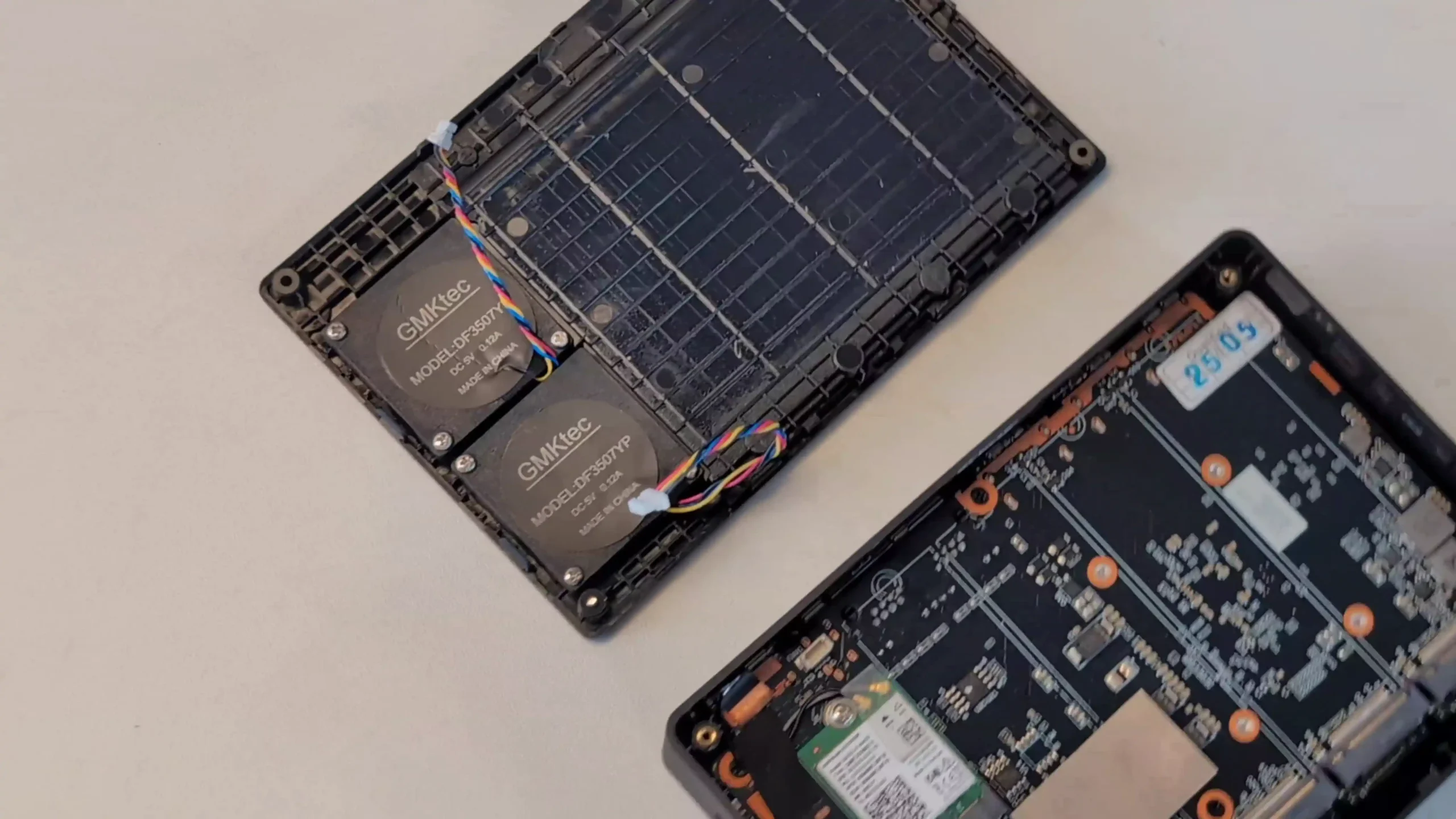
Nowhere is the conversation about thermal and hardware design more relevant than in comparison to the Xyber Hydra, a near-identical system that appears to share much of its component sourcing with the G9—right down to the GMK-branded fans. The Hydra ships with 16GB of DDR5 memory, a metal base panel, and most notably, a thermal pad that bridges SSDs to the metal shell, allowing for actual heat transfer rather than passive convection. In direct tests, the Hydra consistently posted 5–10°C lower SSD temps under identical workload, with idle SSDs (no heatsinks) registering around 47–49°C versus 56–57°C in the improved G9.
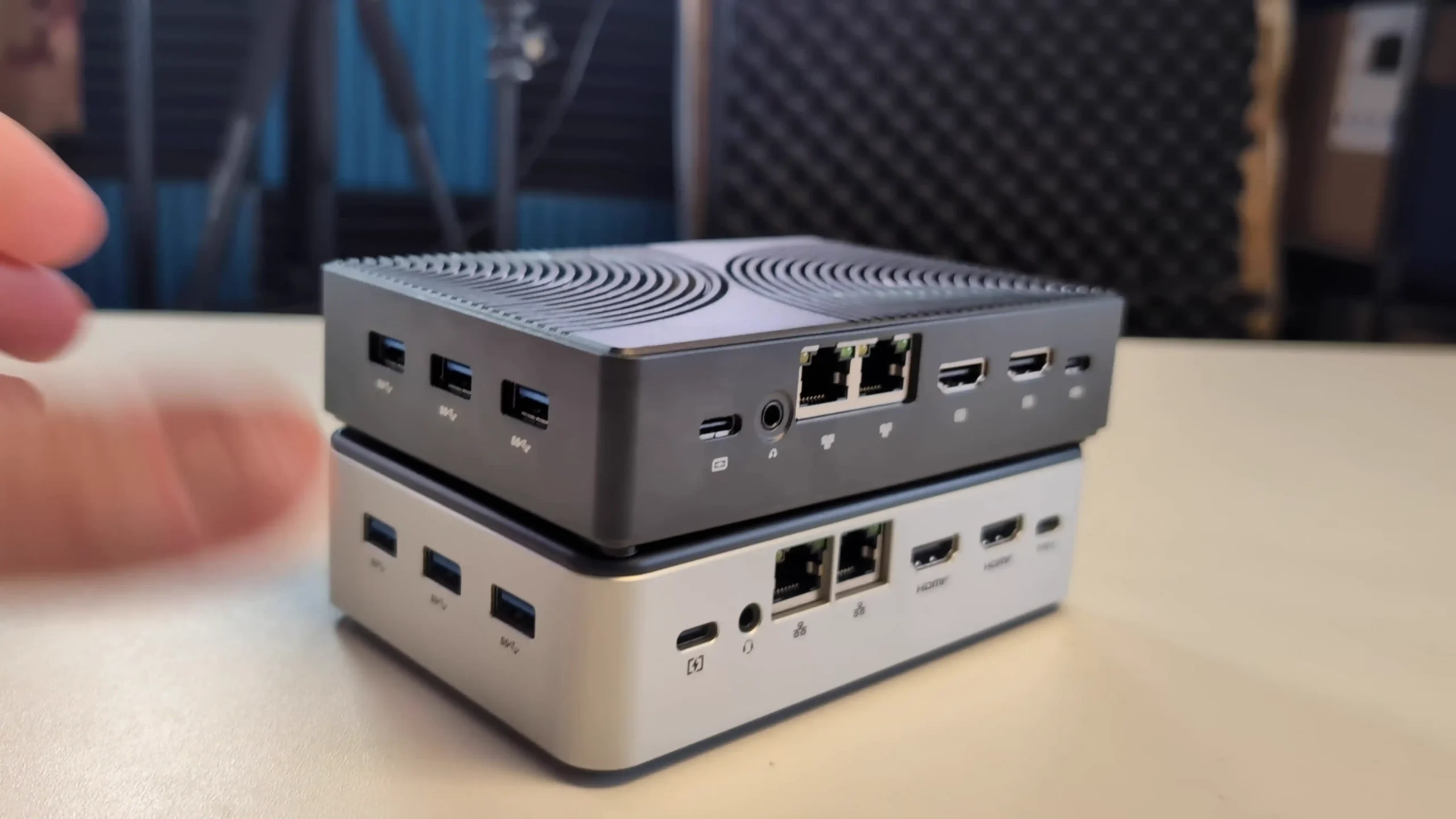
Though the Hydra lacks branding clarity around its manufacturer, the design appears to be what the G9 should have evolved into: same layout and CPU, but better thermals, more memory, and more thought put into SSD dissipation. In conclusion, while the improved GMKTec G9 offers better thermals than its predecessor, the Xyber Hydra outperforms both G9 variants in every thermal category, making it the superior choice if cooling and memory capacity are priorities.
| Metric | Original G9 | Improved G9 | Xyber Hydra |
|---|---|---|---|
| Peak Read Speed (NVMe) | ~1.4–1.5 GB/s | Same | Same |
| Sustained Write Speed | ~400–500 MB/s | Slightly higher | Slightly higher |
| Idle CPU Vent Temp | 54–56°C | 50–52°C | 47–49°C |
| SSD Temps (No Heatsink) | 66–67°C | 56–57°C | 47–49°C |
| Rear I/O Temp | 55–57°C | 48–50°C | 44–46°C |
| Power Usage (Idle/Load) | 19W / 30W | 19–21W / 30W | 18W / 28W |
| Noise Level (Max) | ~39–40dB | Same | Slightly lower |
| Thermal Pad/Metal Contact | None | None | Yes (Metal Base) |
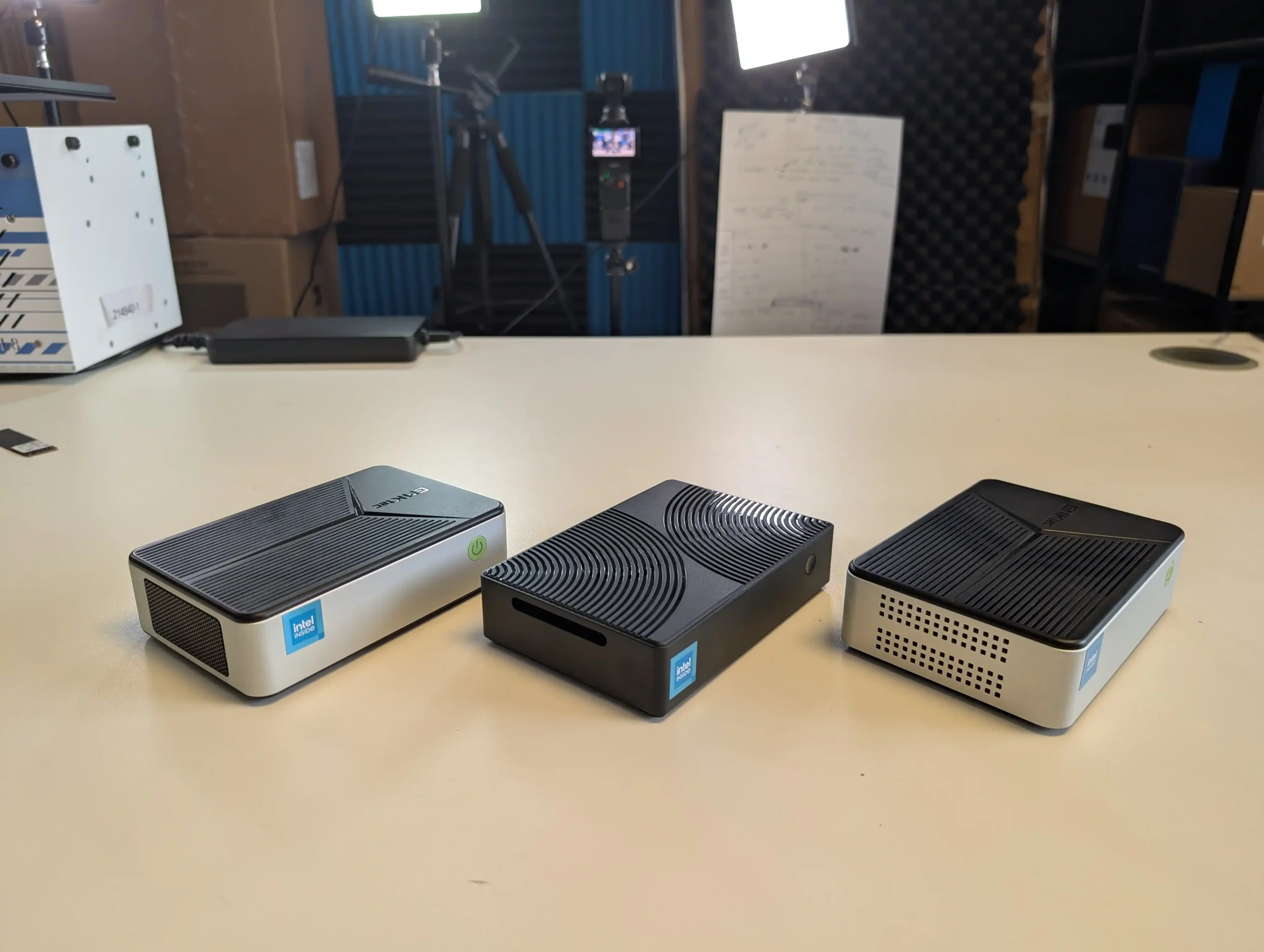
GMKTec G9 Ver.2 NAS Review – Verdict and Conclusion
The GMKTec G9, in its improved form, shows that the brand has listened—albeit cautiously—to thermal concerns raised by users and reviewers of the original model. The changes introduced in this updated version are minimal but measurable: better ventilation on the top panel and side mesh grille allow modest airflow gains, which result in lower surface and SSD temperatures across the board. Yet, GMKTec has stopped short of making any internal or structural upgrades that would more directly resolve thermal issues, such as introducing a metal baseplate, bundling SSD heatsinks, or adjusting the system’s internal fan architecture. All other hardware elements—CPU, memory, SSD configuration, I/O, BIOS, and software readiness—remain identical. As a result, while the device performs better in heat dissipation than before, it does so by a margin that may not justify an upgrade for existing G9 users. First-time buyers, however, may find it to be a safer choice now—particularly when paired with aftermarket heatsinks and used in moderate workloads.

However, the presence of the Xyber Hydra in the same price bracket poses a critical challenge to the G9’s value proposition. Offering the same N150 CPU, more memory, and a far superior thermal design with an integrated metal heat-spreading base, the Hydra addresses nearly every lingering complaint about the G9 without altering the system’s core layout. For prospective buyers deciding between the two, the G9’s only advantages now lie in its wider availability, slightly more recognizable branding, and marginally more mature firmware support. If those factors matter less than thermal reliability, long-term SSD health, and RAM headroom, then the Hydra is the more complete solution. Ultimately, the improved GMKTec G9 is a more stable and better-performing version of its former self, but its restrained upgrades feel like a missed opportunity in a market where near-clones have already moved ahead in meaningful ways.
Where to Buy?
|
| PROs of the GMKTec G9 NAS | CONs of the GMKTec G9 NAS |
|
|
 SUBSCRIBE TO OUR NEWSLETTER
SUBSCRIBE TO OUR NEWSLETTER 
[contact-form-7]
 Join Inner Circle
Join Inner Circle Get an alert every time something gets added to this specific article!
 Subscribe
Subscribe
This description contains links to Amazon. These links will take you to some of the products mentioned in today's content. As an Amazon Associate, I earn from qualifying purchases. Visit the NASCompares Deal Finder to find the best place to buy this device in your region, based on Service, Support and Reputation - Just Search for your NAS Drive in the Box Below
Need Advice on Data Storage from an Expert?
Finally, for free advice about your setup, just leave a message in the comments below here at NASCompares.com and we will get back to you. Need Help?
Where possible (and where appropriate) please provide as much information about your requirements, as then I can arrange the best answer and solution to your needs. Do not worry about your e-mail address being required, it will NOT be used in a mailing list and will NOT be used in any way other than to respond to your enquiry.
[contact-form-7]
Need Help?
Where possible (and where appropriate) please provide as much information about your requirements, as then I can arrange the best answer and solution to your needs. Do not worry about your e-mail address being required, it will NOT be used in a mailing list and will NOT be used in any way other than to respond to your enquiry.
[contact-form-7]
 Ko-fi or old school Paypal. Thanks!To find out more about how to support this advice service check HEREIf you need to fix or configure a NAS, check Fiver
Have you thought about helping others with your knowledge? Find Instructions Here
Ko-fi or old school Paypal. Thanks!To find out more about how to support this advice service check HEREIf you need to fix or configure a NAS, check Fiver
Have you thought about helping others with your knowledge? Find Instructions Here

|
 |

